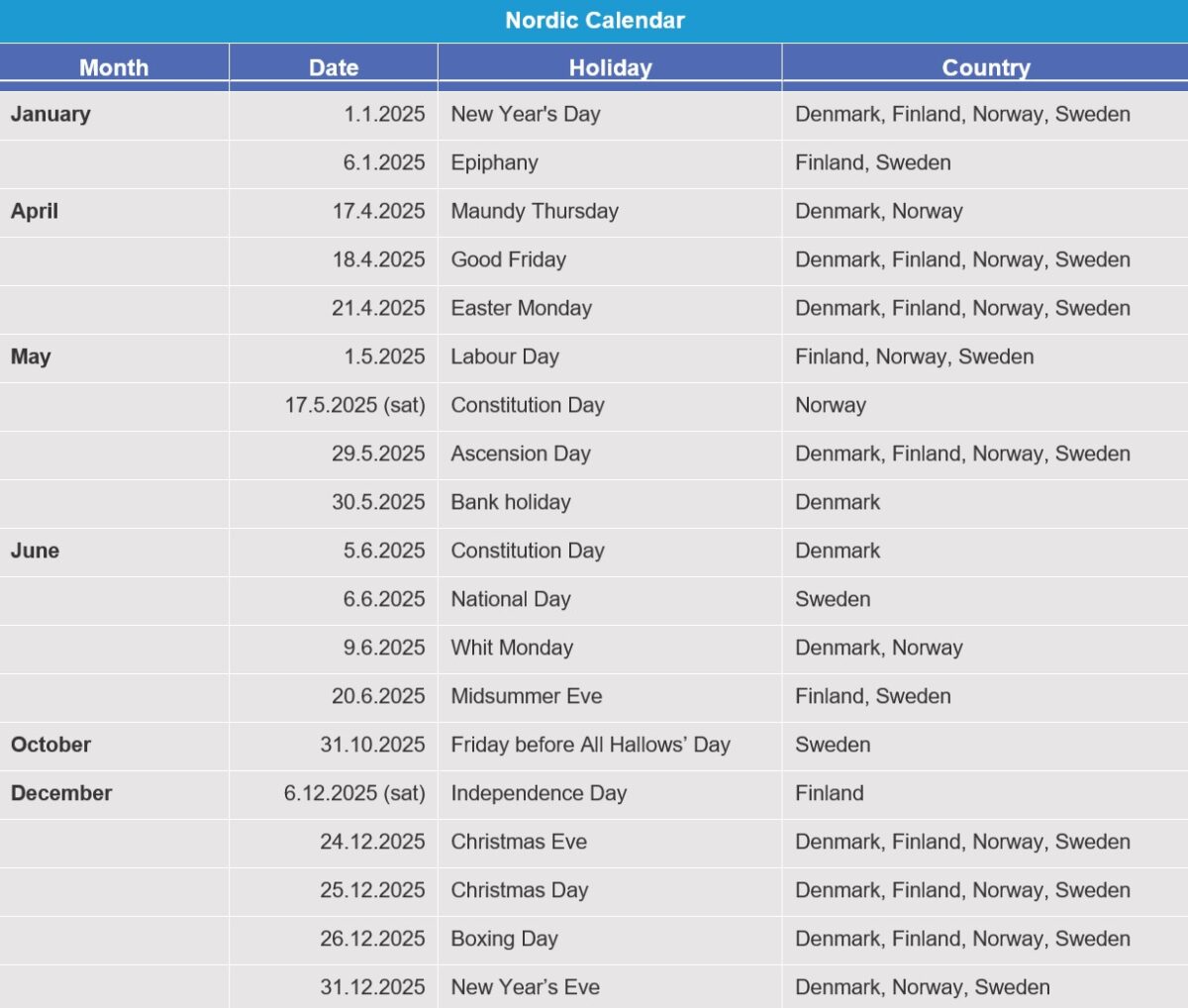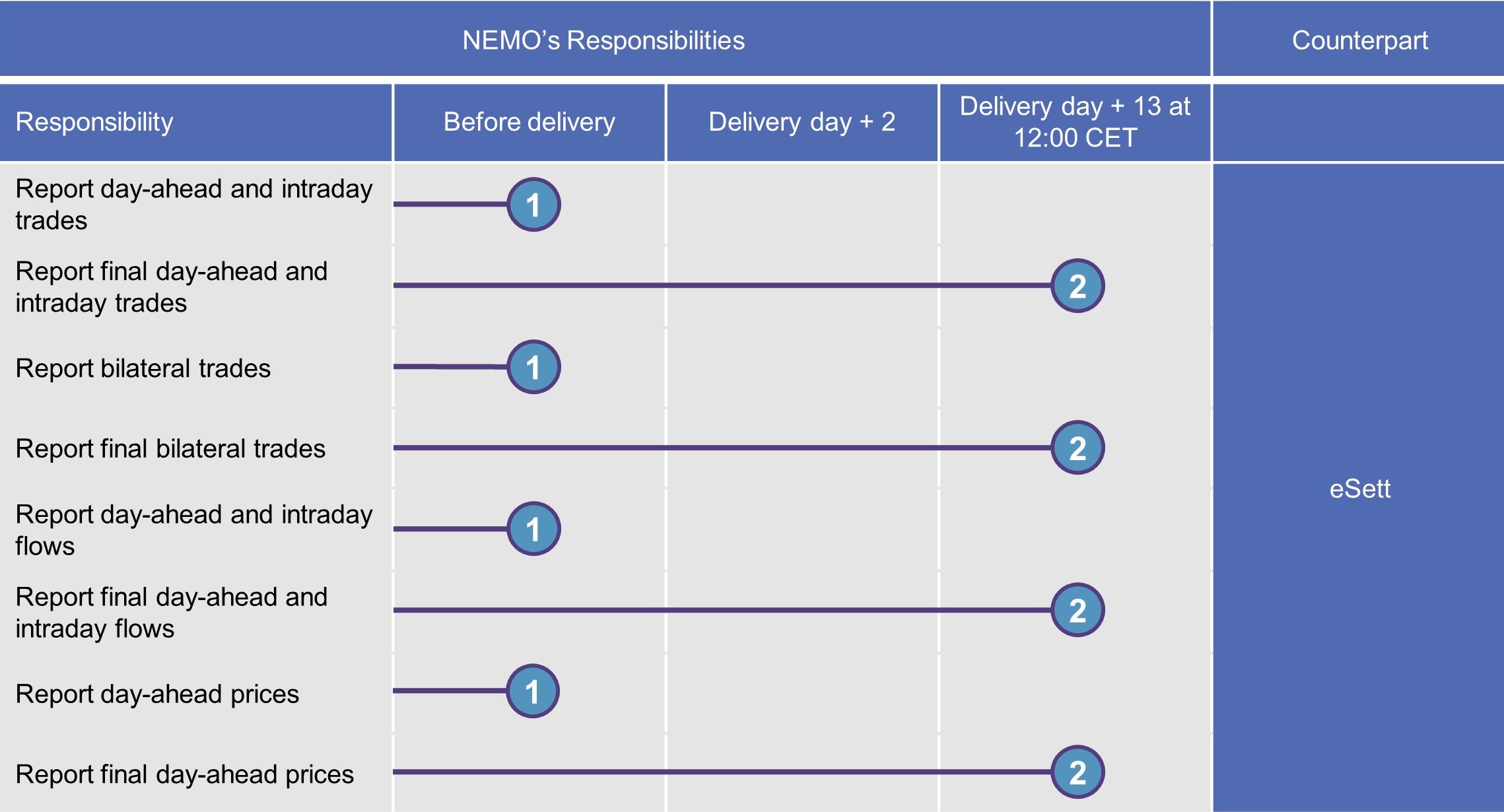
Handbook
Our handbook provides a comprehensive overview to the Nordic Imbalance Settlement Model from the market participant’s perspective. There are also available the unofficial translations of Handbook in Finnish, Norwegian and Swedish
Downloadables
The newest version of the NBS Handbook (version 5.1) has been updated in May 2025.
There must always be a balance between supply and consumption of electricity. To achieve this, the Transmission system operators (TSOs) use balancing power procured from the balancing power market. Imbalances arise from uncertainties in plans and from failures in generation, consumption and the grid. Imbalance settlement is therefore a necessary function in a commercial electricity market. Historically, Fingrid, Svenska kraftnät, Statnett and Energinet each have been operating their own imbalance settlement and been responsible for supervising the balance of the electricity systems in Finland, Sweden, Norway and Denmark respectively.
Today eSett Oy (Imbalance Settlement Responsible, ISR) organisation is responsible for performing imbalance settlement and invoicing BRPs for imbalances and BSPs for balancing services. eSett Oy (eSett) is owned by the four TSOs; Energinet, Fingrid, Statnett and Svenska kraftnät with an equal share.
Each TSO is still responsible for national settlement in accordance with the national regulations and for verifying that the Imbalance Settlement Model and eSett fulfil such regulations.
The model provides harmonised operational preconditions for all Nordic balance responsible parties, regardless of the country or market balance area. Nordic-level business processes for reporting, performing settlement, invoicing and collateral management are established. Consequently, similar rules and standards for information exchange are created.
This Nordic Imbalance Settlement Handbook compiles all the Instructions and Rules into one easily accessible source. It is the main source of information needed for each market participant to understand their role and responsibility in the settlement process. A market participant can have several roles in the Imbalance Settlement Model (e.g. a TSO can have roles as a BRP, BSP, RE and DSO).
One of the most important goals of the Handbook is to provide information about the Imbalance Settlement Model in a structured and understandable way so that all market participants can work equally in the electricity market in all Nordic countries. Inevitably, some national differences will remain, and it may not be possible to harmonise these in the short term. Therefore, the national regulations are an important source of information, in addition to this Handbook. This Handbook also includes references to the information sources to national regulations.
New versions of the Handbook will be published on a regular basis. The market participants will be informed about the updated Handbook on the web site and by newsletter that the market participants can subscribe to on www.eSett.com.
A Customer Committee is established to provide a dialogue between eSett and stakeholders. The Customer Committee consists of market representatives and a TSO representative from each NBS Country. In addition, the energy market authorities responsible for regulation approval and execution from all NBS countries can participate in the meetings. All the major changes to the NBS model will be discussed in the Customer Committee before they are implemented. Therefore, the Customer Committee has an important role in the development of the NBS model. The changes and updates to the NBS model will be recorded in the NBS Handbook.
The normal update cycle of Handbook will be twice a year, once in the spring and once in the autumn. However, eSett reserves the right to carry out small updates and clarifications to the NBS Handbook when these changes have an urgent nature and they are clearly seen to be beneficial to the market and/or when the update adds clarity to the processes described in the Handbook. All change will be summarised in the change log available at the end of this document (see Chapter 12).
In addition to the Handbook the following sources include information which is to be taken into account by the market participants are:
- Common rules in the electricity law and secondary legislations in Denmark, Finland, Norway and Sweden as referred to in Chapter 1.4 Regulation
- User Guide for XML documents for NBS; a detailed user guide for the ENTSO-E and ebIX® XML documents used in the Nordic Balancing System, available at https://ediel.org/
- BRS (Business Requirement Specification for Data Exchange in Nordic Balance Settlement); a technical specification for the ENTSO-E and ebIX® XML documents used in the Nordic Balancing System, available at https://ediel.org/
- NBS XML schemas and examples on https://ediel.org/
- NBS related acknowledgements are according to NEG UserGuide Acknowledgements at https://ediel.org
- Communication guidelines for the Imbalance Settlement System at https://www.esett.com/customers/data-communications/
- BRP Agreements at https://www.esett.com/customers/agreements/
The main function of the Nordic Imbalance Settlement Model is the common imbalance settlement. eSett performs imbalance settlement and manages invoicing and collaterals towards the Balance Responsible Parties (BRP) and Balance Service Providers (BSP) on behalf of the Transmission System Operator (TSO) in each country. All matters directly related to system operations, for example procurement of balancing services, are outside the scope of the Imbalance Settlement Model. The Imbalance Settlement Model will take all necessary volumes into account when calculating the imbalance and furthermore, eSett is responsible for invoicing of the balancing services as part of imbalance settlement.
The model includes several benefits for the electricity market. The Nordic Imbalance Settlement is the platform for common imbalance settlement in Denmark, Finland, Norway and Sweden. This means that a BRP always has a single interface (eSett) and one set of rules when settling its imbalances in the Nordic electricity market. The main reason for establishing a common imbalance settlement solution is the creation of a competitive end user market. Increased competition and reduced margins for the electricity providers will give rise to socioeconomic efficiency gain.
Competition through a common Nordic retail market is considered essential in order to ensure high quality services at the lowest price, to stimulate innovation and to maximise social welfare in the Nordic region.
In general, the Nordic Imbalance Settlement Model will lower the threshold of acting as a BRP since the model enables common access to all four countries. In addition, the operational procedures of a BRP are simplified. It makes it easier for a retailer to enter the market. It also reduces costs as more BRPs are competing and the price for handling an RE’s balance could therefore be lower. Besides, a RE can more easily choose to act as a BRP rather than an RE.
The Nordic Imbalance Settlement Model gives an incentive to improve the quality of meter data as the DSOs must notify and be responsible for data errors after the imbalance settlement period is closed. Improved data quality will not only improve the quality of imbalance settlement but, also the settlement and invoicing of end customers as both BRPs and REs get access to the same meter data.
A larger market with a common set of rules will make it more attractive to invest in innovation. BRPs, BSPs and REs will face a larger potential for innovative solutions, especially for the core IT systems and new payment and credit management solutions. This will also make the vendor market more attractive as the offers from various service providers will cover a larger market.
A common Nordic approach to imbalance settlement procedures will have more influence on EU development than if there were several different Nordic solutions. NBS will, in the long run, lower the operational costs of imbalance settlement because one organisation with one common IT solution will be more efficient than several separate ones. NBS will also make the related costs more transparent as these will be separated from cost elements at each respective TSO. Such transparency is a condition for operational cost efficiency.
The national legislation and regulations per each respective country are presented in this chapter.
The Nordic Imbalance Settlement model follows the settlement principles as per Title V of Commission Regulation (EU) 2017/2195 of 23 November 2017 establishing a guideline on electricity balancing.
https://eur-lex.europa.eu/legal-content/EN/TXT/?uri=CELEX%3A32017R2195
In Finland, the following laws and secondary regulations guide the electricity market:
- Electricity market act (EMA) (588/2013) (Finnish version) Common rules in the electricity law and secondary legislations in the Nordic countries provide additional https://finlex.fi/fi/lainsaadanto/2013/588
- Decrees of the Finnish government and decrees of the ministry of the employment and the economy:
- The Finnish Government decree of electricity deliveries settlement and measurement (767/2021) (dated 2021-08-12) https://finlex.fi/fi/lainsaadanto/2021/767
- The Ministry of the Employment and the Economy decree of the information exchange concerning electricity deliveries settlement (839/2021) (dated 2021-09-24) https://finlex.fi/fi/lainsaadanto/saadoskokoelma/2021/839
National terms and conditions for BRP concerning balance management and imbalance settlement: https://www.fingrid.fi/en/electricity-market/balance-service/
National terms and conditions for BSP concerning reserves and balancing power (separate for each balancing service): https://www.fingrid.fi/en/electricity-market/reserves_and_balancing/
In Norway the following laws and secondary regulations guide the electricity market:
- Primary act: LOV 1990-06-29 nr 50: Lov om produksjon, omforming, overføring, omsetning, fordeling og bruk av energi m.m. (energiloven) – ”The Energy Act”
https://lovdata.no/dokument/NL/lov/1990-06-29-50 - Secondary Legislation: FOR 1999-03-11 nr 301: Forskrift om måling, avregning og samordnet opptreden ved kraftomsetning og fakturering av nettjenester – ”MAF”
https://lovdata.no/dokument/SF/forskrift/1999-03-11-301
National terms and conditions for BRP concerning balance management and imbalance settlement: https://www.statnett.no/for-aktorer-i-kraftbransjen/systemansvaret/kraftmarkedet/avregningsansvaret/balanseavregning/
National terms and conditions and agreement for BSP concerning reserves and balancing power: https://www.statnett.no/for-aktorer-i-kraftbransjen/systemansvaret/kraftmarkedet/reservemarkeder/leverandor-av-balansetjenester-bsp/
In Sweden the following laws and secondary regulations guide the electricity market:
- Energy market act: SFS 1997:857 ”Ellag” http://www.riksdagen.se/sv/dokument-lagar/dokument/svenskforfattningssamling/ellag-1997857_sfs-1997-857
- Power regulation: ”Förordning om mätning, beräkning och rapportering av överförd el” regeringen.se
- Secondary legislation: EIFS 2023:1 https://ei.se/download/18.575c50c318602a42957643/1675150192171/EIFS-om-m%C3%A4tning-ber%C3%A4kning-och-rapportering-av-%C3%B6verf%C3%B6rd-el-EIFS-2023-1.pdf
National balance responsibility agreements for BRP: https://www.svk.se/en/stakeholders-portal/electricity-market/balance-responsibility/balance-responsibility-agreement/
National balance responsibility agreements for BSP: https://www.svk.se/en/stakeholders-portal/electricity-market/balancing-service-provider-bsp/bsp-agreement/
In Denmark the following laws and secondary regulations guide the electricity market:
- The electricity Supply Act (Lov om elforsyning, LBK nr 1248 af 24/10/2023):
https://www.retsinformation.dk/eli/lta/2023/1248 - Executive order on the system operator and use of the electricity transmission network (Systemansvarsbekendtgørelsen, BEK nr 1358 af 24/11/2023)
https://www.retsinformation.dk/eli/lta/2023/1358 - Secondary legislation in the Danish electricity market regulations (approved by the Danish Utility Regulator):
https://energinet.dk/regler/el/elmarked/
eSett is owned by Energinet, Fingrid, Svenska kraftnät and Statnett. The company will act and operate in the role of Imbalance Settlement Responsible. It must be noted that the national regulations stipulate that each national TSO is still ultimately responsible for balancing operations and imbalance settlement.
The company’s working language is English but customer service is also provided in Swedish, Norwegian and Finnish. eSett’s relations to the market participants are illustrated in Figure 1.
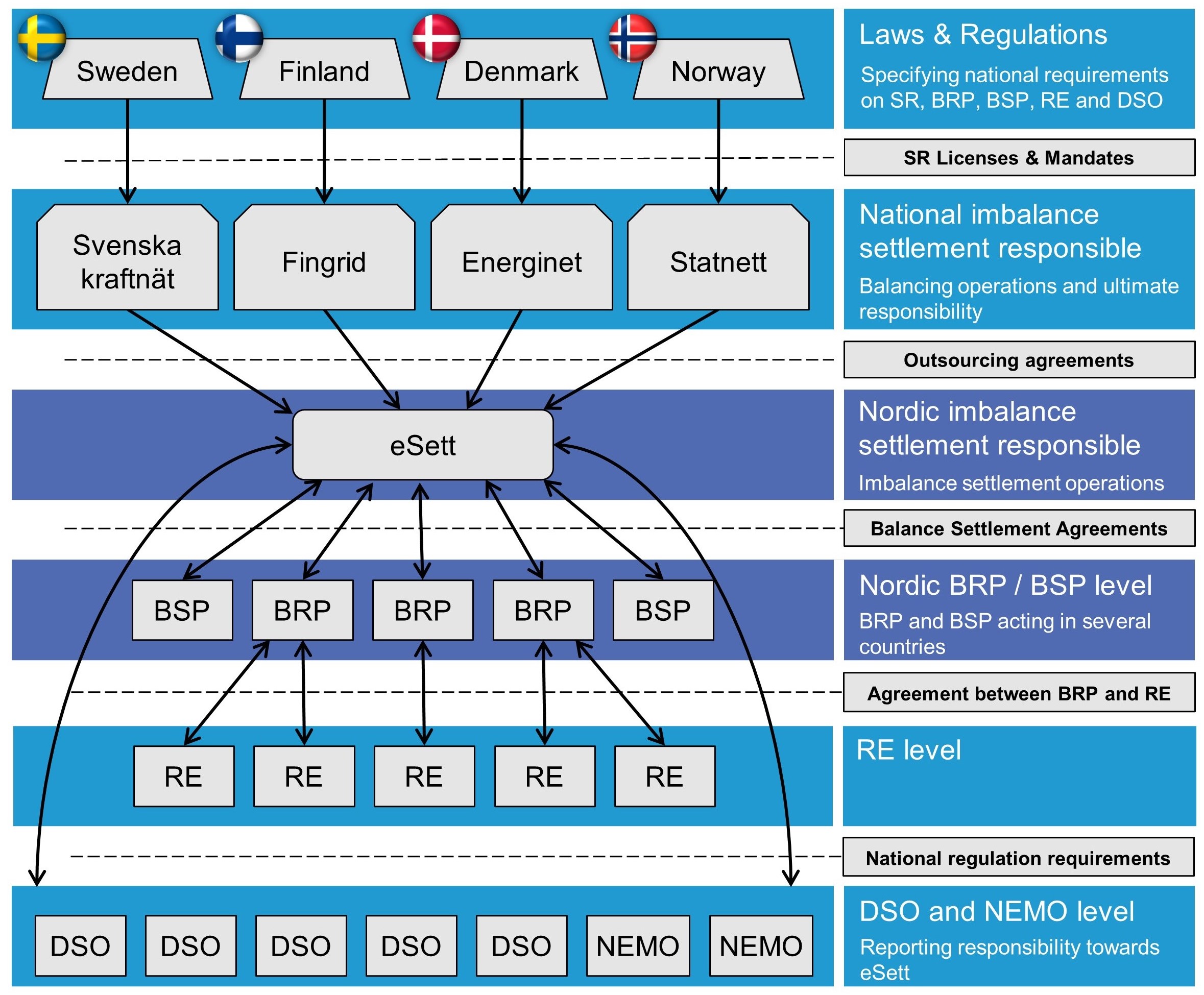
Figure 1. Relations between eSett and the market participants.
eSett has many operational tasks. Its daily processes include collecting, validating and managing data related to imbalance settlement, making the collected data available for market participants, conducting preliminary imbalance settlement, following up reported data and performing final imbalance settlement. Weekly duties for eSett consist of performing the imbalance settlement related invoicing, invoicing of other fees on behalf of TSOs, controlling BRPs’ and BSPs’ collaterals and follow-up them in relation to risk and collaterals, and cash management. On a regular basis eSett will monitor, publish and follow-up Key Performance Indicator (KPIs) of the imbalance settlement process. eSett does market monitoring, customer support, reporting, and publishing of settlement results (including input data) continuously.
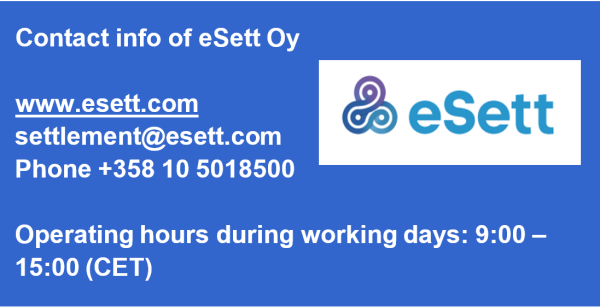
The purpose of imbalance settlement is to establish a financial balance in the electricity market after the operation hour. Imbalances are calculated for each BRP based on the PX market trades, bilateral trades and on realised consumption and production. Each BRP is financially liable for the imbalances under its responsibility, balanced by the balancing power procured from the balancing power market operated by the TSOs.
In the imbalance settlement, estimates for the profiled consumption are used. In the reconciliation settlement, the difference between preliminary and final profiled consumption is settled using day-ahead market prices for the MBA. In this way, the error in the imbalance settlement due to incorrect estimates of the profiled consumption is corrected.
Transmission System Operators (TSOs) procure balancing services from Balancing Service Providers (BSPs) to manage the real-time coordination of supply and demand in the power system. In the Balancing Service settlement the balancing capacity and balancing energy are financially compensated between the TSOs and the BSPs, and possible regulation imbalances are calculated for each BSP based on the differences between activated and delivered reserves.
The Nordic Settlement Model is based on the harmonised model with single imbalance which is calculated and settled. At the core of the Nordic Imbalance Settlement Model is the common operational unit (eSett) which is responsible for the imbalance and balancing service settlement as well as for the reconciliation settlement in Sweden. eSett performs services on behalf of the four TSOs.
The imbalance settlement agreement is a legal contract that defines eSett’s and the BRP’s liabilities, the BRP’s collateral requirements and procedures for exclusion, and the legal items. The balancing service settlement agreement is a legal contract that defines eSett’s and the BSP’s liabilities, the BSP’s collateral requirements and procedures for exclusion, and the legal items. The main stakeholders in the Nordic Settlement Model are the Retailers (REs), the Balance Responsible Parties (BRPs), the Distribution System Operators (DSOs), the Balancing Service Providers (BSPs), the Transmission System Operators (TSOs), Nominated Electricity Market Operators (NEMOs), and eSett. The definitions of these stakeholders are presented in the list of terminology at the beginning of this Handbook.
The different procedures and operations of the Nordic Imbalance Settlement Model are divided into five core functions: settlement structure management, metering and reporting data, settlement, invoicing and reporting.
In addition, the Nordic Settlement Model includes separate functions for collateral management and market behaviour monitoring.
The Nordic Settlement Model ensures a transparent and common imbalance settlement and equal treatment of market participants. The main objective of the Nordic Settlement Model is to perform settlement across participating countries with the same principles and based on a single balance. The model provides harmonised and necessary procedures for the settlement:
- Settlement structure defines how the information about the imbalance settlement structure and hierarchy (relations) is collected and managed, e.g. information about a new Metering Grid Area (MGA) or the contact information of a market participant. See Chapter 3, Settlement structure management
- Metering defines the different data types and the basis of the settlement data metering. See chapter 4, Metering
- Reporting data handles the imbalance settlement data reception, validation, storing and reporting by eSett. See chapter 5, Settlement data reporting
- Settlement handles the imbalance settlement calculations, quality assurance and publishing of results. See chapter 6, Settlement
- Invoicing handles eSett’s invoicing of BRPs, based on realised imbalances and BSPs based on balancing services. See Chapter 8 Invoicing
- Reporting includes the creation, distribution and publishing of various reports and files provided by eSett. Reporting is also done through the Online Service, the Messaging Service and the Information Service that are provided to market participants. See Chapter 5, Settlement data reporting
- Collateral management includes control of the BRPs’ and BSPs’ collateral demands, as defined and calculated by eSett, as well as follow-up of the placed collateral deposits in comparison to demands. See Chapter 9, Collateral and risk management
- Communication presents different communication channels and an arrangement of the communication in Nordic Settlement model. It also includes the creation, distribution and publishing of various reports and files provided by eSett. Reporting is also done through the Online Service, the Messaging Service and the Information Service that are provided to market participants. See Chapter 10, Communication
- Market behaviour monitoring is based on the analysis of the BRPs’ imbalances. These are analysed by calculating a set of KPIs, which show the BRPs market performance (e.g. quality of reported data, reporting frequency, relative imbalances, absolute imbalances and imbalance costs per unit). The quality of DSOs reporting will also be monitored. See Chapter 11, Market behavior reporting
- Market analysis refers to an evaluation of the electricity market dynamics from the settlement perspective. The analysis aims to ensure the accuracy and efficiency of settlement, identify trends, and provide insights for owners, stakeholders and for improving market operations.
All functions in the settlement model are described in Figure 2 below.
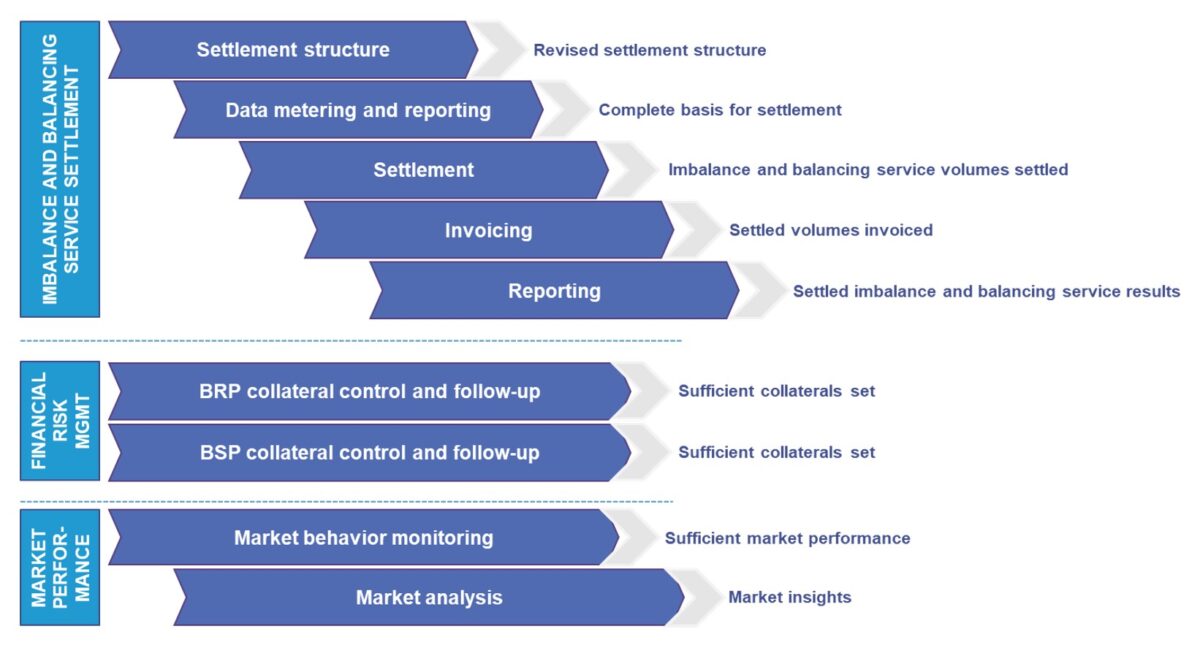
Figure 2. The Imbalance Settlement and Balancing Service Settlement Model functions.
The Reconciliation Settlement Model ensures a transparent and common reconciliation settlement and equal treatment of market participants. eSett handles the reconciliation settlement only for Sweden, and this applies only for BRPs and DSOs in Sweden that have BRP level profiled consumption. The main objective of the Reconciliation Model is to provide profiled consumption data for imbalance settlement, and settle the difference between preliminary and final profiled consumption using day-ahead market prices for the MBA.
- Settlement structure defines how the information about the settlement structure and hierarchy (relations) is collected and managed, e.g. information about a new Profiled Consumption MEC or the contact information of a market participant. See Chapter 3, Settlement structure management
- Input Data defines the different data types and the basis of the reconciliation settlement data metering. See chapter 5.1, Swedish Profiling
- Reporting data handles the imbalance settlement data reception, validation, storing and reporting by eSett. See chapter 5, Settlement data reporting
- Settlement handles the profiled consumption and reconciliation settlement calculations, quality assurance and publishing of results. See chapter 6, Settlement Calculation
- Invoicing handles eSett’s invoicing of BRPs, based on differences between profiled consumption in the imbalance settlement and final monthly metered consumption. See Chapter 8, Invoicing
- Communication presents different communication channels and an arrangement of the communication in Nordic Settlement model. It also includes the creation, distribution and publishing of various reports and files provided by eSett. Reporting is also done through the Online Service and the Messaging Service that are provided to market participants. See Chapter 10, Communication

Figure 3. The Reconciliation Settlement Model functions.
The details regarding the model and data communication are available in the Svensk Elmarknadshandbok and in the Edielportalen.
- Svensk Elmarknadshandbok: https://www.elmarknadshandboken.se/
- Edielportalen: https://www.ediel.se/Info/edielanvisningar
The main stakeholders (i.e. market participants) in the Nordic Settlement Model along with the related roles and responsibilities are presented in the sections below. The validity of a market participant (i.e. the time frame within which the market participant is considered to be active in the market) shall be set after the required documents have been received by eSett. There are gate closures before a new market participant can be active in the Nordic market and they are presented in Table 6 in this document.
eSett is responsible for the financial settlement of imbalances in accordance with the imbalance settlement agreement and the Handbook:
- Collecting and maintaining the imbalance settlement structure
- Performing the imbalance settlement and invoicing/crediting the BRPs for the balancing power
- Invoicing/crediting the BSPs for the balancing services
- Setting the collateral levels so that they cover the imbalance settlement related risk exposure
- Collecting and monitoring the BRP´s and BSPs collaterals and taking necessary action to adjust collaterals when needed
- Collecting fees from BRPs and BSPsto cover:
- Balance management and settlement costs of the TSOs
- A share of the reserve costs and related operational costs for the TSOs
- Monitoring imbalances and assessing whether they are in accordance with published guidelines and regulations
- Operating and providing an imbalance settlement IT solution available for the market participants can use to access and report settlement data
- Report and publish imbalance settlement data including statistics, KPIs and other market information
The TSOs have the ultimate responsibility to supervise the physical balance of the electricity system and to take actions in order to rebalance the system.
- Balancing the production/import with the consumption/export during the delivery day to meet the overall demand of a system frequency at 50 Hz
- Calculating imbalance adjustment volumes per imbalance settlement period and determining imbalance prices
- Submitting necessary information per BRP and per BSP to eSett for the imbalance settlement; e.g. production plan and procured balancing services during the imbalance settlement period
- Acting as the financial counterparty towards the BSP for all reserve capacity allocation (eSett is the financial counterparty for the corresponding activated reserves related to the imbalance settlement)
- Reporting to eSett the structural information of MBA, MGA and the relation between them.
A DSO is a grid operator with the responsibility to connect producers and consumers to its grid. The DSOs have the responsibility to meter production, consumption, and exchange with other grids and to report the metered data to the entitled parties. This includes closed distribution system operators. The DSO has several obligations in relation to imbalance settlement. Some of the DSOs’ responsibilities towards eSett can be transferred to separate Metered Data Aggregator, e.g. to a national hub. Role of Metered Data Aggregator is explained in chapter 2.3.9. The DSO’s responsibilities are as follows:
- Registering the REs’ metering points regarding production and consumption in the respective MGAs
- Operating the metering system and submitting the required metering data to the REs, BRPs, TSO and eSett¹
- Calculating and reporting load profile shares (according to national guidelines)
- Calculating the final profiled consumption and the reconciled energy when all metering for a grid area is completed (according to national guidelines, see sub chapter 6.8. Reconciliation)
- Imbalance corrections, after the imbalance settlement reporting is closed, shall be settled between the DSO and RE. The exact procedure for settlement of imbalance corrections will be developed by the energy industry in each country.
This kind of metering responsible party can be a party having DSO network licence or closed network licence or is registered as a metering responsible. If there is not a clear responsible participant for metering and reporting settlement data of the special metering grid areas (e.g. production or industrial metering grid areas) then a balance responsible party or an open supplier for this metering grid area is responsible for metering and reporting imbalance settlement data. These metering responsibles shall have a role as a DSO in the Nordic Imbalance Settlement.
All Finnish DSOs in the Nordic Imbalance Settlement need to register their own metering grid areas to Fingrid as a TSO.
In Sweden, market participants that have a concession for a line or area have to be approved by the National Energy Authority in order to have a role as a DSO.
In Norway, a trading licensee who owns a transmission grid or is responsible for network services can have a role as DSO. Network services are defined as one or more of the following:
1. transmission of power, including operation and maintenance of and investment in grid installations
2. tariffing
3. metering, settlement and customer service
4. supervision and safety
5. co-ordination of operations
6. required contingency measures
7. required power system planning.
¹DSO’s have responsibility to report BRPs’ metering data to eSett. The responsibility is defined through the legislation and directives by the authorities in each country. eSett will have no duty nor practical possibility to ensure the correctness and completeness of the settlement information
A BRP is a market participant having a valid agreement with eSett and the TSO of the area of operation. The BRP’s responsibilities are defined in the balancing agreement, imbalance settlement agreement and in the Handbook:
- Having a valid imbalance settlement agreement with eSett and providing the required collaterals
- Planning balanced schedules on an hourly basis
- Submitting plans per RO to the TSO
- Submitting bilateral trade information to eSett and verifying the correctness of the bilateral trades submitted by its counterparts, also on RE level.
- Acting as the financial counterpart for the settlement of imbalances and reconciliation according to national guidelines
- Acting as the financial counterpart for the balancing services in case the BRP has also a BSP role
- Keeping the imbalance settlement structure information up to date
- Verifying all relevant data reported by eSett, and notify deviations
- Informing eSett of which REs that the BRP is responsible for, for consumption and production per MGA
A BRP that has a valid agreement with a TSO regarding balancing services, does automatically also hold the market role and obligations of a BSP (see chapter 2.3.5 Balance Service Provider (BSP)).
A BSP is a market participant having a valid agreement with eSett and the TSO of the area of operation. The BSP’s responsibilities are defined in the agreement(s) with TSO, agreement with eSett and in the Handbook:
- Having a valid agreement with eSett and providing the required collaterals
- If there is already a valid BRP agreement with eSett for the same business entity, there is no need for a separate BSP agreement.
- Acting as the financial counterpart for the balancing services if the BSP does not have also a BRP role
- Acting as the financial counterpart for the settlement of regulation imbalances according to national guidelines
- Submitting delivered reserves information to eSett or to the TSO as described in the national terms and conditions of the balancing services
- Keeping the imbalance settlement structure information up to date
- Verifying the correctness of the balancing services submitted to eSett
- Verifying all relevant data reported by eSett, and notify deviations
An RE is a market participant that for example sells electricity to final consumers, purchases production or performs trade activity. The RE’s responsibilities regarding imbalance settlement are as follows:
- All REs operating within the countries involved in Nordic Imbalance Settlement have to register to eSett according to the gate closure specified in Table 6.
- Having an agreement with a BRP for production and consumption in all MGAs where the RE is operating
- For Finland this requirement will be adapted in order to facilitate the chain of open suppliers. This model allows that an RE may have an agreement with a BRP, or with another RE who then has an agreement with a BRP. This is illustrated in Figure 4.

Figure 4. Handling the “chain of open delivery” in the Finnish market area.
- A RE can use one BRP for consumption and one BRP for production in the same MGA and use different BRPs in different MGAs, this division is highlighted in the following Figure 5 where Finland is used as an example.

Figure 5. An illustrated model of one Retailer using different BRPs per MGA
The responsibilities of a Nominated Electricity Market Operator, in its role as a power exchange and in regard to imbalance settlement are as follows:
- Reporting trade data for Day ahead – and Intraday trades (PX market trades) per RE and MBA to eSett (and TSO where needed)
- Reporting cross border trade (PX market flows) with other power exchanges (market coupling) to eSett and TSOs
- Reporting exchanges between NEMOs (Bilateral trades) per MBA to eSett
- In addition, Nominated Electricity Market Operator, in its role as power exchange, conducts market surveillance and reports any suspected breach of applicable regulations by the market participants to the national regulators
- Each NEMO may delegate the performance of tasks related to balance responsibility as laid down in the captioned Imbalance Settlement Agreement and Balance Agreement(s) to the Central Counter Party (CCP) of the NEMO.
- Keeping the trade data structure information up to date
- Verifying all relevant data reported by eSett, and notify deviations
A Service Provider provides operational balance management and settlement services for the market participants e.g. the BRPs, BSPs, REs and DSOs. According to the services provided for the market participants, the service provider has a right to perform the corresponding tasks towards eSett and the imbalance settlement system.
The service provider can for example provide services below:
- reporting and entering settlement data
- verifying calculated imbalances or
- handling collateral management on the online service on behalf of the market party.
One market party can have several Service Providers (a separate Service Provider for each category) and one Service Provider can serve several market parties.
A Metered Data Aggregator receives metered data from Distribution System Operator and reports aggregated values to eSett instead of DSO. National hubs act as Metered Data Aggregators for DSOs in their operating countries. If there is no national hub responsible for the metering grid area, DSO will aggregate its metered data and report it directly to eSett. Responsibilities of Metered Data Aggregator include:
- Registering the REs’ production and consumption MECs in the respective MGAs
- Receiving metered and profiled data and calculating of aggregated consumption and production time series per MGA
- Reports aggregated time series to eSett
The Nordic Settlement Model utilises a combined Nordic calendar, which consolidates the public national holidays from all involved countries. You can find the calendar on eSett’s homepage and in Appendix 2, Nordic Calendar. No invoicing shall be performed during a public holiday, and they will be taken into account in the terms of payment in settlement related invoicing. Also, no collateral shall be released during a public holiday.
As an example, if a certain day is considered as a public holiday in Sweden, it will also be considered a public holiday in all involved countries.
The Nordic Settlement Model will be operated in Central European Time (CET)/Central European Summer Time (CEST) and a 24-hour clock (10 o´clock in the evening will be written as 22:00) in operation (for example in invoicing and imbalance settlement), which is required to be supported by all market participants acting with eSett. The Nordic Imbalance Settlement Model will also use winter and summer time change, last Sunday in March will have 23 hours and last Sunday in October will have 25 hours.
The settlement structure management (e.g. retailer balance responsibility, RBR) will be complied with national legislations. In Finland, the settlement structures will be managed in Eastern European Time (EET)/Eastern European Summer Time (EEST) and in Sweden the settlement structures are managed in Swedish Normal Time (SNT). In Denmark and Norway Central European Time (CET)/Central European Summer Time (CEST) is used.
Participating as a BRP in the electricity market settled by eSett requires a valid Balance Agreement between the BRP and the respective TSO, as well as valid Imbalance Settlement Agreement between BRP and eSett. Similarly, participating as a BSP in the electricity market settled by eSett requires a valid agreement on providing balancing services between the BSP and the respective TSO, as well as a valid Balancing Service Settlement Agreement between BSP and eSett unless the BSP already has a valid Imbalance Settlement Agreement for the same business entity.
The scope of the imbalance settlement agreement and balancing service settlement agreement are limited to issues regarding the settlement and invoicing of imbalances and balancing services. The TSO agreements regulate balance management, provision of balancing services and related issues.
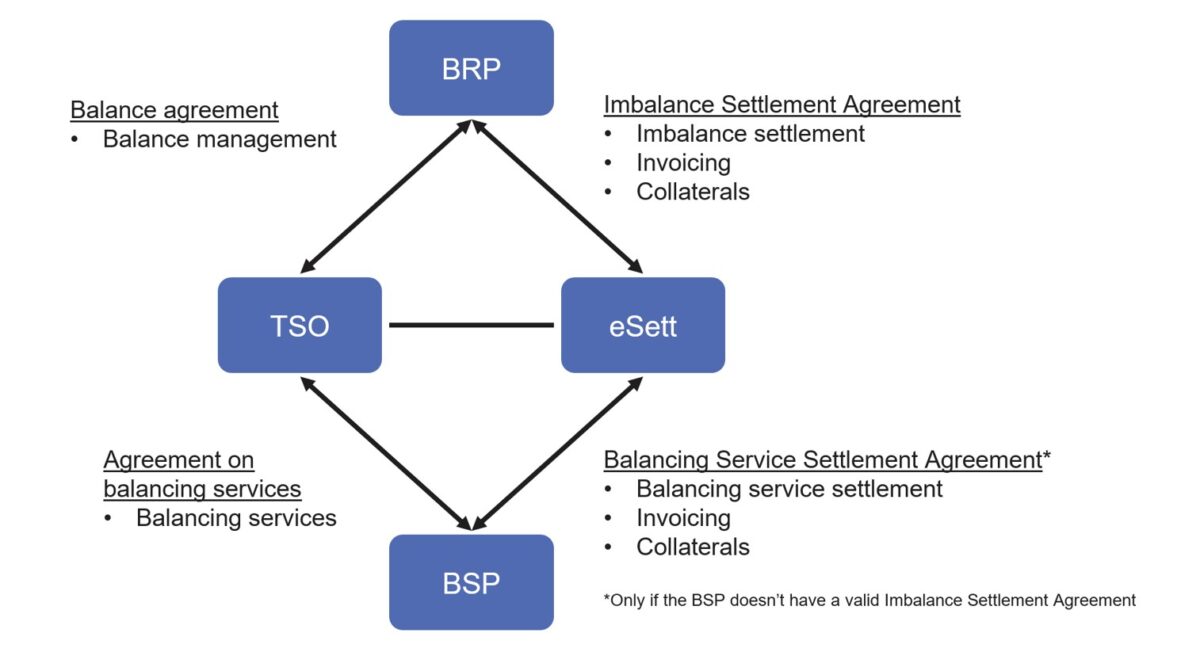
Figure 6. BRP and BSP agreements.
As before, a BRP or BSP must comply with the TSOs requirements if they are providing reserves in the balancing markets.
In addition, BRPs and BSPs need to hold a bank account(s) in an approved settlement bank, i.e. a bank which has been approved by eSett to be used in the settlement. See chapter 8.4 for the required banking setup and related agreements.
The Imbalance Settlement Agreement between eSett and BRP regulates the relations between the parties and the settlement requirements that the BRP must comply with. The following topics are included in the imbalance settlement agreement:
- BRP’s rights and obligations
- eSett´s rights and obligations
- Fees and taxes
- Invoicing and payment process and requirements
- Collaterals procedures and obligations
- Imbalance settlement rules as defined in the Handbook
- Parties’ contractual liability
- Procedures when the agreement is breached by the BRP
- Term and termination of the agreement
- Procedures when the agreement and its appendices are amended
- Dispute resolution and governing law
The Balancing Service Settlement Agreement between eSett and BSP regulates the relations between the parties and the settlement requirements that the BSP must comply with. The following topics are included in the balancing service settlement agreement:
- BSP’s rights and obligations
- eSett’s rights and obligations
- Fees and taxes
- Invoicing and payment process and requirements
- Collaterals procedures and obligations
- Settlement rules as defined in the Handbook
- Parties’ contractual liability
- Procedures when the agreement is breached by the BSP
- Term and termination of the agreement
- Procedures when the agreement and its appendices are amended
- Dispute resolution and governing law
In order to enter into agreement with eSett and the TSO(s), the BRP or BSP shall contact eSett for more information. Valid imbalance settlement agreement or balancing service settlement agreement, the appendices and contact information can be found on eSett’s web site.
Each party has the right to terminate the agreements with eSett and the TSO(s) according to what has been specified in each agreement.
The terms, under which eSett and TSOs shall have the right to terminate the agreements with eSett and the TSO(s), have been specified in each of the agreements. If a BRP or BSP acts against the rules of the agreements, following steps will be taken by eSett and TSO(s).
- eSett and TSO shall inform each other and assess the situation together.
- eSett or TSO shall inform the party of breach of agreement(s) and possibly
- request for explanation for the breach of contract
- give a deadline within which the situation must be corrected.
- TSO may inform the national regulator, eSett and NEMOs that exclusion is possible. (Only in Norway.)
- After an analysis, TSO has the right to decide whether an immediate termination of agreement is needed or not.
In case of termination of agreements with immediate effect, and thus causing a BRP to become a subject to exclusion from the market, the processes hereinafter are followed.
- eSett or TSO shall inform the party of the decision and market exclusion.
- eSett or TSO shall inform the national regulator, NEMOs, DSOs and affected REs about the exclusion.
- Information shall be published via eSett and possibly also via TSO and/or national regulator.
In case of a market exclusion of a BRP, there are some national differences for the handling of the affected retailers, which have been described in the sub-chapters below
The affected retailers must sign a contract with a new BRP to effectuation within 3 days after the information from Energinet. During the period from the BRP market exclusion until the contract with a new BRP becomes valid, Energinet will operate as a BRP for the retailer. eSett will help to establish the necessary setup in the imbalance settlement system. If a retailer fails to get a contract with a new BRP within the time frame, Energinet will distribute the retailer’s metering points to other retailers.
DSOs will stop the deliveries and distributions of a retailer that does not have an open supplier or a BRP. However, a DSO cannot stop the deliveries to the end users due to reasons of the retailer before the DSO has informed the end users about the termination. DSOs will guarantee the deliveries to the end users at least 3 weeks after the announcement of termination. If the DSO has not pointed out other open supplier, deliveries will be part of the MGA losses.
The affected retailers in Norway will, if they are unable to obtain a new BRP, be excluded immediately at the time when the existing BRP responsibility ends. DSOs will act as a supplier of last resort for the end users of the retailers that are excluded.
The affected retailers have 10 working days and at most 15 calendar days to obtain a new BRP. During the period from the BRP market exclusion until the contract with a new BRP becomes valid, each affected retailer will operate as a BRP for themselves. If a retailer fails to get a contract with a new BRP within the time frame, DSO should replace the retailer with the retailer of last resort.
This chapter shall clarify the different options the market participants have when organising themselves for the imbalance settlement model. As previously mentioned, the purpose of the imbalance settlement model is among other things meant to lower the barriers for operating in more than one country. However, national laws and the imbalance settlement system set certain requirements and limitations under which the market participants are expected to act. Company data model ties important concepts together by connecting the country, company, market participant role, collaterals, invoices, balance account, agreements, coding scheme and the related market participant code. In principle, there are three different ways to act in several countries and these possibilities are demonstrated in the following with the help of an illustrative table, which presents the case of a BRP. This chapter refrains from favouring any of the presented options and it is thus left for each company to consider and choose an option they deem to be most suitable for themselves.

Table 1. Company data model in NBS.
The first option in the above table describes a situation where two separate companies with their own business IDs are established, or already exist, in order to operate the BRP roles in two different countries. In practice, this set-up means that both of the market participant roles will have their own collaterals, separate invoices, and their own settlement accounts with eSett, one agreement with both TSOs and eSett depending on the countries the BRPs operate in, and finally, their own separate market participant codes, which are used, e.g. for messaging. In this case, these codes may follow the local coding schemes when operating only in one country. The agreements here are the Imbalance Settlement Agreement with eSett and the Balancing Agreements with TSOs. In this option, the companies are registered in different countries.
The second option is based on only one company having two separate BRP roles. This results in two separate collaterals, invoices, settlement accounts, agreements and market participant codes.
In order to prevent a situation where it is necessary to place several collaterals, the third option could be considered. This option gives the possibility to organise the company structure based on only one company and one BRP role, which operates in more than one country. However, differences in legislation between countries set limitations to this scenario in case the company is active in Norway. Due to Norwegian legislation, it is mandatory that in this option the company is registered in Norway since it is required that BRPs acting in Norway are locally registered companies.
One market participant role results in one set of collaterals as they are role-specific. In this scenario, the company will receive as many invoices as there are countries where the BRP operates since the invoice is always country-specific. The number of required settlement accounts depends on the number of currencies used, which means that if the BRP uses one common currency it is sufficient to have only one settlement account. For agreements, the same applies as to collaterals: they are role-specific. Logically, one BRP role requires only one market participant code as long as it is not any of the national codes, but either the EIC or GS1 code. However, it is mandatory to use Norwegian GS1 codes for market participant roles related to Norwegian companies.
This chapter shall clarify the different options the market participants have when organising themselves as Balancing Service Provider in the NBS model. As many BSPs are also BRPs, which impacts on the possible setup of agreements and invoices compared to a market participant that only operates as a BSP. However, national regulation set certain requirements and limitations under which the market participants are expected to act. The data model ties important concepts together by connecting the company, market participant role, collaterals, invoices, settlement account, agreements, coding scheme and the related market participant code. In principle, there are three different ways to operate, and these possibilities are demonstrated in the following with the help of an illustrative table.
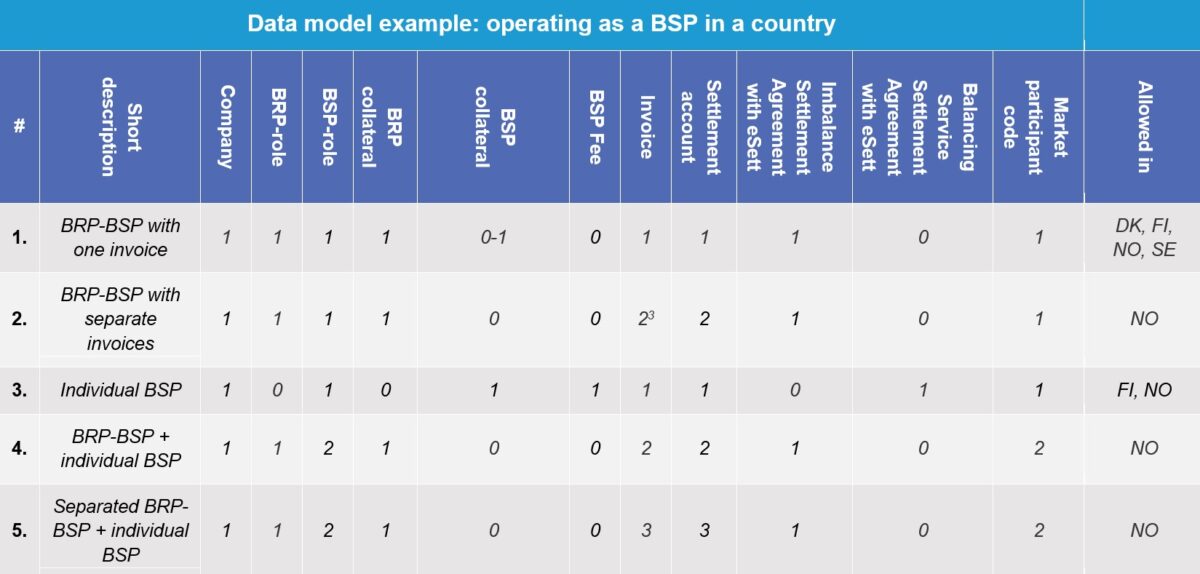
Table 2. Data model for operating as a BSP in a country in NBS.
The first option is that a Balance Responsible Party (BRP) is also providing balancing services in the same country through same company. There will be both BRP and BSP roles, but only one BRP collateral and invoice, which contain also the products from the BSP-role. An exception is a BSP in Finland that provides independent aggregation, as they need to provide also BSP collateral on top of the BRP role. The market participant doesn’t need to sign Balancing Service Settlement Agreement with eSett as the Imbalance Settlement Agreement already stipulates necessary rights and obligations to operate as a BSP. Also, only one settlement account and by extension related account agreement is required in this option. The BRP and BSP roles may use the same market participant code for data exchange.
The second option is the same as the first one, but with t This will be useful in cases where the BRP and BSP market roles wish to be invoiced with different currencies. This setup requires two separate settlement accounts and related account agreements for both accounts.
The third option represents a case where a market participant is operating as a Balancing Service Provider (BSP) without having a BRP-role. In this case, there is a BSP collateral as defined in chapter 9.11 and nationally defined BSP fee. The BSP needs only one settlement account and receives one invoice. Instead of Imbalance Settlement Agreement, the BSP signs a Balancing Service Settlement Agreement with eSett. The BSP has its own unique market participant code for data exchange.
The fourth option is a scenario where a company has a Balance Responsible Party (BRP) providing balancing services in the same country through one company (option 1). Additionally, the same company has an individual Balancing Service Provider (BSP) role with its own unique code (option 3). This setup may be used when the company wants to separate some balancing services under a different BSP role and invoice, or use different currencies for different balancing services.
In the fifth option, a company separates the BRP and BSP role-related products into their own invoices (option 2). Additionally, the same company has an individual Balancing Service Provider role with its own unique code (option 3). This setup could be used, for example, when the company wants to separate imbalance settlement into a BRP invoice and some balancing services under a different BSP role and invoice, or wishes to use different currencies for different balancing services.
All balancing services (i.e. capacity and activated reserves) are on the BSP invoice while imbalance settlement (i.e. imbalances and fees) are on the BRP invoice.
The settlement structure is one of the key elements in the Nordic Settlement Model. Each market participant is responsible for informing and updating structural information. Structural information is information about the market participants and their relations to each other (e.g. the relationship between a BRP and an RE) and to the Market Entities and Market Entity Connections (e.g. the relationship between an RE and an MGA). Every market participant has to register for acceptance to operate in the market. The participants themselves are responsible for registering and keeping their own information up-to-date.
Every company taking part in imbalance settlement needs to register in the imbalance settlement system. Company information will be registered together with information about the different roles that the company operates. A company can have several different roles (BRP, BSP, DSO, RE). Every role the company operates will be registered as a market participant. It is also possible for a company to have multiple market participants of the same role.
eSett will maintain the structure information, based on the information provided by the DSOs, BRPs, BSPs and TSOs. The DSOs are responsible for updating the structure related to metering points in the MGAs they are accountable for (e.g. a retailer’s consumption and production within a MGA) and the BRPs are responsible for updating the structure of their obligations (e.g. which RE in the different MGA they are responsible for). BSPs are responsible for updating the balance responsibility information of their reserve resources.
The market participants shall enter changes in the settlement structure in the Online Service, provided by eSett. The changes are validated and approved after they have been entered in eSett´s imbalance settlement system. Once the changes are approved, they will be used in imbalance settlement. The structure information is published in the Online Service where market participants can view the up-to-date settlement structure information. Restrictions to view are managed with access rights in accordance with the legislation.
Furthermore, market participants will also be able to view and download the area-specific structure for all countries, i.e., information for MGA master data, MBA master data, MGA-MGA relations and MGA-MBA relations. The content of the MGA and MBA master data will be area-specific information, such as type, name, area identification, etc.
Up-to-date structural information is essential for managing the reporting and other imbalance settlement functions. The settlement structure contains the information related to different market participants: TSOs, DSOs, BRPs, BSPs and REs, and information on the relationship between the market participants.
Information regarding the BRPs’ responsibility for an RE in all MGAs, and the specific period of time, is essential to enable correct reporting of data and calculation of imbalances. One common and public overview with this information is therefore developed and maintained in eSett’s imbalance settlement system.
Every entity of structural information has a validity period. The given start and end date define the period of time during which the specific entity is considered to be active. The end date is not required when creating a new structure, but it shall be entered when the end date has been confirmed.
A description of the structure elements and their relations are available in Figure 7.
A detailed description of the interface and the process of managing the structural information will be provided as a User Guide in the Online Service.
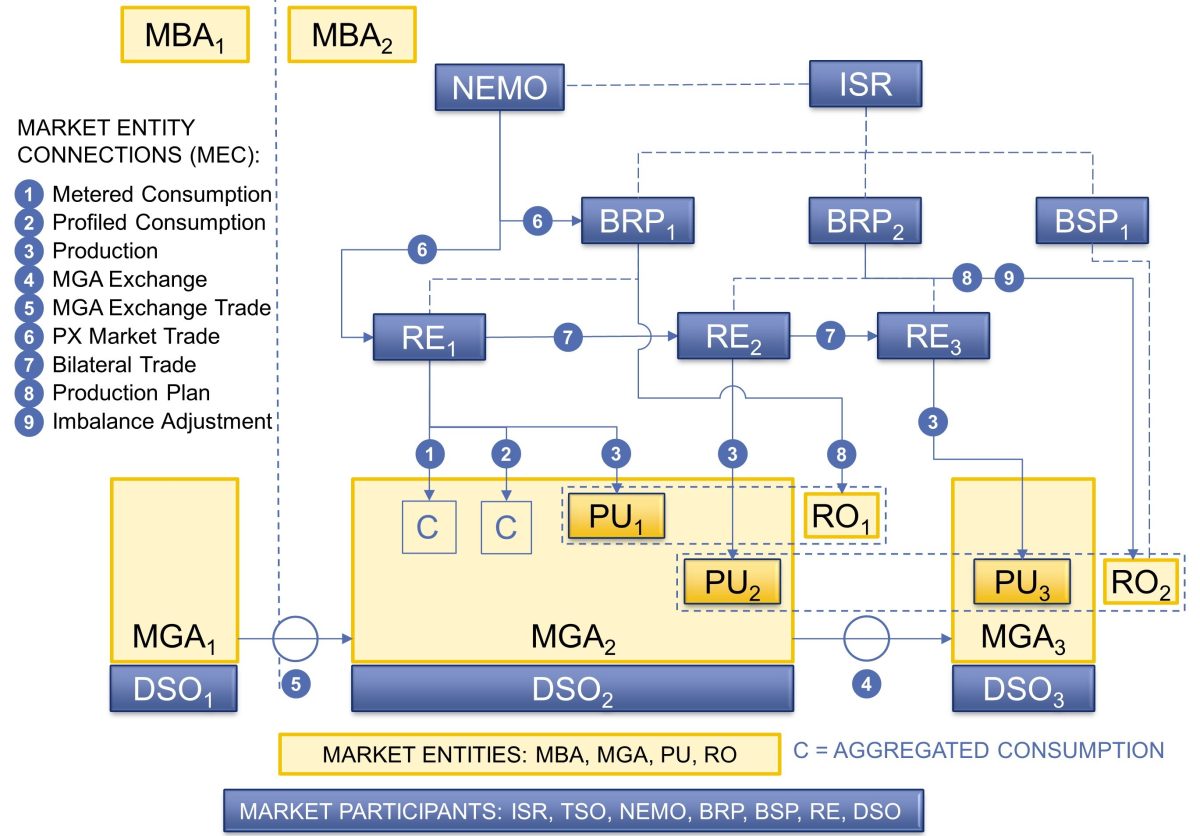
Figure 7. An illustrative example of the structure elements and their relations.
Information about the settlement structure is related to different types of roles (RE, BRP, DSO and TSO). One company may have multiple roles, and each of these roles shall be presented by a separate Market Participant operating in the electricity market. It is also possible for a company to have multiple market participants with the same role. In the Nordic Settlement Model, there is always a connection between the structure information and specific market participants, being valid for a specified period of time. The roles are defined and described in the Table 3 below.
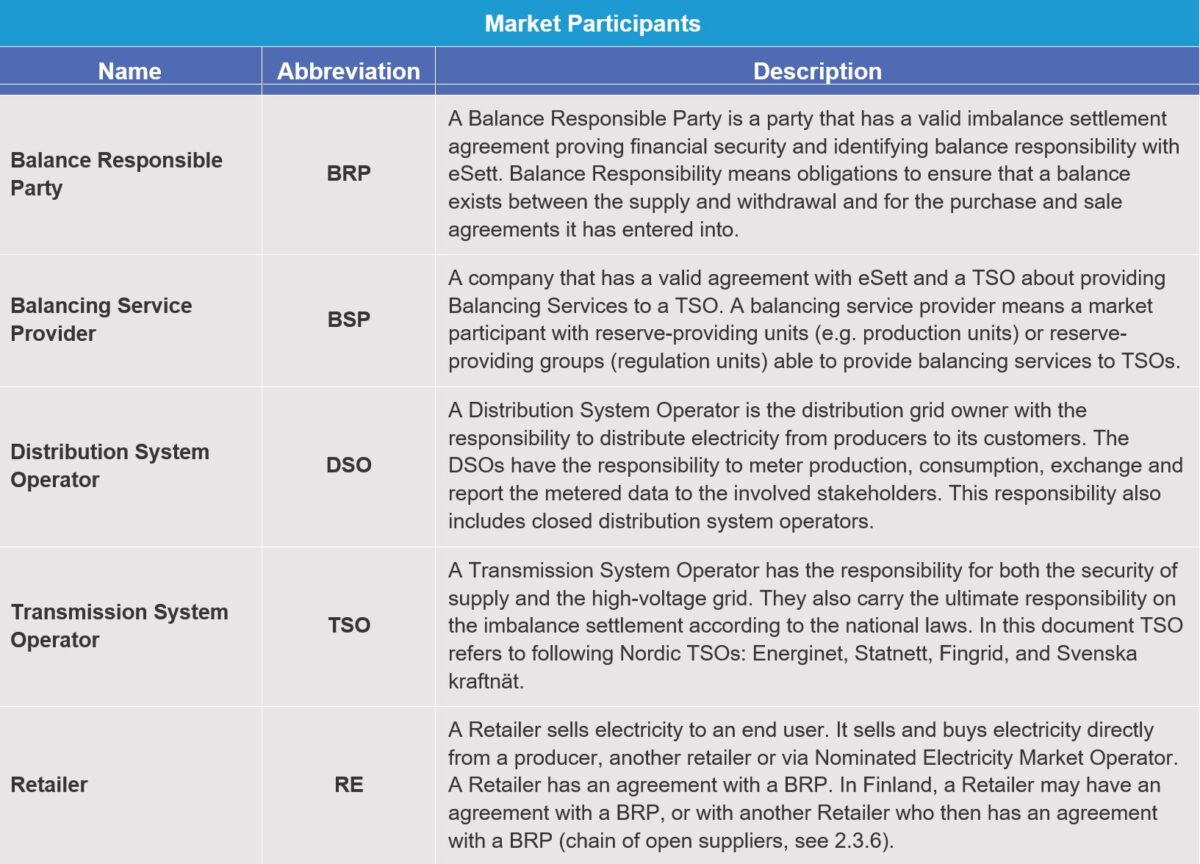
Table 3. The Market Participants in the Nordic Settlement Model
Unbundling rules define the roles that can be performed by a single company. Currently, there are some national differences in this legislation that will impact imbalance settlement.
Unbundling rules in Sweden, Denmark and Finland define that REs and DSOs must belong to separate companies. The exceptions are Finland and Norway where DSOs with non-concessional grid (e.g. production and industrial metering grid areas) can belong to the same company as the RE.
In order to organize the settlement information in a structured way, the structure information is also related to a market entity (ME). These are used to further specify the areas where consumption, trade and exchange occur, including also the power generator and regulation object. The defined MEs and the corresponding descriptions are shown below in Table 4.
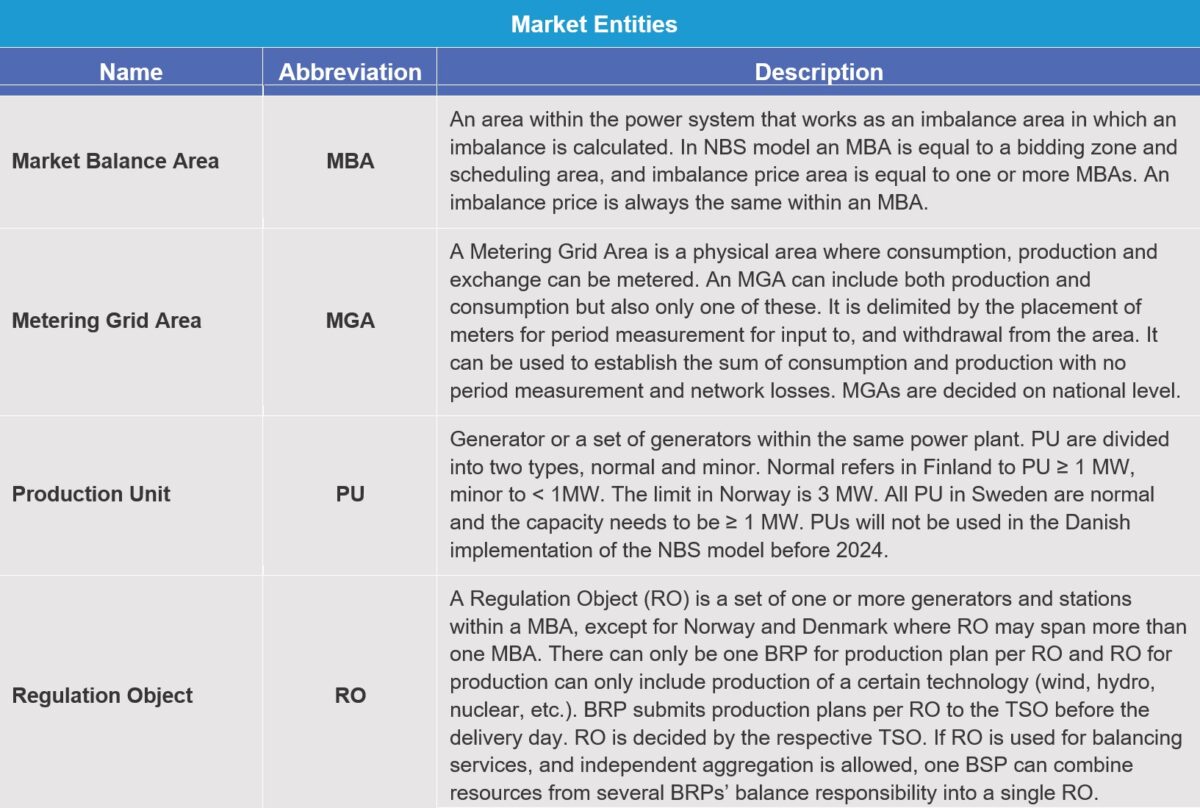
Table 4. Market Entities in the Nordic Settlement Model
A large amount of settlement information is exchanged between market participants within the Nordic settlement. The information is organised into so called Market Entity Connections (MEC). The MECs are central in the imbalance settlement structure as they facilitate reporting of all the time series with settlement data.
MECs are different kinds of connections either between market participants (e.g. bilateral trades between parties) or between market participants and market entities (e.g. market participant’s metered consumption in MGA or market participant’s production per Production Unit). MEC’s time series data is the core of the settlement. Table 5 explains the MECs utilised in the Nordic Settlement Model.
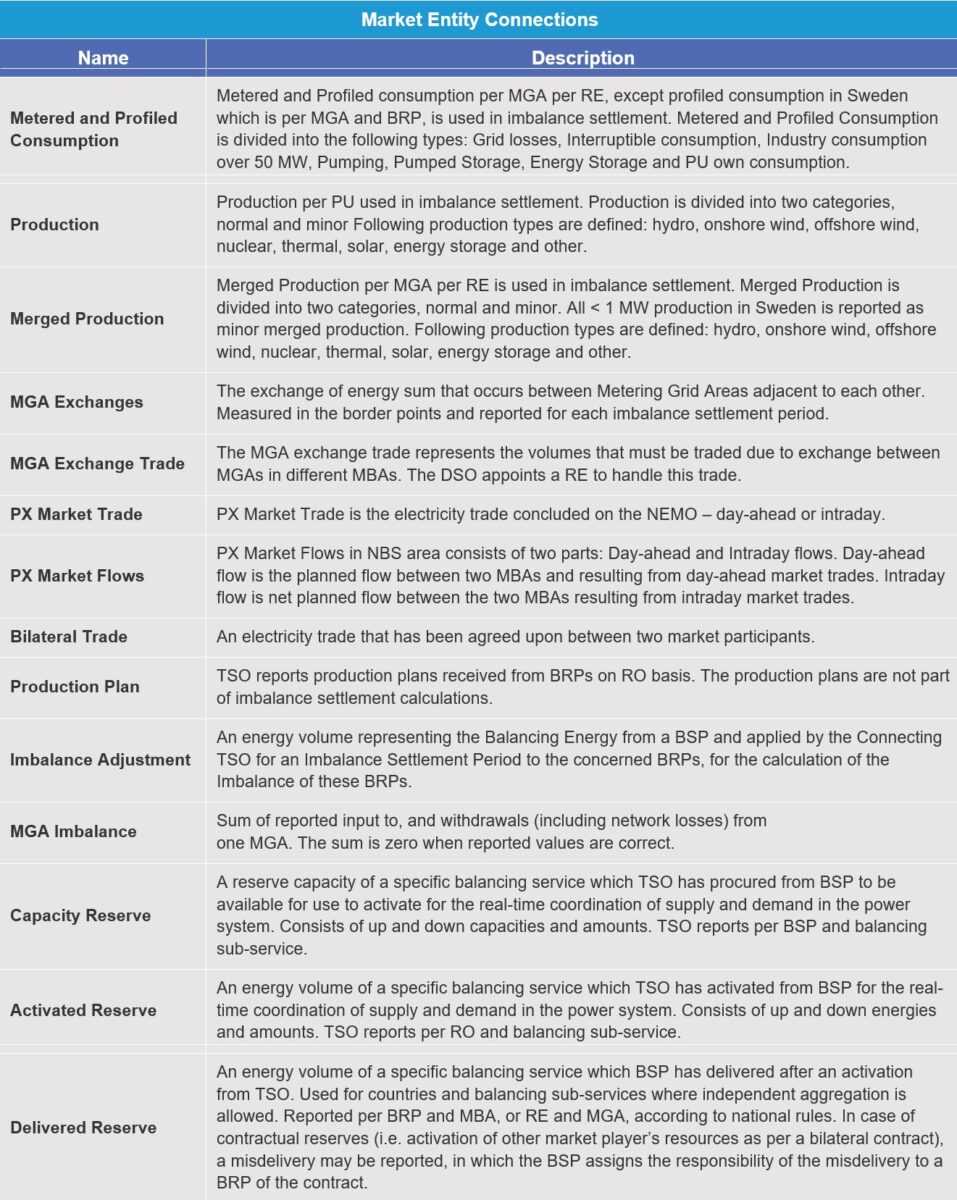
Table 5. Market Entity Connections in the Nordic Settlement Model
eSett receives structure information from market participants containing imbalance settlement structure information that should be added, updated, or closed in the imbalance settlement system. The structure information is entered via the Online Service and validated by eSett. When the settlement structure has been updated, eSett publishes the settlement structure to market participants in the Online Service.
Every participant in the electricity wholesale market will have to apply to eSett for acceptance into the settlement structure. The participants themselves are responsible for registering and verifying that their information is up-to-date. Responsibilities regarding the settlement structure information management are explained in the following sub-chapters.
eSett hosts the common settlement structure information. The related responsibilities are the following:
- Setting BRPs as active when the imbalance settlement agreement is set into force and related requirements are fulfilled (Appendix 1)
- Setting BRPs as inactive when the imbalance settlement agreement has been terminated
- Setting BSPs as active when the required agreements are set into force and related requirements are fulfilled (e.g. possible collateral)
- Setting BSPs as inactive when the required agreements have been terminated
- Setting DSOs as active when they fulfil all requirements as DSO (license from the local authority, ID, certificate, testing)
- Setting DSOs as inactive when DSOs activity has ended
- The DSO has for example been merged with another DSO
- Setting REs as active when they fulfil the requirements set upon them by the regulators
- Since an RE may have a different BRP in every MGA it’s most efficient that eSett perform this control instead of many DSOs or BRPs controlling the same RE
- An active RE will be able to handle consumption, trade and production
- Setting REs as inactive when their activity has ended
RE is responsible for reporting the following structure information to eSett:
- Registering company as an RE
- Retailer initiates the switch of supplier process. This process can only be initiated when the RE has a valid BRP in the MGA where the delivery will take place
- Update own contact information
BRP is responsible for reporting the following structure information to eSett:
- Registering company as a BRP
- If a BRP has a valid agreement with a TSO regarding balancing services, registering company also as a BSP
- Registering for which REs they take on the responsibility for production, and in which MGAs. It is the new BRP that is responsible for applying the correct structure
- Registering for which REs they take on the responsibility for consumption/trade, and in which MGAs. It is the new BRP that is responsible for applying the correct structure
- Manage MECs for bilateral trade for REs that they are responsible for. Registration of a bilateral trade needs to be done by one of the BRPs and the counterpart will then need to approve the registration of the bilateral trade with this BRP
- Assigning PU to the correct RO
- Provide the TSO with sufficient information to register ROs
- Update own contact information
BSP is responsible for reporting the following structure information to eSett:
- Registering company as a BSP
- Provide the TSO with sufficient information to register ROs, including the balance responsibility information of the ROs’ reserve resources
- Update own contact information
DSOs have the main responsibility in maintaining the correct and up to date settlement structure. DSO is responsible for reporting the following structure information to eSett, unless some of these responsibilities are taken over by a Metered Data Aggregator:
- Registering company as a DSO
- Updating the structure for consumption MECs within the MGA
- Provide following information: Retailer, MGA, Consumption Type and Validity
- For the Swedish profiling also: BRP, MGA, Consumption Type and Validity on a monthly basis
- Updating the structure for merged production MECs within the MGA
- Provide following information: Retailer, MGA, Production Type, PU Type and Validity
- Updating the structure for PU within the MGA
- Provide following information: MGA, Production Type, PU Type, Validity, Production Unit ID and Capacity (nominal capacity of the PU)
- Updating the structure for production MEC
- Assign a RE to the PU
- The DSO must select a RE for every MGA to handle the MGA imbalance
- Updating own contact information
Metered Data Aggregator maintains the settlement structures related to DSOs. It can be for example a national hub which handles all reporting towards eSett and acts between DSO and eSett. Thus, Metered Data Aggregator handles several responsibilities instead of DSO. Their reporting to eSett includes:
- Updating the structure for consumption MECs within the MGA
- Provide following information: Retailer, MGA, Consumption Type and Validity
- Assign Retailer for every MGA to handle the MGA Imbalance
- Updating the structure for merged production MECs within the MGA
- Provide following information: Retailer, MGA, Production Type, PU Type and Validity
- Updating the structure for PU within the MGA
- Provide following information: MGA, Production Type, PU Type, Validity, Production Unit ID and Capacity (nominal capacity of the PU)
- Updating the structure for production MEC
- Assign a RE to the PU
- Updating own contact information
NEMO is required to register as a BRP and RE in the settlement structure. In addition, NEMO is responsible for reporting occurred PX Market Trades. NEMO is responsible for reporting the following structure information to eSett:
- Registering company as a BRP
- Managing MECs for Day-ahead trades
- Managing MECs for Intraday trades
- Managing MECs for Day-ahead flows
- Managing MECs for Intraday flows
- Managing MECs for Bilateral trades
- Updating own contact information
- NEMO may delegate the performance of tasks related to balance responsibility to the Central Counter Party (CCP) of the NEMO. In that case, all the above-mentioned responsibilities are responsibilities of the CCP
TSOs have, in addition to below mentioned responsibilities, the similar responsibilities as the BRPs (if applicable):
- Determining the MGAs
- Determining which MGAs that will be included in a MBA
- Managing MECs for MGA exchange
- Managing MECs for imbalance adjustment
- Managing ROs
The settlement structure information is to be registered according to the defined gate closure times. The gate closure times per responsible party are described in Table 6.
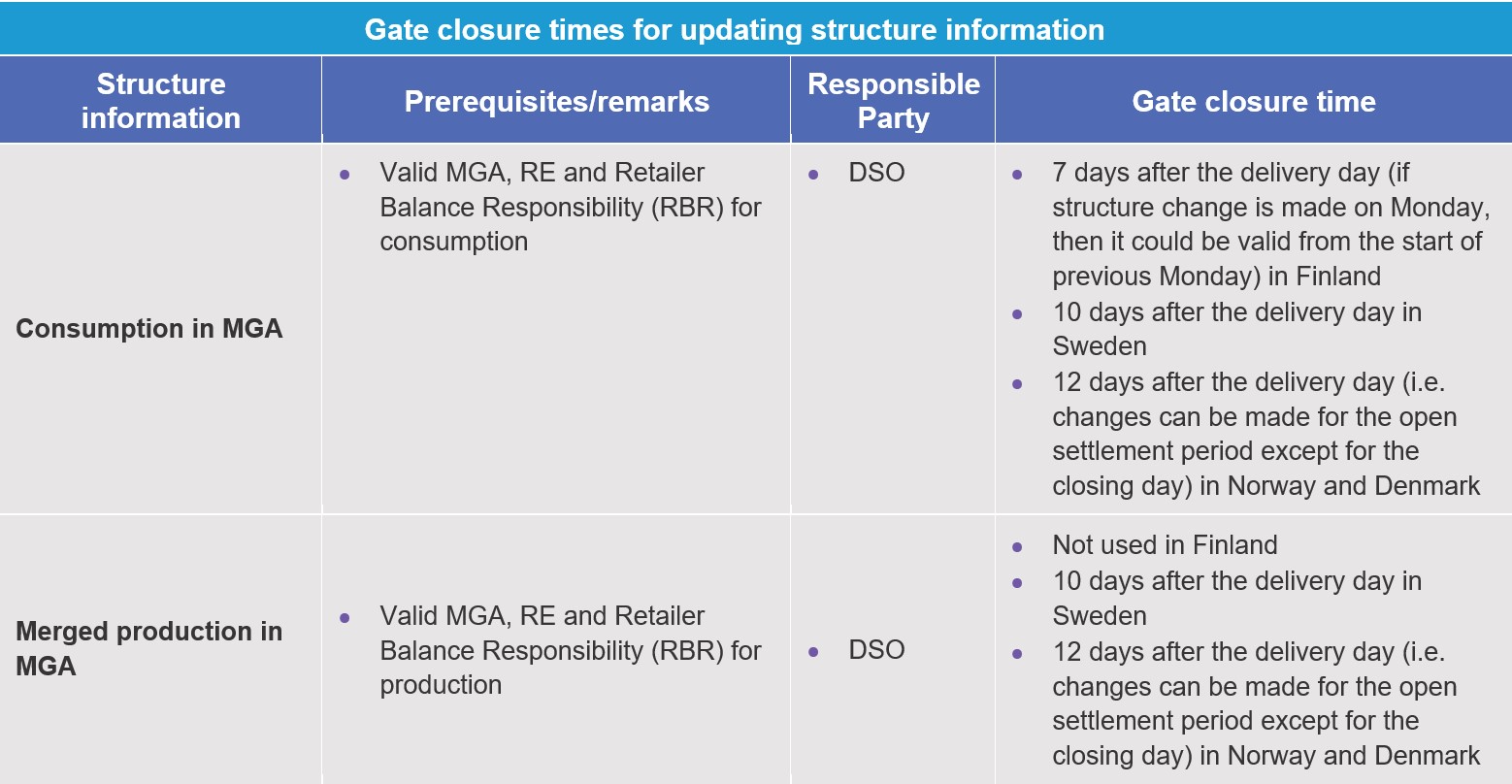
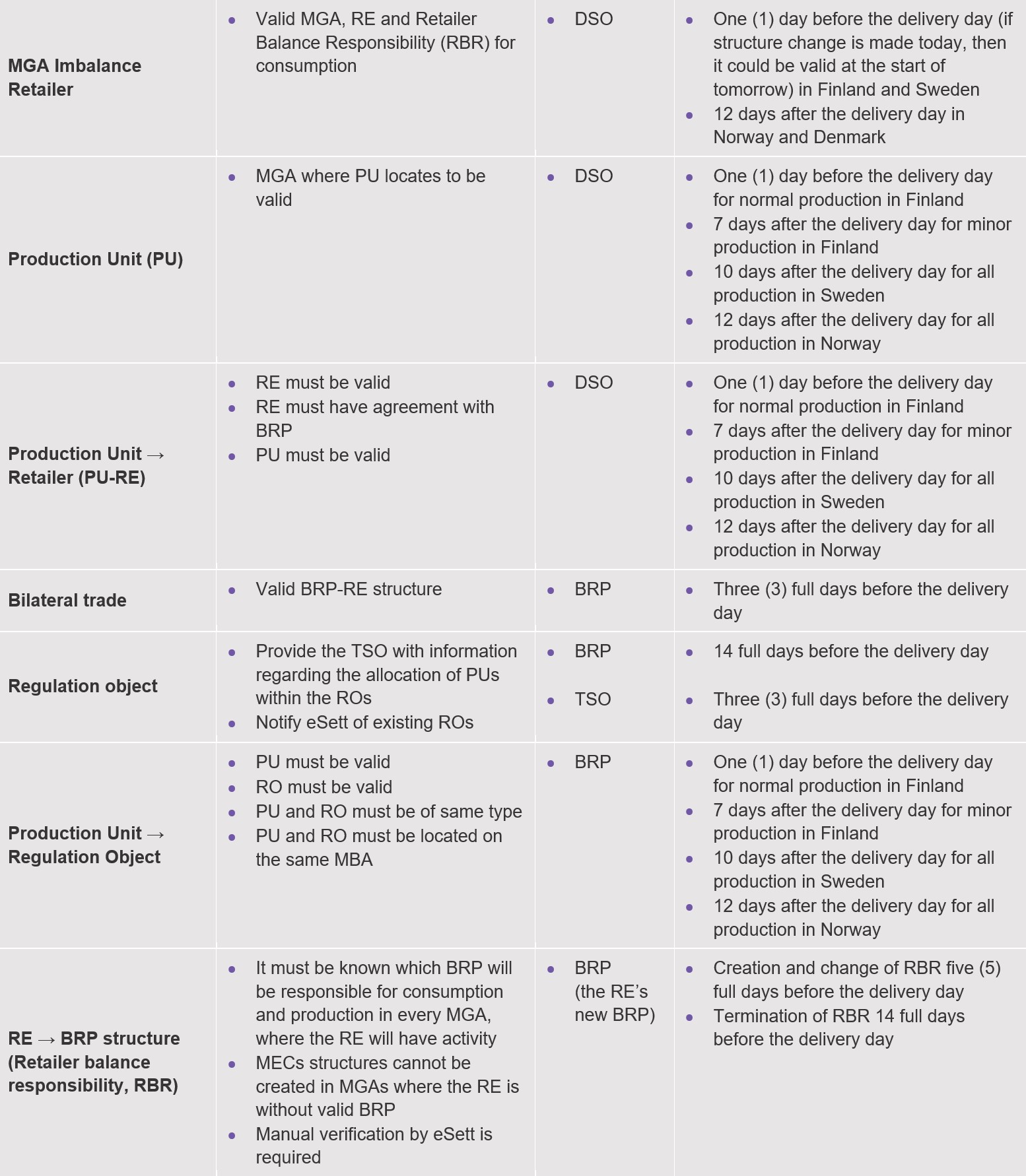
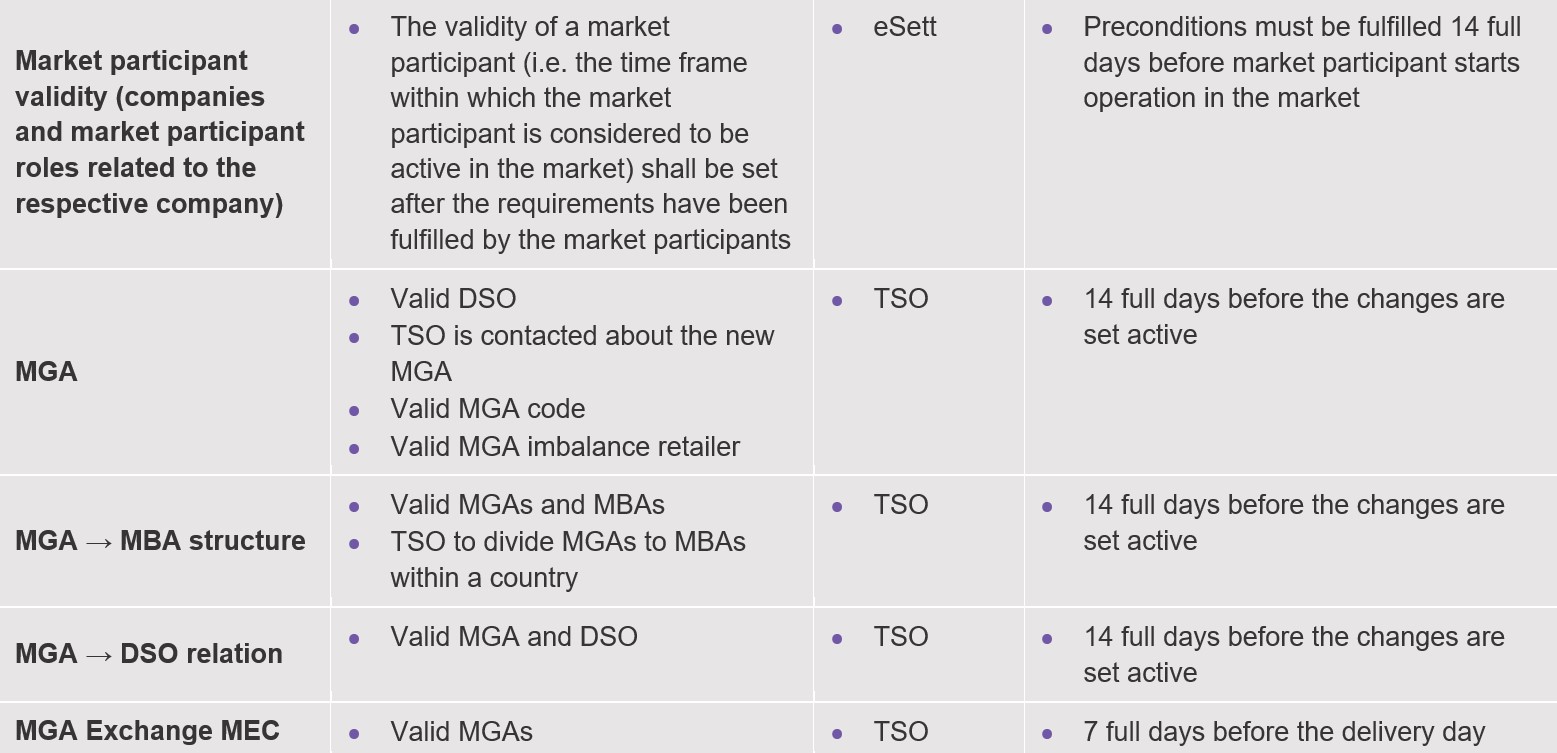
Table 6. Gate closure times for reporting structure information
Example of the gate closure times for reporting structure information:
New RE that should be registered in the Nordic market:
- The new RE shall provide eSett with required information to register the company. eSett register the new RE and set the RE as valid at the earliest starting from 14 days after all mandatory information has been provided.
- From the day that eSett registers the new RE it will be available for the BRP to register the BRP-RE relation for the specific MGA. Valid start date can earliest be the same as new RE start date but not earlier than 5 days from when the BRP registers the responsibility.
- When the BRP-RE relation is approved by eSett, the DSO will be able to submit the MGA structure (Consumption, Production). Valid from date can earliest be the same as the BRP-RE relation valid start date, given that the DSO submits the structural information.
Already registered and valid RE in the Nordic market:
- A registered and valid RE is already available for the BRP in order to register the BRP-RE relation in the specific MGA. The BRP is required to enter the information at least 5 days prior to when it shall be in operation.
- When the BRP-RE relation is verified by eSett, the DSO will be able to submit the MGA structure. Valid from date can earliest be the same as the BRP-RE relation valid start date, given that the DSO submits the structural information.
In the first example, the process will take at least 14 days. In the second example, the process will take at least 5 days.
The published structure information in the Online Service will also be provided with an XML-file. Table 7 shows an example of structure information regarding a DSO that will be provided via file. The example is based on the format of the settlement information that will be published on https://ediel.org.
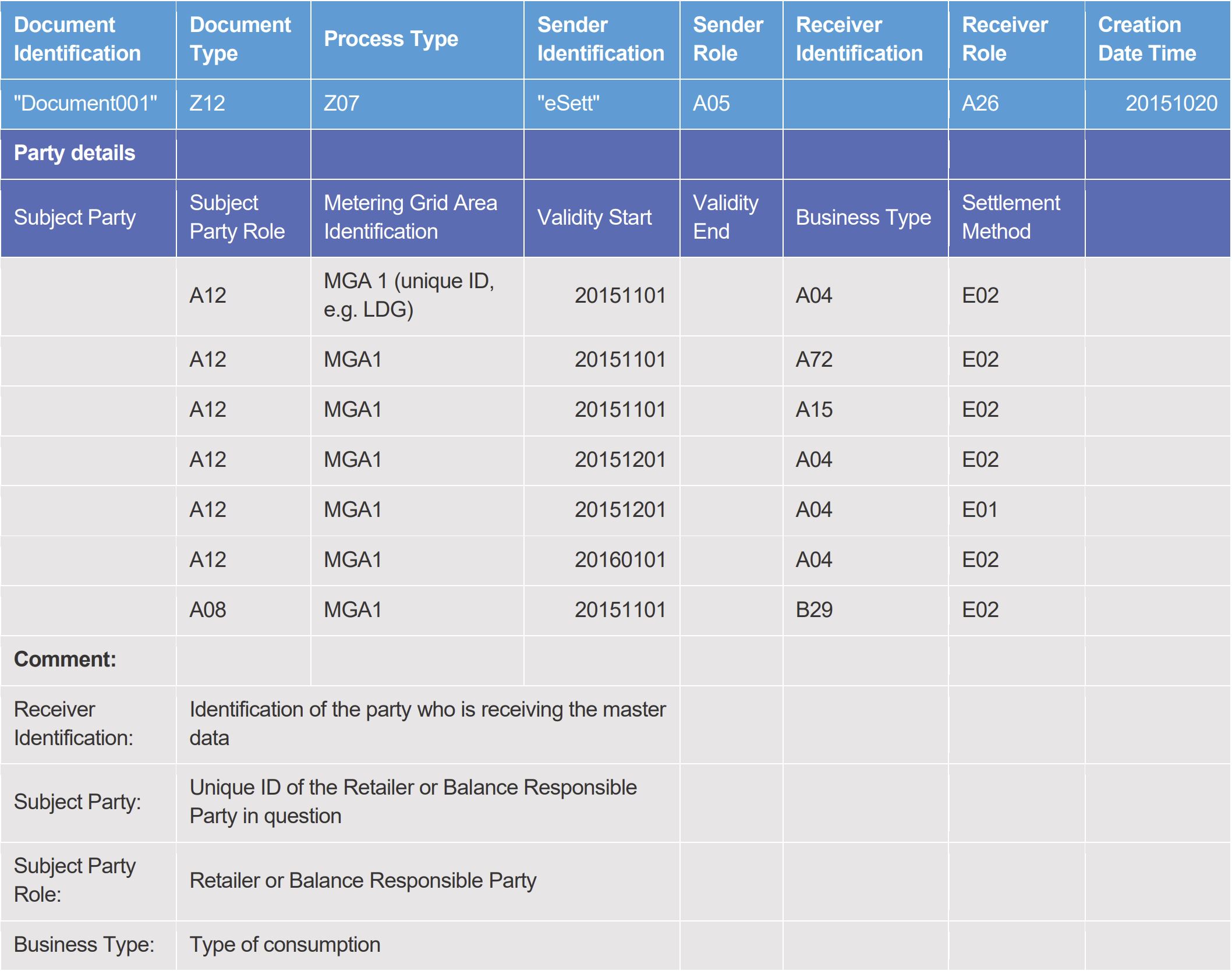
Table 7. Structure report MGA example
The Nordic Settlement Model organises all metered data, exchange, consumption and production, into MGAs. Each MGA is connected to a single MBA and DSO, thus connecting the metered consumption and production as MECs to the imbalance settlement structure.
Reporting of metering data (as further described in chapter 5) is considered as a responsibility of a DSO in the Nordic Settlement Model, including the aggregation of data to RE level. eSett is responsible for aggregation of received metering data on a BRP level for imbalance settlement purposes.
Considering the critical role of the metering data from the imbalance settlement perspective, it is thus important to secure sufficient quality on reported data to ensure accurate imbalance settlement, by minimising variations caused by data quality (e.g. missing or incorrect values) and its timely submission within specified gate closures. Therefore, the quality of reported data will be closely monitored by eSett and reported to related market participants by specific reports and KPIs (see chapter 11 for further information).
This chapter defines and describes the different types of metering data utilised in the Nordic Settlement Model for exchange, production and consumption and how these are expected to be handled by the DSOs in order to report these to eSett.
MGAs are defined nationally by respective TSOs in accordance with national rules and legislation. Therefore, practices can differ between the countries participating in the Nordic Settlement.
In Finland MGAs for imbalance settlement and for consumption and production have been defined in cooperation with Fingrid as a TSO, BRPs and DSOs. Every MGA has to have one responsible DSO for metering and reporting (licence for DSOs networks, licence for closed networks or agreed with Fingrid). There has to be one RE responsible for MGA imbalance within a one MGA.
In Norway the MGAs are defined by the imbalance settlement responsible with support from TSO and DSO. The DSO of the MGA must be responsible for metering and reporting of all metering points within the MGA. All metering points within the MGA must belong to the same MBA. In Norway Elhub reports data to eSett instead of Norwegian DSO.
In Sweden MGAs for imbalance settlement and for consumption and production have been defined in cooperation with Svenska kraftnät as a TSO. The principle is that the MGA is electrically connected, and the distribution is limited to one market balance area. Every MGA has to have one responsible DSO for metering and reporting. One RE is responsible for the losses within a MGA.
In Denmark MGAs for imbalance settlement have been defined in cooperation with Energinet as a TSO. Each MGA has a responsible DSO for metering and reporting of data within the MGA. There has to be one RE responsible for MGA imbalance within a one MGA. In Denmark, DSOs report data to Energinet DataHub, and they will report it to eSett instead of Danish DSOs.
There are three different main types of metered data (or types of metering points) utilised in the Nordic Settlement Model. The identified metering data types are the following:
- Exchange metering point to other MGAs:
- Metered exchange with adjacent MGAs
- Production metering points:
- Metered production per PU
- Metered merged production within the MGA
- Consumption metering points:
- Metered consumption from the MGA, divided into following subtypes:
- Metered consumption
- Metered energy storage consumption
- Pumped (only in Norway)
- Pumped storage (only in Norway)
- Interruptible (only in Sweden)
- Industry over 50 MW (only in Sweden)
- PU Own consumption (only in Finland). Production units own consumption can be separated from the metered consumption by using this type
- Profiled consumption, divided into following subtypes:
- Profiled consumption
- Pumped (only in Norway)
- PU Own consumption (only in Finland).
- Losses, may be divided into following subtypes:
- Metered grid losses
- Profiled grid losses
- Flex-settled losses (Only in Denmark)
- Metered flex-settled consumption (Only in Denmark)
- Metered consumption from the MGA, divided into following subtypes:
Losses shall be calculated in Finland as stated in chapter 5.4.3.4 and it’s not required to separate losses for both metered and profiled losses (metered shall be used and reported to eSett).
The different consumption types are explained in more details in chapter 5.4.3.4.
It is to be noted that a number of country specific types of consumption metering points shall be utilised in the Nordic Settlement Model as highlighted above.
eSett do not regulate how the estimation of missing measurement values shall be done. Practices differ between the countries today. Below information about the national principles has been provided.
The Finnish Energy industry’s directions of how the missing values shall be estimated or replaced are presented in the document “Principles of electricity metering 2024”. The document can be found at https://energia.fi/energiasta/energiamarkkinat/sanomaliikenne/ohjeet_ja_suositukset.
The Swedish directions on how the missing values shall be estimated or replaced are presented in “Elmarknadshandboken”. The document can be found at http://elmarknadshandboken.se/Dokumentation/Texter/NEMHB.pdf.
The Norwegian Elhub project has described the requirements for quality assurance that shall be performed by the DSO before reporting to Elhub. These requirements are presented as standards for validation, estimation and change of metered values. The Norwegian name of the document is “Standard for Validering, Estimering og Endring (VEE) av AMS måleverdier” and can be found at https://elhub.no/.
The Danish market regulation D1 “AFREGNINGSMÅLING OG AFREGNINGSGRUNDLAG” describes handling of and demands for estimation of missing values. The document can be found at Energinet’s homepage with Market regulations: https://energinet.dk/regler/el/elmarked/.
The MGA exchange meters measure the energy flows between the adjacent Metering Grid Areas. The meters measure the exchange in the border points. The DSOs are responsible for the MGA exchange meters (e.g. reporting the values to the imbalance settlement).
The MGA exchange means exchange of energy sum that occurs between adjacent Metering Grid Areas. These sums shall be used in eSett’s imbalance settlement. Both DSOs of the adjacent MGAs shall report the sums to the imbalance settlement, or the DSOs can agree that one of them shall report the sums.
All production metering in the Nordic Imbalance Settlement Model is based on netted metering. Netted metering is defined as metered production after own consumption used for power generation has been subtracted. Until legislation in Denmark, Finland, Norway and Sweden have been harmonised, the Nordic Imbalance Settlement Model will handle both gross and net metered production, which can be metered, aggregated and reported in accordance to principles defined below.
An industry site that also has its own production units are not allowed to net the production with their consumption. Production and consumption should be metered and reported separately to eSett’s imbalance settlement.
The definition of own consumption has not been harmonized. Information about the national principles has been provided below:
- In Finland the legislation for own consumption of the production plant can be found in the document “Kauppa – ja teollisuusministeriön asetus voimalaitosten omakäyttölaitteista”. The document can be found at: https://www.finlex.fi/fi/lainsaadanto/saadoskokoelma/2003/309.
- In Sweden there is no legislation describing own consumption of the production plant.
- In Norway the definition of own consumption of the production plant can be found in the document “Forskrift om elsertifikater” in chapter 3 § 16 “Bestemmelser om måledata og korreksjonsfaktor”.
- In Denmark rules for settlement metering of production in various cases, including handling of own consumption, is described in Market regulation D1 chapter 5 in combination with the document “RETNINGSLINJER FOR UDFØRELSE AF MÅLINGER TIL BRUG FOR NETTOAFREGNING”. Both documents can be found at Energinet’s homepage with Market regulations: https://energinet.dk/regler/el/elmarked/.
Net metering has been implemented so that both generator and own consumption of the production unit are metered by the same meter. This is illustrated in the Figure 8 below. In this case, the meter is a so-called two-way meter and it is possible to measure energy in both directions. If production energy exceeds the own consumption, it is reported as production. If there is no production during an imbalance settlement period, the own consumption will be reported as consumption (consumption type: PU Own Consumption).
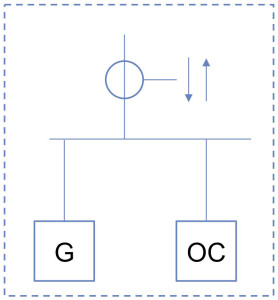
Figure 8. Net metering of production
Gross generation is defined as the sum of the electrical energy production by all the generating sets concerned, measured at the output terminals of the main generator. In Figure 9 the principle of gross metering has been described. Meter 1 is for production metering and meter 2 is the metering of own consumption. Meter 1 will be the reported production of the PU. Metered values from Meter 2 will be aggregated together with other meters that the RE has in this MGA before it is reported to eSett.

Figure 9. Gross metering of production
Net metering of PUs with own consumption and an additional consumption (C) may be set up according to Figure 10 (no meter 2 is required for sites with main fuse up to 3x63A in Finland). The additional consumption (C) (e.g. a factory) may not be netted with the production. Only netting of own consumption behind meter 2 is allowed.

Figure 10. Meter for production, own consumption and consumption
Consumption (C) is calculated as: C = (1 – 2)
If the production (2) is ≥ 1 MW the production (2) shall be reported separate from consumption (C). If the DSO doesn´t have this task the plant owner is obliged to organize the site as an own MGA and report production and consumption.
As defined above minor production (e.g. < 1 MW in Finland) can be netted with consumption e.g. in the case when there will be wind turbines and solar panels in a household level. This production will deduct consumption and can be netted with RE’s aggregated consumption in the specific metering grid area. But when this kind of minor production exceeds RE’s consumption in the MGA, it has to be reported separately. Practically (based on e.g. the data formats) the PUs for this kind of minor production need to be established and it’s possible to create a virtual PU to all RE’s minor production in a one specific MGA. It’s always possible to report minor production and consumption separately.
In Finland, reserve power generators, energy storages or other low-power machines over 1 MW that are only intended for temporary use and disturbance management purposes are handled as above defined minor production.
The DSO should, in a settled meter point, meter values at each shift of imbalance settlement period. The DSO is recommended to perform data acquisition as soon as possible after the delivery day.
The handling of consumption metering will be done in accordance with existing national rules.
In Sweden, if the DSO has profiled consumption (monthly meters), they are also obliged to meter or estimate:
- Preliminary profile shares per MGA and BRP
- One load profile share for losses included
- Load profile per MGA
- Final Load Profile Shares per MGA and BRP
- One load profile share for losses included.
There are not yet harmonized rules, but the main principles for the handling of energy storages are the same
for all countries in the Nordic Imbalance Settlement. There are some national differences that are specified
below.
The main principle is that an energy storage will be registered with two metering points; one for consumption
for when the energy storage is charging, and another for production for when the energy storage is
discharging. Netting between charging and discharging is not allowed for energy storages. A production plan
is required for the discharging always in Denmark and Sweden, and also in Finland and Norway if the energy
storage capacity is 1 MW or higher.
In Denmark, Norway and Sweden there are no specific rules for the metering of energy storages. It is
handled according to the rules for Production metering (discharge) and Consumption metering (charge).
Netting with other metering points is not allowed for energy storages.
The specific rules for Finland have been described in detail in chapter 4.6.1.
Table 8 compiles the cases for handling of energy storages in imbalance settlement per country and type.
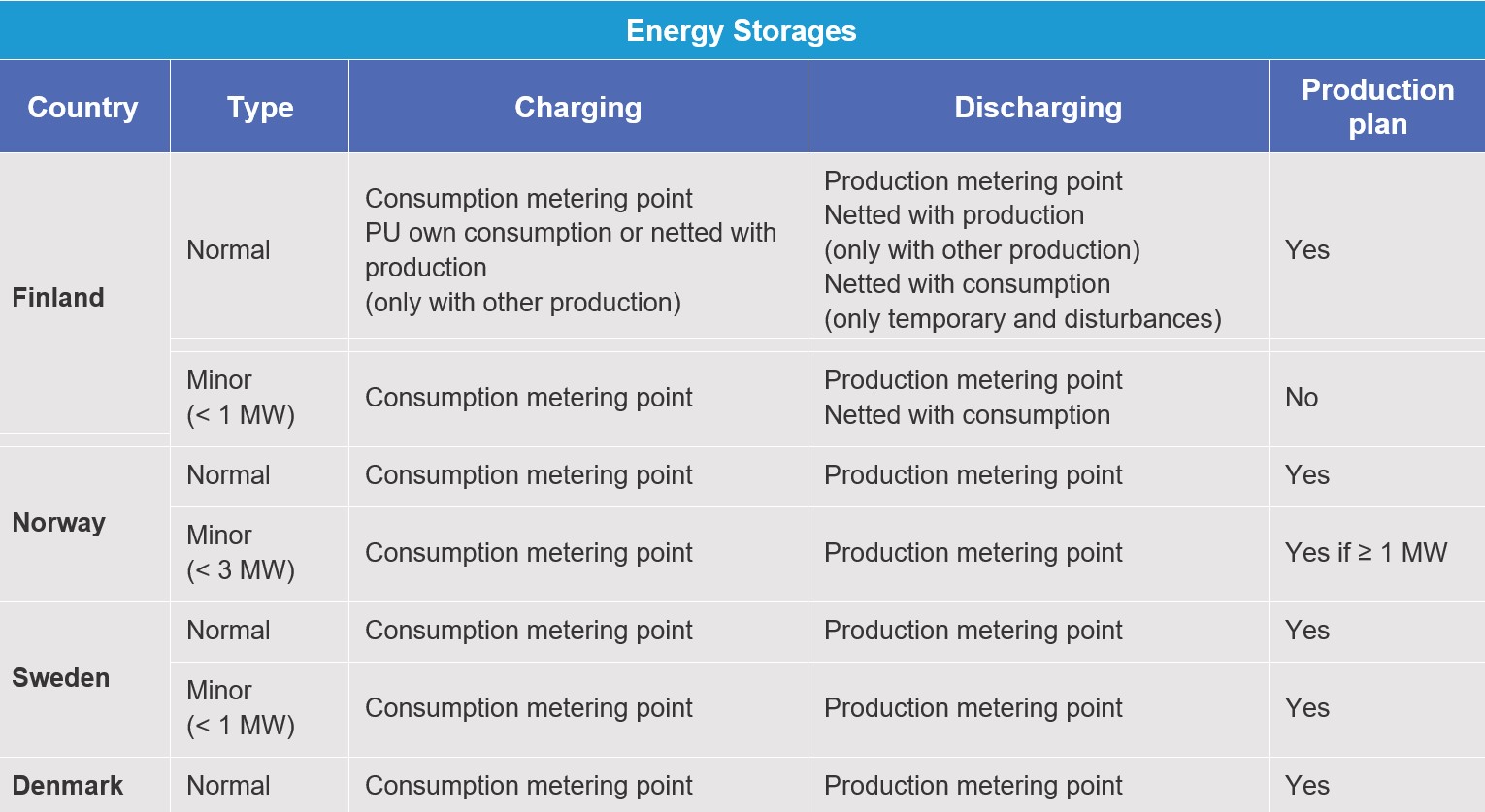
Table 8. Handling of energy storages in different countries.
In Finland, following rules are applied depending on the case:
- Energy storage with distribution/national grid:
- Energy storage of 1 MW or larger
- Discharging = Production
- Charging = Consumption
- Production plan is required for the discharging.
- Energy storages that are used for disturbance situations or for temporary use, can be also netted with the consumption.
- Under 1 MW energy storage
- Discharging can be netted with the consumption of the retailer.
- Energy storage of 1 MW or larger
- Energy storage with other production:
- When energy storage is connected to a power plant and the power plant is producing, charging of the energy storage can be handled as an own consumption. Charging and discharging of storage can be netted with the production of the plant.
- If the Power plant is not producing, energy storage will be handled as in with distribution/national grid.
- Energy storage with consumption:
- Under 1 MW energy storage can be netted with the consumption
- Energy storages with capacity of 1 MW or larger, that are used for disturbance situations or for temporary use, can be also netted with the consumption. Otherwise as in with distribution/national grid.
A standalone energy storage has been implemented into a distribution or transmission grid. Both generation (discharge) and consumption (charge) of the energy storage are metered by the same meter. This is illustrated in the Figure 11 below. In this case, the meter is a so-called two-way meter, and it is possible to measure energy in both directions. Both production and consumption during an imbalance settlement period, will be reported individually with type: Energy Storage.
In Finland, if the capacity of the energy storage is < 1 MW, the production can be netted with the other consumption of the same retailer in the area.
Following settlement structures are needed:
- Production metering point with type energy storage.
- Consumption metering point with type energy storage.

Figure 11.Meter for energy storage that can’t be netted with production or consumption.
This scenario is only allowed in Finland as described in chapter 4.6.1. An energy storage has been implemented together with production. This is illustrated in the Figure 12 below. Both generation (discharge) and consumption (charge) of the energy storage during an imbalance settlement period, can be netted with the production if the production ≠ 0.
Production (P) is calculated as: P = (1 + 2) if G > 0.
If the other production is zero, then both production and consumption during an imbalance settlement period, will be reported individually with type: Energy Storage.
Following structures are needed:
- Production metering point with the appropriate PU type.
- Consumption metering point with the type of PU Own Consumption if the charging exceeds the production.
- Production metering point with type energy storage, for ISPs when other production is zero.
- Consumption metering point with type energy storage, for ISPs when other production is zero.

Figure 12. Meter for energy storage that can be netted with other production.
This scenario is only allowed in Finland as described in chapter 4.6.1. An energy storage has been implemented together with consumption. This is illustrated in the Figure 13 below. In Finland, if the capacity of the energy storage is < 1 MW, or it is used for disturbance situations or for temporary use, the production can be netted with the other consumption.
In that case Consumption (C) is calculated as: C = (1 – 2).
If the capacity of the energy storage is ≥ 1 MW, both production and consumption during an imbalance settlement period, will be reported individually with type: Energy Storage.
Following structures are needed if netting is allowed:
- Production metering point with type energy storage if the discharging exceeds the consumption.
- Consumption metering point with appropriate type.

Figure 13. Meter for energy storage that can be netted with other consumption
The settlement data shall be reported to eSett via market messages or via Online Service. The reported data is further aggregated by eSett in order to establish the imbalance. Gate closure times differ depending on the data that is being reported. If one or more settlement data exceed the gate closure time, then the whole message will be rejected.
The metered data (production per PU, merged production data per RE and MGA, aggregated metered consumption data per RE and MGA, and MGA exchange data) shall be reported by the DSOs. The BRPs are responsible for reporting bilateral trades to eSett. BRPs are also obliged to keep their production plans updated, i.e. report updated values to local TSO. The BSPs shall report plans per RO and bids for up and down regulation to the TSOs. In certain cases BSPs are also responsible for reporting delivered reserves to eSett. Nominated Electricity Market Operator (NEMO) is responsible for reporting day-ahead and intraday trade results to the TSO and eSett. TSOs also report reserves and prices to eSett.
eSett performs validations on received data and publishes it in the Online Service. The settlement calculations and the weekly invoicing are then performed in the settlement IT system.
The verification of the bilateral trades and MGA exchanges is performed by verifying that values reported by the two counterparts are equal. If the values do not match, they will be changed according to pre-defined correction rules and a notification will be sent to both counterparts. The parties may however decide that only one party will report the values.
In the Nordic Settlement Model, the data is per imbalance settlement period, it is collected daily, reported within 2 days and updated within the stipulated 13 days. The reporting requirements for the DSO regarding the reporting flows and schedule are regulated by national laws.
All reporting in the Nordic Settlement Model shall be performed in accordance to the specification laid down in the market model for data exchange document Business Requirement Specification for Data Exchange in NBS (BRS). The latest version of the document can be found at the following address: https://ediel.org/.
This obligation is regulated as follows:
- Sweden: Regulated in the EDIEL-agreement between Market participants and Svk.
- Finland: Responsibilities are regulated in the secondary law and market participants should follow the instructions given by the TSO and instructions/procedures agreed in the energy field.
- Norway: Responsibilities are regulated in the secondary law and market participants should follow the instructions given in the Ediel User guide
- Denmark: Responsibilities for reporting are regulated in Danish electricity market regulations.
The reporting shall be performed with the accuracy, signs and units in according to the description below. For information on the reporting time periods and gate closures see chapter 5.3.
In cases where service providers are used to report e.g. metered values on behalf of a DSO, it is to be noted that the formal responsibility still remains with the DSO in accordance to national legislation.
The unit of reported values can be kWh or MWh according to the BRS. The resolution is the maximum in watt-hour, i.e. a maximum of three decimals in kWh and a maximum of six decimals in MWh.
In the current state, there are national differences in terms of the use of units and decimals:
- Sweden: according to industry agreement, meter values shall be reported in kWh with up to three decimals. Rounding is not permitted.
- Norway: meter values shall be reported in kWh with up to three decimals.
- Finland: at their most accurate, the data can be transmitted as MWh with six decimals and as kWh with three decimals, i.e. with an accuracy of 1 Wh. This requirement is in accordance with the Finnish Energy’s direction “Principles of electricity metering 2024” in chapter 8.2. The document is available at https://energia.fi/energiasta/energiamarkkinat/sanomaliikenne/ohjeet_ja_suositukset
- Denmark: Meter values shall be reported in kWh with up to 3 decimals according to Market regulation D1.
When reporting data to eSett, sign handling is given by the Business Requirement Specification for Data Exchange in NBS (BRS). When viewing data in the imbalance settlement system, the following will apply. Aggregated consumption and power exported from the MGA to an adjacent MGA will have a negative sign. Meter values from production units and import of power to the MGA from an adjacent MGA will have a positive sign.
All reported meter values have to be marked with a status (Quantity Quality according to BRS) indicating the quality of the metered values. The default status for all values is “Metered, i.e. Quantity Quality is only used if the status is ≠ “Metered”. The following statuses can be set in addition to “Metered”.
- Temporary
- Estimated, approved for billing
- Does not exist (only used for meter values at the metering point level).
The figures below illustrate the reporting data flows and are divided into: Reporting before delivery day, Reporting after delivery day and Reporting after the imbalance settlement is closed.
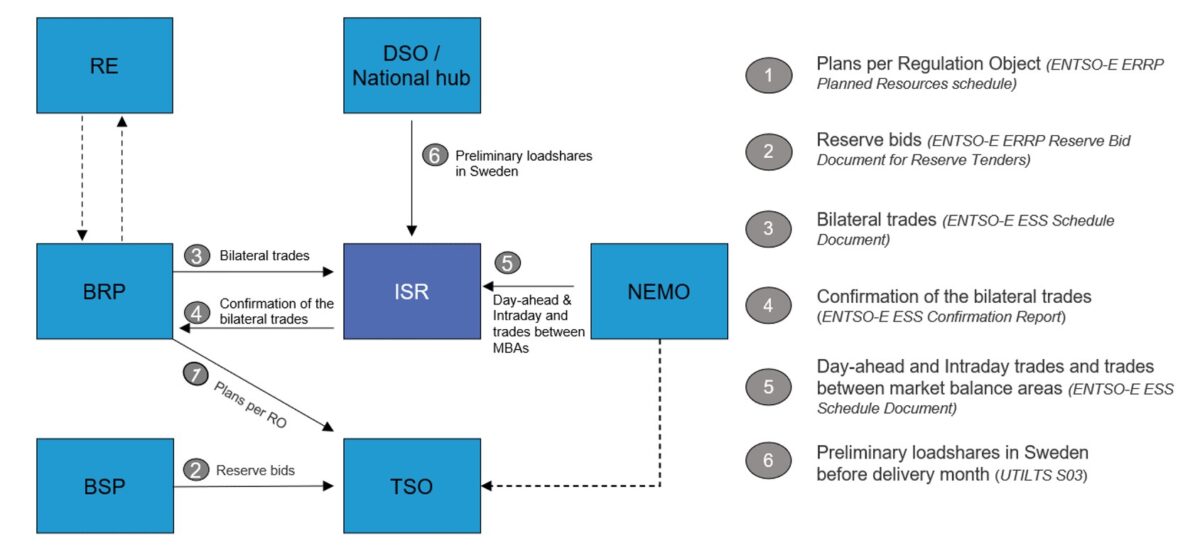
Figure 14. Reporting before delivery.
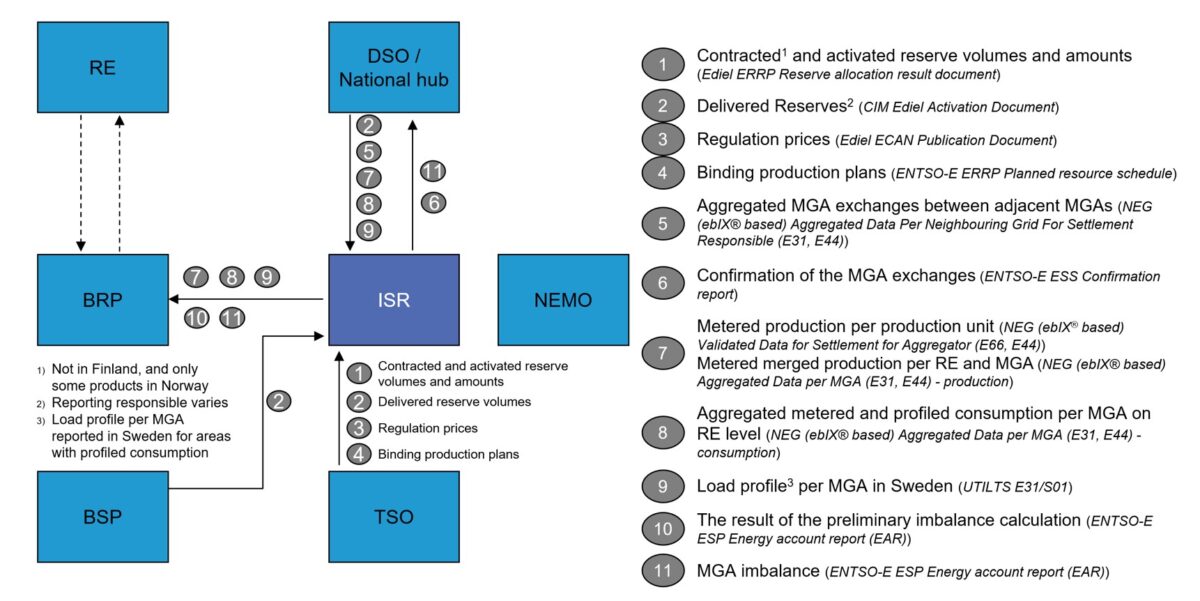
Figure 15. Reporting after the delivery (1-13 days)
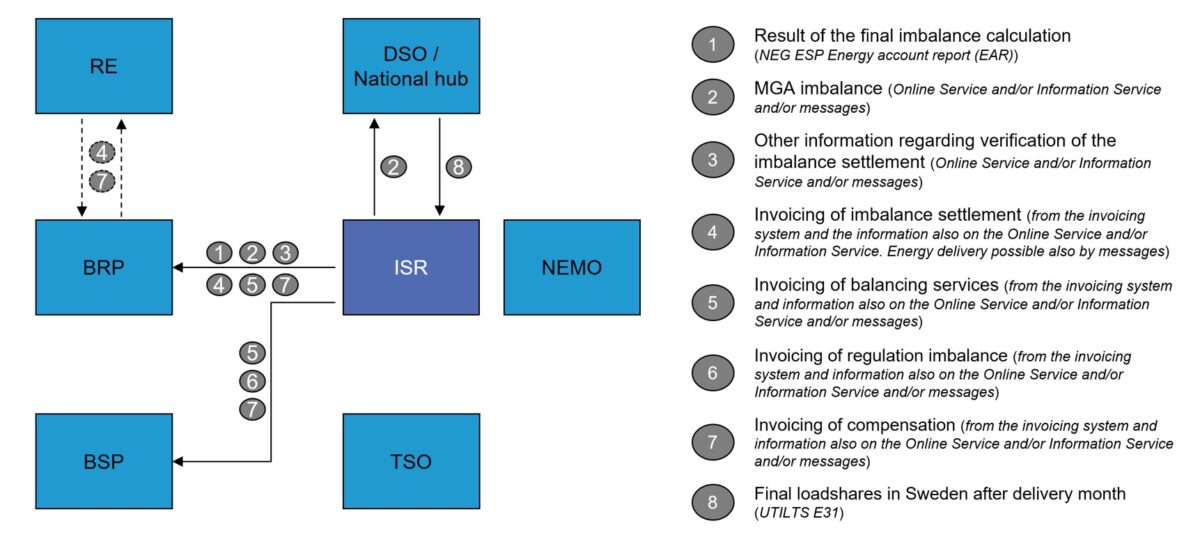
Figure 16. Reporting after the imbalance settlement has been closed (13 days)
Table 9 below shows how eSett reports information to the market participants and the communication channel.
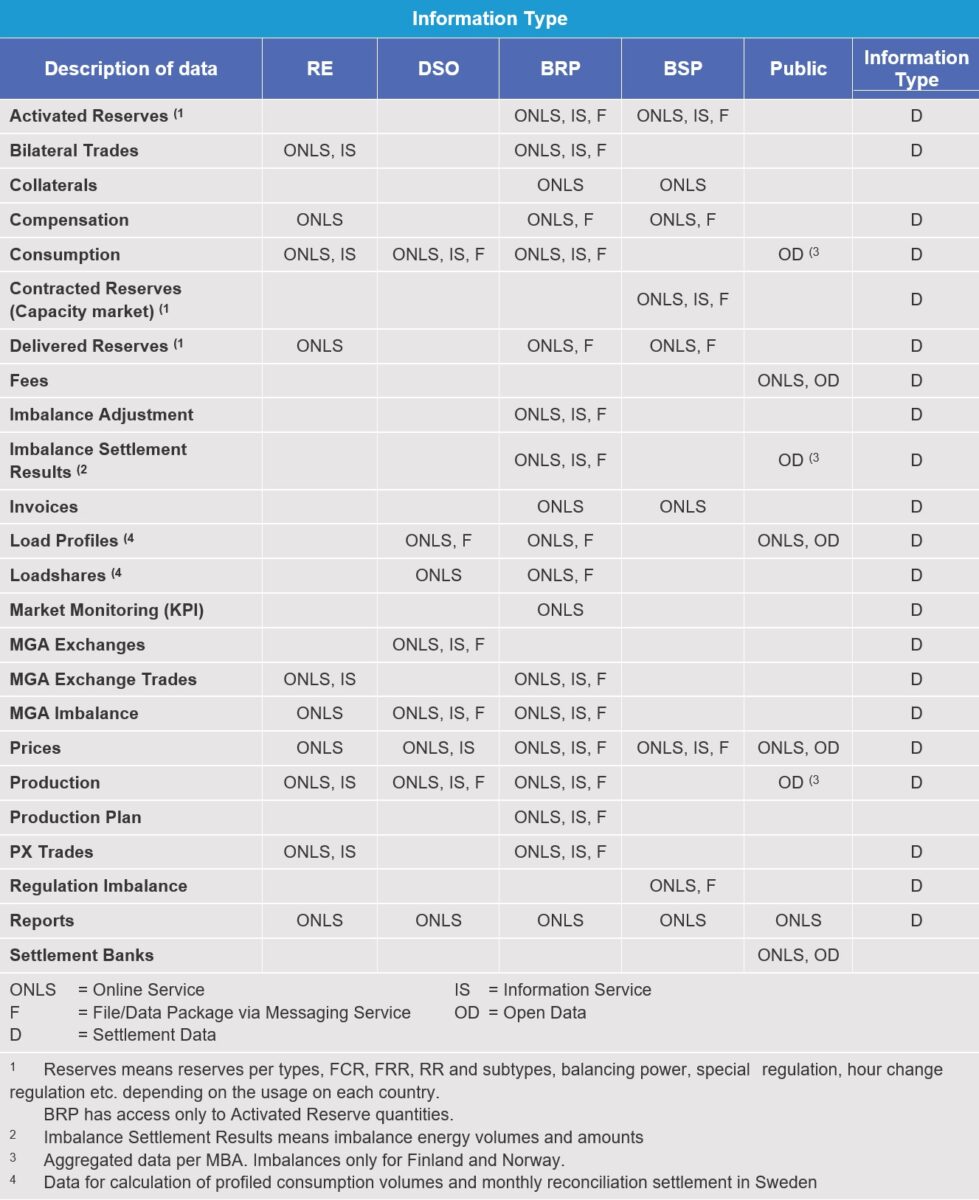
Table 9. Information types
The Nordic Settlement Model utilises the Nordic calendar in all reporting schedules.
The basis for the reporting schedule for DSOs is a 13-day period, during which the settlement data must be reported to eSett. The DSOs will report the meter data at the latest at 10.00 CE(S)T on the second day after the delivery day. Based on the reported data, eSett will conduct a preliminary imbalance settlement. The DSOs are then able to update the data until 12.00 CE(S)T on the 13th day after the delivery day, which is considered the final reporting day. During the next working day after the final reporting day, eSett will perform and publish the final result of imbalance settlement in the Online Service and in the Information Service.
In Norway, Norwegian DSOs report all their measurements to Elhub. They will then report all aggregated time series to eSett.
Based on Finnish legislation, the DSOs in Finland are able to report delivery day settlement data in EET/EEST until 00:00 EE(S)T on the 12th day after the delivery day.
Due to Swedish secondary legislation the DSOs in Sweden are able to report delivery day settlement data until the 13th day at 00:00 SNT after the delivery day.
In Denmark, Danish DSOs will report all their measurements to Energinet DataHub. They will then report all aggregated time series to eSett.
An illustrative picture of the settlement data reporting schedule for one delivery day is presented in Figure 17. In the figure, metered data for the Sunday in week 1 shall be reported at the latest on the second day after the delivery day, i.e. on Tuesday in week 2. Updates must be reported at the latest 13 days after the delivery day, i.e. on the Saturday in week 3 in the illustration below. The data may be reported daily for each day or just the changed values. By the end of Sunday in week 2, the data for Monday in week 1 is considered as final and may not be reported on Monday in week 3. By the end of the day on Saturday in week 3, all metered data for the whole week 1 is considered to be final, and final settlement is performed. Invoicing for week 1 is carried out on the first working day after the final reporting day (see more information about invoicing in Chapter 8, Invoicing).
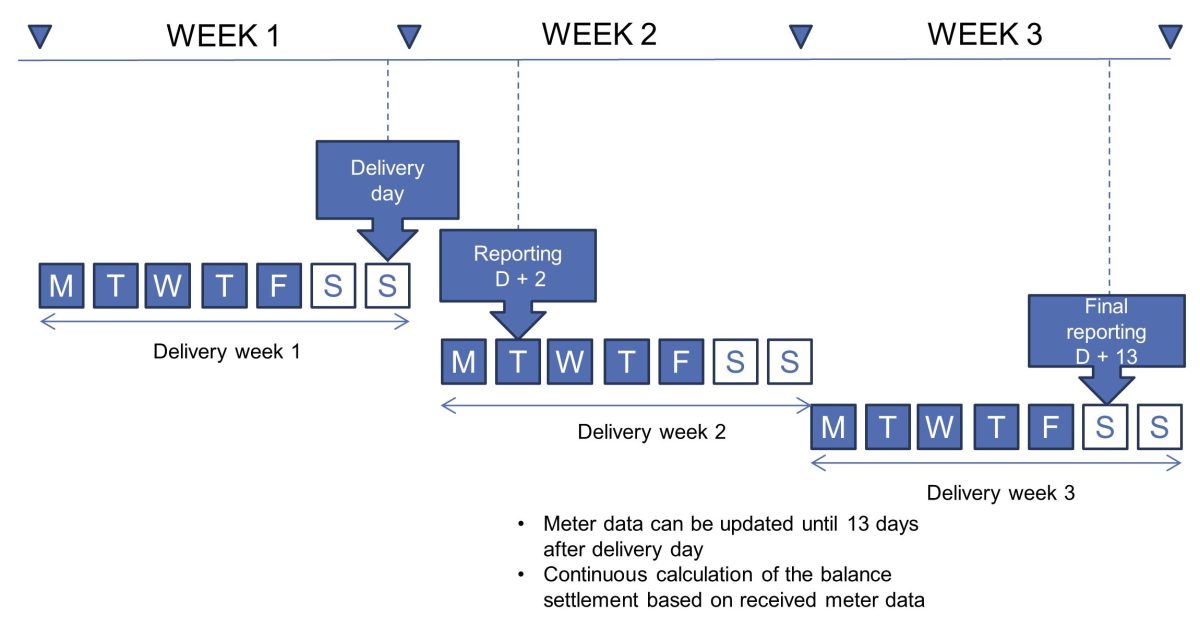
Figure 17. Time schedule for reporting imbalance settlement data.
The reporting roles and responsibilities per each Market Participant are presented in the chapters below. Data reporting tasks have been divided by the market role and the time when the data reporting takes place. In the last column of the tables the counterpart in each action is marked.
All bilateral trades shall be reported before gate closure (each ISP has its own gate closure). A bilateral trade shall be reported on a RE level. In the Nordic Imbalance Settlement Model eSett will aggregate data on BRP level. BRPs are responsible for reporting bilateral trades performed by REs that the BRP is responsible for. Bilateral trade values are verified by eSett’s imbalance settlement system.
The reported values by the two counterparts must match; if the values do not match the imbalance settlement system corrects the values according to pre-defined correction rules and sends notification to both parties involved. The BRPs can then take action as described in the procedure below. It is possible that only one BRP submits the bilateral trade, the correction rules (matching) will then be applied.
The correction rules are the following (in case of values not matching):
- If both BRPs report a sale, zero will be used
- If both BRPs report a purchase, zero will be used
- If one BRP reports sale and the other reports purchase, the lowest absolute value per ISP will be used (zero is considered as a number)
- If only one of the BRPs have reported values, those values will be used
1st gate closure for bilateral trade is 45 minutes before the ISP in NO and SE while in DK it is 20 minutes and in FI it is 0 minutes before the ISP. Matching will be performed every time a bilateral trade is received from the BRPs. When the matching is done, an Intermediate Confirmation Report (iCNF) will be sent to both BRPs by file.
The iCNF will include the matched value and the difference between the reported values (delta). The delta is calculated as:
∆ = VALUE BRP SALE – VALUE BRP PURCHASE
2nd gate closure for bilateral trade is at 24:00 next working day after the delivery day. The matching process will, between the 1st and 2nd gate closure, be as follows:
- ISPs where there is a match:
- The involved BRPs shall immediately after the 1st gate closure receive a final confirmation report (fCNF) for those ISPs where there is a match.
- ISPs where match is achieved by acceptance of the counterpart’s values:
- The BRPs have the possibility to manually accept to use the counterparts’ values for ISPs where there is no match on the Online Service. The BRP may do this ISP by ISP or for a longer time period in the same operation.
- Both BRPs have equal rights to accept to use the counterparts’ values. This is based on the “first come first serve” principle. The values can only be corrected once between 1st and 2nd gate closure.
- For ISPs where one of the BRPs has chosen to accept the counterpart’s values, a fCNF will be sent short time after acceptance.
- After the 2nd gate closure (24:00 next working day after the delivery day):
- fCNF will be sent for the bilateral trades of the previous day.

Table 10. BRP’s responsibilities.
Before delivery:
- Report bilateral trades
- 0 minutes before ISP in Finland
- 20 minutes before ISP in Denmark
- 45 minutes before ISP in Sweden and Norway.
After gate closure:
- The party may accept the counterparty’s values the next working day after delivery day before 24:00 CE(S)T.
The BSPs may be responsible for reporting of their own delivered reserves data per RO, RE, MGA, balancing sub-service and method to eSett, which will then aggregate data on RE level per MGA and per type. In some countries there is also a possibility to report the data per RO, BRP, MBA, balancing sub-service and method, which will then aggregate to data on BRP level per MBA and per type.
The methods for delivered reserves are: own resources, independent aggregation and contractual (i.e. BSP has made an agreement with the supplier and the BRP of the reserve resource about the usage in balancing services).
Additionally in Finland, BSP with contractual delivered reserves may report also misdelivery. It is reported with the same file and rules as delivered reserves but with a reserve object status “delta” and signed values. Misdelivery is the difference between delivered reserves and activated reserves for which the Balance Responsible Party (BRP) is responsible. With misdelivery, the BSP allocates the regulation imbalance to the BRP’s responsibility. For example, if a quantity of 3 was activated but only 2 was delivered, and the responsibility of the error is BRP’s, BSP may report a misdelivery of -1 (deficit).
The delivered reserve will be reported by BSP on the following scenarios per country:
Finland:
- BSP’s delivered reserves are method ‘independent aggregation’ and balancing service type is aFRR.
- Reported per RO, RE, MGA and balancing sub-service.
- BSP’s delivered reserves are not method ‘independent aggregation’ but delivery comes from multiple BRPs per RO, and balancing service type is aFRR.
- Reported per RO, BRP, MBA and balancing sub-service, or per RO, RE, MGA and balancing sub-service.
- BSP’s delivered reserves are a combination of method ‘independent aggregation’, and other method(s), and balancing service type is aFRR.
- Independent aggregation reported per RO, RE, MGA and balancing sub-service.
- Other method(s) reported per RO, BRP, MBA and balancing sub-service, or per RO, RE, MGA and balancing sub-service.
Additional information may be found from “Fingrid’s reserve trading and information exchange guideline” document: https://www.fingrid.fi/en/electricity-market/reserves-and-balancing-power/reserve-products/reserve-trading-and-information-exchange/.

Table 11. BSP’s responsibilities
0-2 days after the delivery
- Report delivered reserves data before 10:00 CE(S)T the second day after delivery day.
- Delivered reserves data reported to eSett.
- Report updated delivered reserves data before 12:00 CE(S)T the 13th day after delivery day.
The DSOs are responsible for reporting MGA exchanges. Both DSOs are expected to report the MGA exchange, but the correction rules take into consideration that only one DSO might report. The imbalance settlement IT system verifies the reported MGA exchanges and checks if the values match between the two counterparts. If the values do not match, the values are changed according to pre-defined correction rules. After this the imbalance settlement IT system sends a notification to the counterparts. The notification is sent to the DSOs and will also be visible on the Online Service. The notification contains information about the new corrected value.
Correction rules for MGA exchanges:
- If both DSOs report export, zero will be used.
- If both DSOs report import, zero will be used.
- If one DSO reports export and the other reports import, the lowest absolute value per hour will be used (zero is considered as a number).
- If only one of the DSOs have reported values, these values will be used.
The DSO verifies the corrected MGA exchanges values. If the time period is still open, the DSO can initiate the sending of new values either via the Online Service or in an electronically sent message. If the time period is closed, the DSO can only view what the corrected value was set to.
The matching process will be, during the period between the 2nd day after the delivery day and 13 days after delivery day, as follows:
- 2nd day after the delivery day
- Matching will be performed every time MGA-MGA exchanges is received.
- An iCNF (intermediate confirmation report) will be sent to both DSOs. The iCNF will include the delta and the matched value.
- 13 days after delivery day
- fCNF (final confirmation report) will be sent for all ISPs of the relevant period.
If the two MGAs of an MGA exchange are located in different countries with different reporting schedules, the stricter reporting schedule is applied for both DSOs for reporting values to the MGA exchange.
Figure 18 below illustrates how the DSO will aggregate the MGA exchange when reporting. The sum of the exchange measurements (1-5) will be reported to eSett.
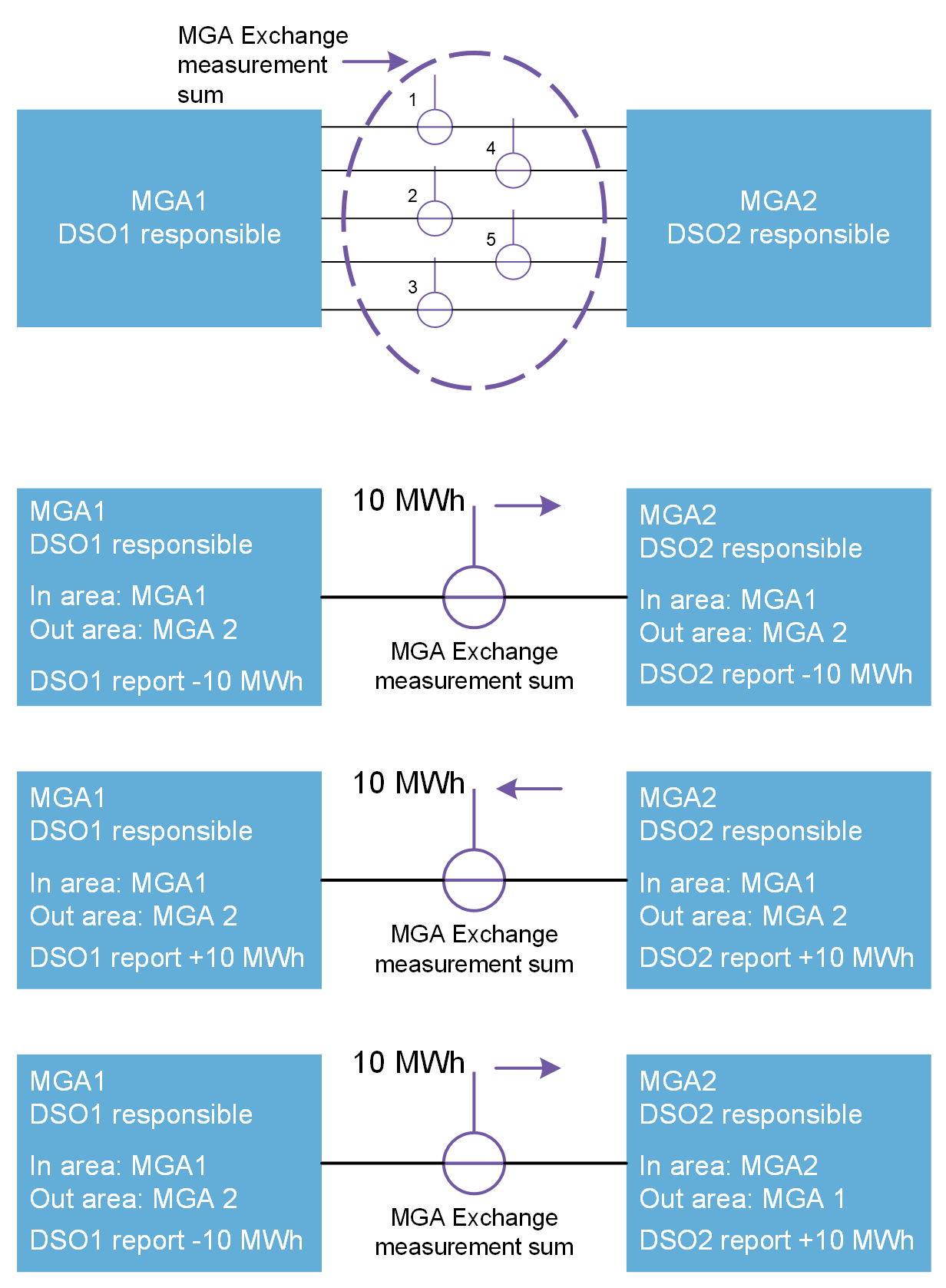
Figure 18. Example of MGA exchange reporting.
The DSO will be responsible for reporting metered data per production unit to eSett, which will then aggregate metered data on BRP level per MGA and per type. In some countries there is also a possibility to report metered merged production data per RE, MGA and type, which will then aggregate to metered data on BRP level per MGA and per type.
The production unit types can be for example: hydro, wind, nuclear, solar and thermal.
In Sweden production with installed capacity < 1 MW should be reported as merged production per RE, production unit type and MGA with production type minor.
In Finland, minor production (< 1 MW) should be merged to one PU per RE, production unit type and MGA with production type minor. That is, when the minor production exceeds retailers aggregated consumption. This production will then also be reported per production unit with the production type minor.
In Denmark, all production will be reported by the national electricity market hub as merged production per RE and MGA with production unit type other and production type normal.
The DSO will be responsible for reporting metered data to eSett. The DSO will report aggregated metered values per RE and MGA.
The aggregated consumption will be reported on the following types per country:
Sweden:
- Metered consumption
- Preliminary profiled consumption (i.e. consumption that is metered on a monthly basis)
- Metered interruptible consumption
- Interruptible consumption means objects that can be controlled and switched off completely, which for example electric boilers, heat pumps or the equivalent (the requirement is that it is hourly metered)
- Disconnecting them can adjust consumption to the current market situation (influenced by the price of electricity) or reduce power to the electrical system
- Metered industry consumption over 50 MW
- Industry consumption over 50 MW is reported as an own RO in Sweden, implying that consumption plans are reported per RO
- Profiled and metered losses
- Losses per MGA are calculated based on the MGA exchange, metered production and metered consumption as follows:
- Profiled losses = – (MGA exchange + metered production + metered consumption + preliminary profiled consumption)
- Metered losses: – (MGA exchange + metered production + metered consumption)
- Losses per MGA are calculated based on the MGA exchange, metered production and metered consumption as follows:
Norway:
- Metered consumption
- Preliminary profiled consumption (i.e. consumption that is metered on a monthly basis)
- Profiled and metered pumped
- The profiled and metered pumped consumption are used for pumps that are used to pump water from one waterway to another so that it can be utilized in the production units.
- The profiled and metered pumped consumption will be deducted from the production before these guarantees of origin are issued.
- Metered pumped storage
- Norway has a significant installed capacity of combined pump and generation units; production units that can reverse the turbine so that it acts like a pump. These units represent added flexibility for upward and downward regulations compared to normal production units. In order to ensure an efficient handling of this flexibility the BRP will place a single bid for reserves to the TSO including both production and consumption. Up regulation can be delivered as reduction of pumping, increased production or a combination of the two.
- Losses
- Losses per MGA are calculated according to existing Elhub Edielstandard.
Finland:
- Metered consumption
- Preliminary profiled consumption (i.e. consumption that is metered on a monthly basis)
- Losses
- Losses per MGA are calculated based on the MGA exchange, metered production and metered consumption as follows:
- Losses = – (MGA exchange + metered production + metered consumption + preliminary profiled consumption)
- Losses per MGA are calculated based on the MGA exchange, metered production and metered consumption as follows:
Denmark:
- Metered consumption
- Flex-settled consumption
- Flex-settlement is used for metering points with an annual consumption of less than 100,000 kWh, where the grid operator continuously remote-reads and distributes values, and where these values are used for imbalance settlement.
The DSO will be responsible for reporting of load profiles per MGA per ISP to eSett. This applies for DSOs in Sweden that have profiled consumption in their MGAs. Load profiles are used for the calculation of profiled consumption volumes per BRP and MGA in Sweden, as well as for the reconciliation settlement.
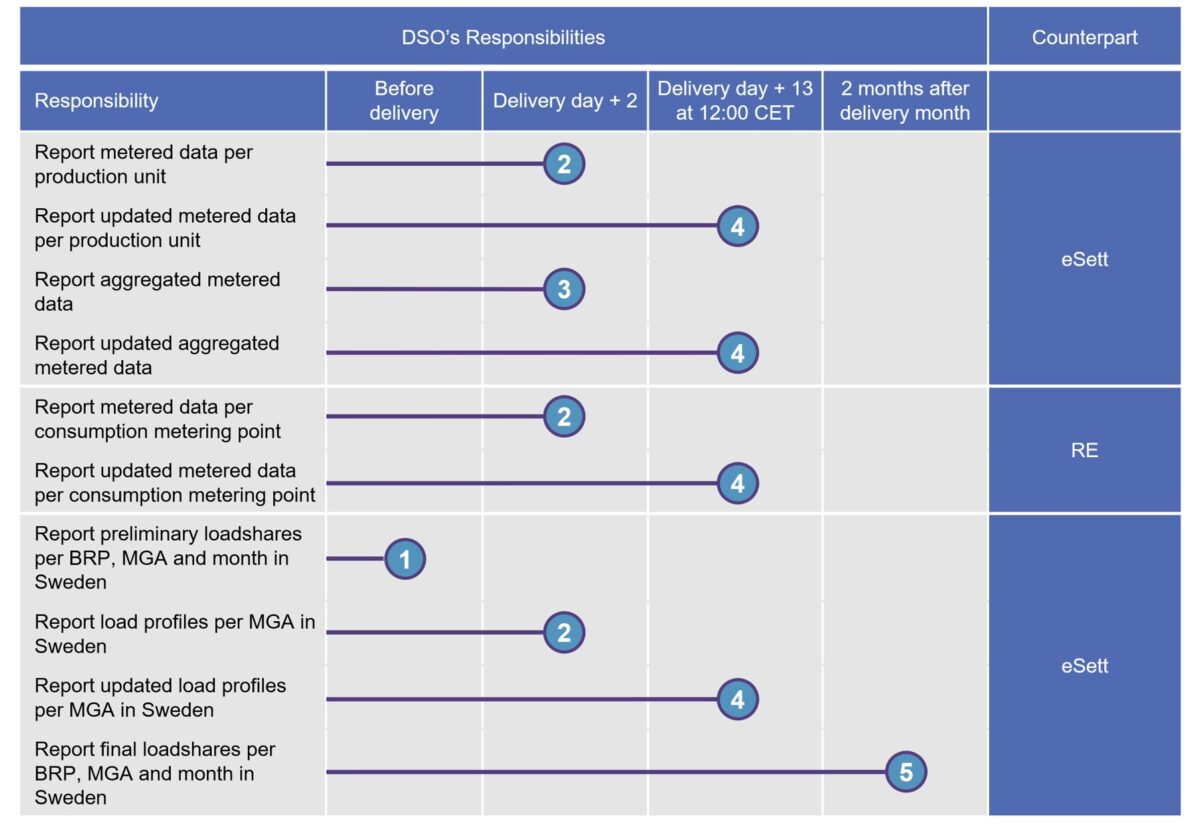
Table 12. DSO’s responsibilities.
Before the delivery month:
- Report preliminary load profile shares latest two days before delivery month:
- Only for MGAs with BRP level profiled consumption in Sweden
- Loadshare data per BRP per MGA per month separated for types general and losses
0-13 days after the delivery day:
- Report metered data before 10:00 CE(S)T the second day after delivery day:
- Metered data on production reported to eSett and RE per production unit
- Metered data per consumption metering point reported to RE
- Load profile data per MGA reported to eSett and BRPs
- Report aggregated metered data before 10:00 CE(S)T on the second day after delivery day. Metered data should be available at eSett’s database for BRP and RE as an aggregated volume per RE. Missing daily collected metered data in a single metering point must be estimated, according to national practice / regulations by the DSO before aggregation.
- Per MGA aggregated metered data from exchange metering points to eSett
- Per MGA aggregated metered consumption data per RE to eSett
- Per MGA aggregated preliminary profiled consumption per RE to eSett
- Per MGA aggregated merged production data per RE to eSett
- Report updated metered data before 12:00 CE(S)T the 13th day after delivery day.
- Report final load profile shares before the end of second month after delivery month:
- Strong recommendation for reporting initial metered data latest on the 15th of the second month after the delivery month
- Only for MGAs with profiled consumption in Sweden
- Loadshare data per BRP per MGA per month separated for types general and losses
eSett performs preliminary and a final settlement and reports/publishes the results after each settlement. The result after the preliminary settlement will be reported the 2nd day after delivery day. eSett performs regularly preliminary settlement calculations and publish the results on the Online service. The result of the final settlement will be reported the 1st working day after DSOs final reporting day (D+13).
The details regarding eSett’s reporting and publishing of the settlement data includes for example information listed in sections below. The data may be available as a data flow after subscription, on the Online Service or both.
Details of data that eSett provides as a data flow regarding Swedish profiling and reconciliation is listed in Table 33 UTILTS Data Packages for Swedish profiling and reconciliation. Further details of eSett publishing data can be found from Appendix 3.
- Aggregated production plan per BRP and MBA
- Aggregated production plan per BRP and RO
- Aggregated normal production per BRP and MBA
- Aggregated minor production per BRP and MBA
- Aggregated consumption per BRP and MBA
- Aggregated consumption per type per BRP and MBA
- Aggregated consumption per RE and MGA
- Aggregated pump storage consumption per BRP and MBA
- Calculated MGA imbalance per BRP and MGA
- Aggregated MGA trade import and export per BRP and MBA
- Aggregated MGA imbalances (surplus and deficit) per BRP and MBA
- Aggregated day-ahead trades (purchase and sales) per BRP and MBA
- Aggregated intraday trades (purchase and sales) per BRP and MBA
- Aggregated bilateral trades (purchase and sales) per BRP and MBA
- BRP-related reserve data (quantities) per type per BRP and MBA
- Imbalance purchase and sales (volumes and amounts) per BRP and MBA
- Production and consumption Imbalance Adjustments up and down per BRP and MBA
- Relative imbalance per BRP and MBA
- Imbalance and regulation prices per MBA
- Activated reserves per type per BSP and MBA
- Contracted reserves per type per BSP and MBA
- Delivered reserves per type per BSP and MBA
- Compensation purchase and sales (volumes and amounts) per BSP, MGA and type
- Regulation imbalance purchase and sales (volumes and amounts) per BSP and MBA
- Imbalance and regulation prices per MBA
- Aggregated metered production per MGA
- Aggregated metered consumption per MGA
- MGA imbalances
- MGA exchanges
- Aggregated metered production per RE and MBA
- Aggregated metered consumption per RE and MBA
- Aggregated bilateral trades per RE and MBA
- MGA exchange trade per RE and MGA
- RE-related delivered reserves per type per RE and MGA
- Compensation purchase and sales (volumes and amounts) per RE, MGA and type
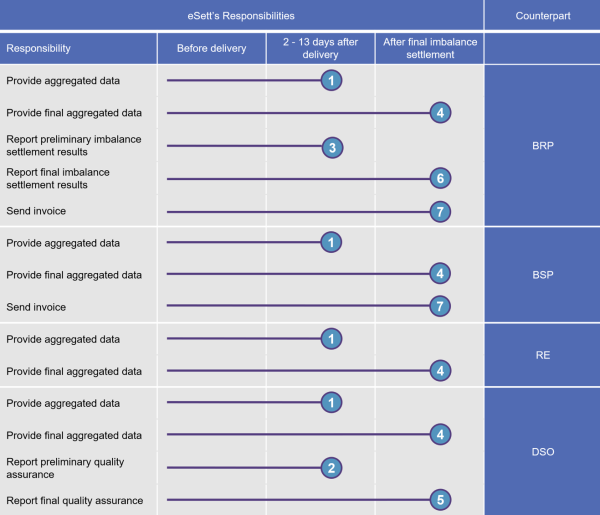
Table 13. eSett’s responsibilities.
2-13 days after delivery:
- Provide aggregated data to BRP, BSP, RE and DSO
- Report preliminary quality assurance (MGA imbalance) on area balance per MGA to DSO
- Report preliminary settlement results
After final imbalance settlement:
- Provide final aggregated data to BRP, BSP, RE and DSO
- Report final quality assurance (MGA imbalance) on area balance per MGA to DSO
- Report final settlement results
- Send invoice for one delivery week electronically to the BRP and BSP on the next working day after the final reporting day of the week
NEMO will report the Day-ahead and Intraday trades to its customers and eSett. Day-ahead and Intraday Auction trades will be reported when NEMO has completed the price calculation and continuous Intraday trades will be reported continuously. The Day-ahead and Intraday trades will be reported per RE and per MBA.
NEMO will report Day-ahead and Intraday flows between respective MBAs to eSett and TSOs.
NEMO will report Bilateral Trades between NEMOs per MBA to eSett.
Final values of PX market trades, PX market flows and Bilateral trades to be reported to eSett latest D+13 12:00 CE(S)T after the delivery day and to TSOs according to the agreements between NEMO and TSOs.
The day-ahead market price is calculated by algorithm called EUPHEMIA (acronym of Pan-European Hybrid Electricity Market Integration Algorithm) that calculates day-ahead electricity prices across Europe, and allocates cross border transmission capacity on a day-ahead basis. The day-ahead market price is based on the sale and purchase orders from market participants in all available day-ahead markets. The day-ahead market price is used as a reference price for trading and clearing of most financial contracts in the Nordic countries.
The Day-ahead market is divided into several market balancing areas and the available transmission capacity may vary and congest the flow of electrical energy between the areas. Hence, different area prices are established.
Area prices are calculated and published by the NEMOs, which are then reported to eSett.
Table 14. NEMO’s responsibilities.
Before delivery:
- Report all Day-ahead trades, flows, Bilateral trades and Day-ahead prices made for the next day to eSett and market participants active in PX market. Report all Intraday trades and flows and Bilateral trades before the delivery to eSett and market participants active in PX market.
0-13 days after the delivery day:
- Report delivery day final Day-ahead trades, flows, Bilateral trades and Day-ahead prices to eSett and market participants active in PX market latest D+13 12:00 CE(S)T. Report delivery day final Intraday trades, flows and Bilateral trades to eSett and market participants active in PX market latest D+13 12:00 CE(S)T.
The BSP shall place bids in the Balancing Markets operated by the TSO. The TSO will report the services provided by the BSP to eSett. The TSO reports the activated reserves per RO and balancing sub service, volumes and amounts. Energinet, Statnett and Svenska kraftnät report also the contracted reserve volumes and amounts per balancing sub service. Reporting is carried out the day after delivery and there are national differences regarding balancing service sub types which will be applied. eSett aggregates the reported activated reserves to imbalance adjustments.
The BSP shall place bids in the Balancing Markets operated by the TSO. The TSO will report the services provided by the BSP to eSett. The TSO reports the activated reserves per RO and balancing sub service, volumes and amounts. Energinet and Svenska kraftnät report also the contracted reserve volumes and amounts per balancing sub service. Reporting is carried out the day after delivery and there are national differences regarding balancing service sub types which will be applied. eSett aggregates the reported activated reserves to imbalance adjustments.
The 15-minute automated mFRR energy activation market (EAM) uses the European standard product from the Manually Activated Reserves Initiative (MARI) platform. When reserves are activated for mFRR, ramping before and after the activation ISP is accounted for in the energy volumes. Activation amounts are however reported solely for the activation ISP (scheduled activation) or ISPs (direct activation) using its price. Figure 19 illustrates both an ideal ramp for scheduled activation, showing activation volumes affecting three ISPs, and a direct activation, showing activation volumes affecting four ISPs. The respective imbalance adjustments for BRP follow the quantities while the activation amounts shall be reported and paid in accordance with one or two main ISPs.

Figure 19. Ramping of volumes on mFRR activations over three or four imbalance settlement periods.
The TSOs are responsible for reporting of delivered reserves data to eSett if independent aggregation is allowed in the country and for the balancing sub-service, and the responsibility doesn’t fall under the BSP’s responsibilities. TSO may also use a national hub for the reporting instead. Delivered reserve data is reported per RO, RE, MGA, balancing sub-service, or per RO, BRP, MBA and balancing sub-service and method. eSett will then aggregate data on RE level per MGA and per type, and on BRP level per MBA and per type.
Delivered reserve usage and responsibility per country:
Finland:
- Used for following balancing sub-services:
- Reported by Balancing Service Provider (BSP) (see chapter 4.2.1) or by Fingrid.
- Fingrid reports data per RO, BRP, MBA and balancing sub-service and method.
The regulation prices are calculated in the pricing module. Prices are reported by the TSOs to eSett continuously as they become official.
The TSO reports the binding production plans to eSett based on the BRPs reporting. The binding production plans are per BRP and RO. In Denmark, production plan values are not reported to eSett.

Table 15. TSO’s responsibilities
Before delivery:
Check consistency of the data reported by BRP and BSP and request correction if needed.
Short time after delivery:
- All activated reserves, contracted reserves and any other agreed BSP-TSO trades during delivery day are reported to BSP and eSett.
- Report binding production plans to eSett
In Sweden, Svenska kraftnät shall report the binding TSO-TSO matched NEMOs Intraday flows to eSett based on the NEMOs reporting. eSett shall receive the binding NEMOs Day-ahead flows as part of the daily single day-ahead coupling operations.
The data is reported electronically via market messages from the market participant’s IT system to eSett’s imbalance settlement system or entered in the Online Service. In abnormal situations, the data can be reported by e-mail or phone directly to eSett’s personnel. Before aggregation, the syntax and content of the incoming data are validated by eSett’s settlement system in order to ensure that the data can be used in the settlement calculations. The reporting parties are informed about the validation result (e.g. via acknowledgement messages). After validation, the data is stored in eSett’s settlement system and the imbalance settlement calculations are performed.
Both the data sent by market participants and the final calculated settlement data are published in the Online Service so that they can be verified, and possible errors can be reported to eSett. In addition, the market participants are given the opportunity to utilise the Information Service, which provides the market participants with the settlement data (as time series data) that they are entitled to see. The Information Service (presented in Chapter 10.3 Information Service) is established as a machine-to-machine interface and made available to market participants authorised by eSett.
The market participants themselves are responsible for the accuracy and quality of the reported data. eSett sends and publishes the data received from the parties and is not able to verify the correctness of the received data.
A disturbance in the market participant’s solution does not discharge the market participant from the liability to report the settlement data to eSett. If the market participant is unable to report the settlement data electronically due to a disturbance in the market participant’s solutions, the settlement data shall be reported via the Online Service.
If the reporting cannot be performed due to a disturbance in eSett´s IT solution, the messages will be received in the same order as they have been sent to eSett once the disturbance is over.
In the Nordic Settlement Model, the settlement of BRPs’ imbalances is based on the harmonised Nordic model which was implemented in all Nordic countries 2009 and updated in 2021. The updated model is based on single imbalance calculated and settled.
Settlement of balancing services involves aggregation and invoicing of the balancing capacity and balancing energy for the BSPs. It may also include applying of compensation model and calculating regulation imbalances for BSPs.
Reconciliation settlement is done according to national practices. In the reconciliation settlement, the difference between preliminary and final profiled consumption is settled between BRPs. A general approach is presented for all countries, and a more detailed model for Sweden, which eSett is responsible for.
Imbalance volume is calculated as the deviation between consumption, metered production, trades, MGA imbalance and imbalance adjustment. The applied pricing model is described in detail in chapter 7 Pricing and Fees.
eSett will conduct a preliminary imbalance settlement every day starting from the second day after the delivery day until the final settlement 13 days after delivery.
Imbalance volumes are calculated as follows:

The BRPs, BSPs and the DSOs are responsible for resolving possible errors with the counterpart within the reporting window. DSOs and BSPs have at most 13 days to correct and resubmit erroneous data before eSett invoices the imbalances and balancing services. The reporting responsibilities and schedules are presented in chapter 5 Settlement Data Reporting. No corrections of the settlement will be made by eSett after the invoice has been created and submitted.
The imbalance volumes are calculated based on received settlement data. The calculation is performed per MBA at BRP level and includes data from the parties in the BRP’s balance hierarchy, using relations in the structure information (e.g. BRP’s responsibility over REs).
The imbalance is composed of a BRP’s trades, consumption, production, MGA imbalance and imbalance adjustment up and down. For example, a balance deviation in the imbalance arises when there is a difference between the consumption, production and electricity purchases and sales. If the BRP consumes and sells more electricity than it produced and purchased, there is a deficit in the imbalance, and the BRP is required to purchase the imbalance energy from eSett in order to cover the deficit.
Correspondingly, if the BRP produces and purchases more electricity than it consumed and sold, there is a surplus in the imbalance, and the balance responsible party sells imbalance energy to eSett in order to take care of the surplus.
Imbalance is calculated from the input data in the imbalance settlement system delivered by market participants. This data contains metered and profiled consumption per RE per MGA, metered production per production unit, MGA exchange per MGA per adjacent MGA, day-ahead and intraday trades per RE per MBA, bilateral trades per counterpart per MBA and imbalance adjustments (sum of Frequency Containment Reserves (FCR), Frequency Restoration Reserves (FRR) and Replacement Reserves (RR)).
Based on the delivered data the metered and profiled consumption per BRP in MBA, metered production per BRP in MBA, MGA imbalance per BRP in MBA, MGA exchange trade per BRP in MBA, day-ahead, intraday and bilateral trades per BRP in MBA and imbalance adjustment up and down per BRP in MBA are calculated by eSett. Altogether the result is imbalance per BRP in MBA. Calculation of the imbalance is shown in Figure 20.
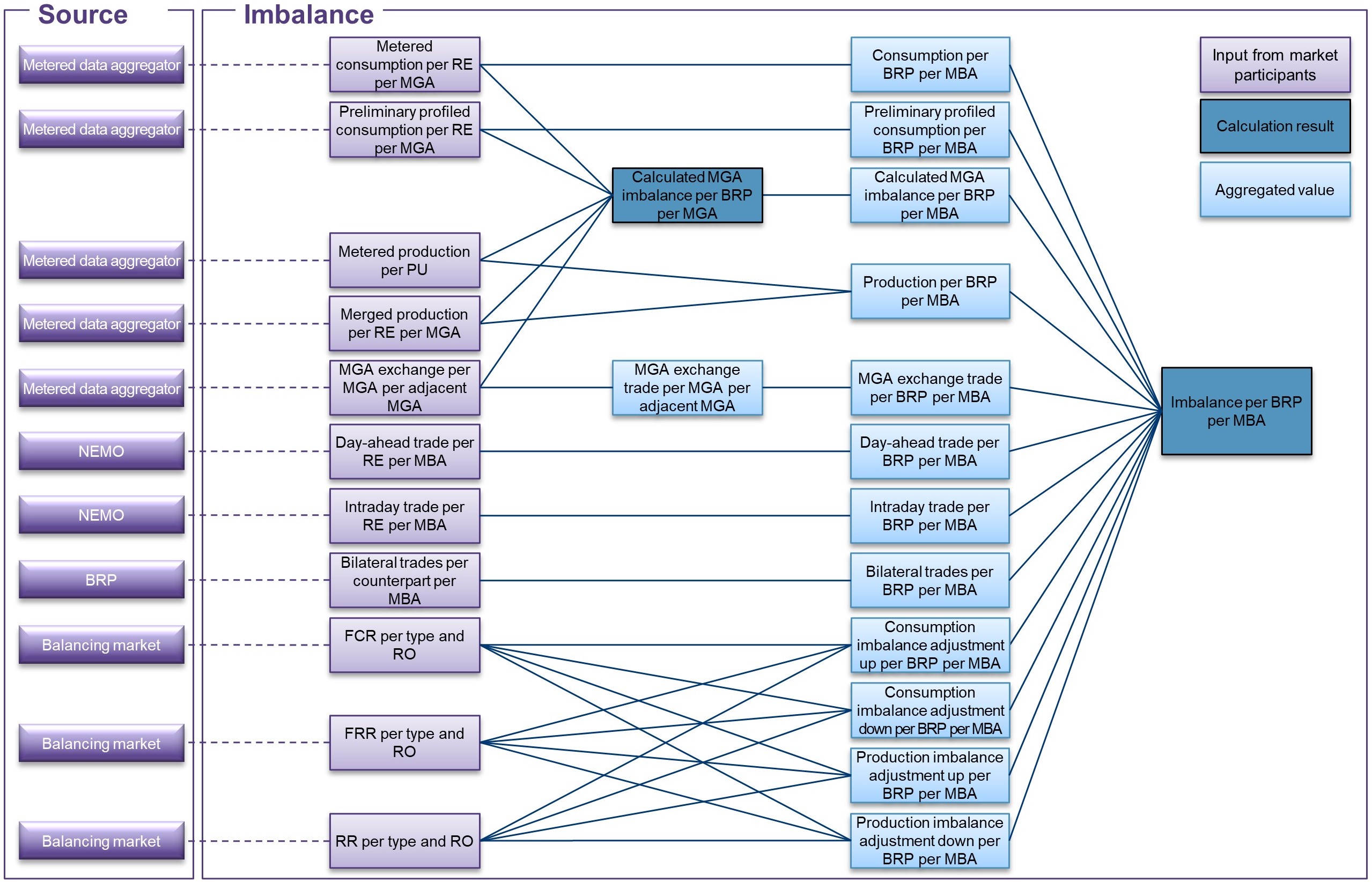
Figure 20. Calculation of imbalance settlement
In Sweden the preliminary profiled consumption is calculated by eSett per BRP in MGA instead of retailer in MGA. DSOs are responsible for reporting loadshares and load profile if they have profiled consumption in Sweden.
eSett calculates the MGA imbalance based on reported values from the Metered Data Aggregator. MGA Imbalance will be an input to the imbalance calculation and calculated as follows:
MGA Imbalance = Consumption + Production + MGA exchange import per adjacent MGA + MGA exchange export per adjacent MGA
eSett calculates the Imbalance Adjustments based on aggregated reported delivered reserves, if it is in use for the combination of country and balancing sub-service. If delivered reserves are not used, the adjustments are calculated from the activated reserves from the TSO. Imbalance adjustment is applied in the imbalance settlement the impact of the balancing services. For example, up regulation of production causes an “unplanned” increase on the BRP’s production. Therefore, the imbalance adjustment is applied with a negative sign to cancel out the increase.
In Finland, if the BSP has reported misdelivery for delivered reserves, it is also taken into account for the BRP’s imbalance adjustment calculation.
Imbalance Adjustment (up) = – Delivered Reserves (up) – Activated Reserves (up) + Misdelivery (up)
Imbalance Adjustment (down) = Delivered Reserves (down) + Activated Reserves (down) – Misdelivery (down)
In this chapter an example of the BRP’s imbalance calculation is presented. The example is made from the BRP´s perspective (see Table 16 and Table 17).
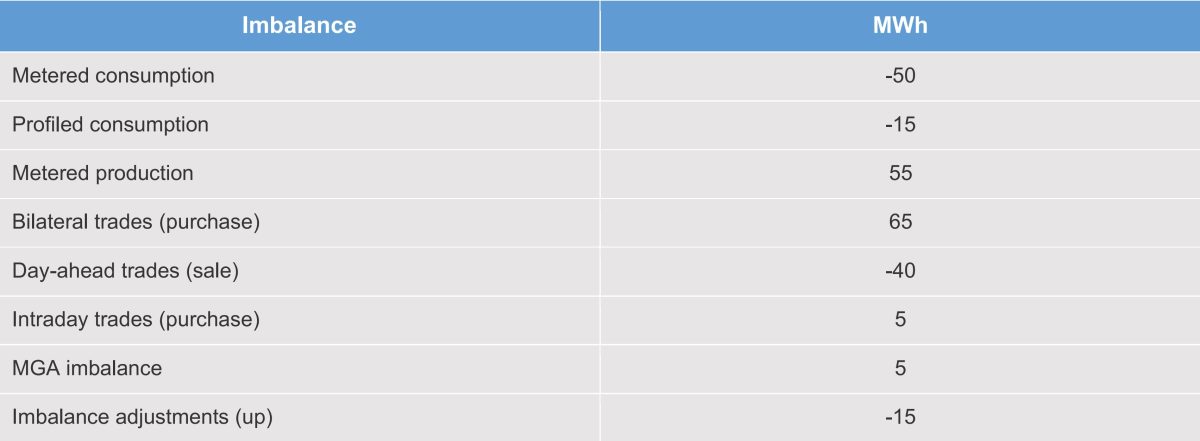
Table 16. Imbalance example values.

Table 17. Imbalance calculation.
As a result of the BRP’s imbalance calculation (-65 + 55 + 30 + 5 + (-15)) there is a 10 MWh surplus in the BRP’s imbalance. The BRP sells 10 MWh from eSett.
Balancing Service Settlement is used to calculate invoicing products for different balancing services in all countries. In Finland, where independent aggregation is allowed for certain types of balancing services, it also includes calculations for compensation and regulation imbalances.
The balancing service volumes are calculated based on received settlement data. The calculation is performed per MBA at BSP level. Some calculations include data from the parties in the BRP’s balance hierarchy, using relations in the structure information (e.g. BRP’s responsibility over REs).
Activated Reserves are aggregated into purchased and sold products per BSP, balancing sub-service and energy direction type. Capacity Reserves are aggregated into purchased products per BSP, balancing sub-service and energy direction type. Generally, all is purchased from the BSP, activated up quantity and amount is purchased from the BSP, and activated down quantity and amount are sold to the BSP.
Regulation Imbalance composes of the activated and delivered reserves of a BSP, provided that delivered reserves are used for the country and balancing sub-service. It represents the difference between activated and delivered reserves, factoring in any misdelivery during the imbalance settlement period. A misdelivery is an energy quantity for the contractual reserves (i.e. activation of other market player’s resources as per a bilateral contract). Misdelivery represents the quantity difference between activated and delivered reserves in which the BSP assigns the responsibility of the regulation imbalance to a BRP of the contract. Regulation imbalance calculation covers all products using delivered reserves in that country, resulting in a netted outcome across various balancing sub-services.
If the BSP delivers less electricity than what was activated by the TSO, there is a deficit in the regulation imbalance, and the BSP is required to purchase the regulation imbalance energy from eSett in order to cover the deficit.
Correspondingly, if the BSP delivers more electricity than what was activated by the TSO, there is a surplus in the regulation imbalance, and the BSP sells regulation imbalance energy to eSett in order to take care of the surplus.
BSP that delivers independent aggregation is not purchasing or selling the energy of the reserve resource to/from the electricity markets. Instead, the supplier of the reserve resource purchases or sells the volume. Compensation represents the independent aggregations’ energy quantity that has impacted the suppliers’ reserve resource due to delivery of balancing service energy. The resulting profit or loss is financially compensated between the BSP and supplier’s BRP. The purpose is to create a level playing field between parties that provide their own resources and parties that provide independent aggregation.
For example, a reserve resource is an end user’s heat pump, which is turned off as a part of an up activation. The supplier has purchased the expected consumption volume from the wholesale markets but does not get the income from selling the electricity to the end user. The comparison is against a situation where the heat pump was not part of the up activation, and the supplier would receive the profit from the end user. Alternatively, if the supplier (or its BRP) would be in control of the heat pump, they would cover the loss due to the up activation from the received activation payment and take it into account when providing the bid. Compensation amount is paid for the estimated loss due to decreased sales of the supplier. With down activation the situation is opposite, and the compensation is paid to the BSP. Without compensation, there would be no incentive for independent aggregators to provide down activation for the market when the price is positive as their profit consists of the difference between compensation and activation cost.
Compensation is determined based on the delivered reserves reported by market participants in the settlement system. Only reserves delivered using the ‘independent aggregation’ method are included in this calculation. Compensation quantities and amounts are aggregated per BRP, RE, and balancing sub-service, as well as per BSP and balancing sub-service. This compensation is managed as a financial transaction between BSPs and BRPs, with data also calculated and displayed per RE.
Based on the delivered data the balancing service capacities per BSP and balancing service in MBA, balancing service activations per BSP and balancing service in MBA, regulation imbalance per BSP in MBA, compensation per BSP in MBA, compensation per RE in MBA and compensation per BSP in MBA are calculated by eSett. Calculations of the balancing services are shown in Figure 21.
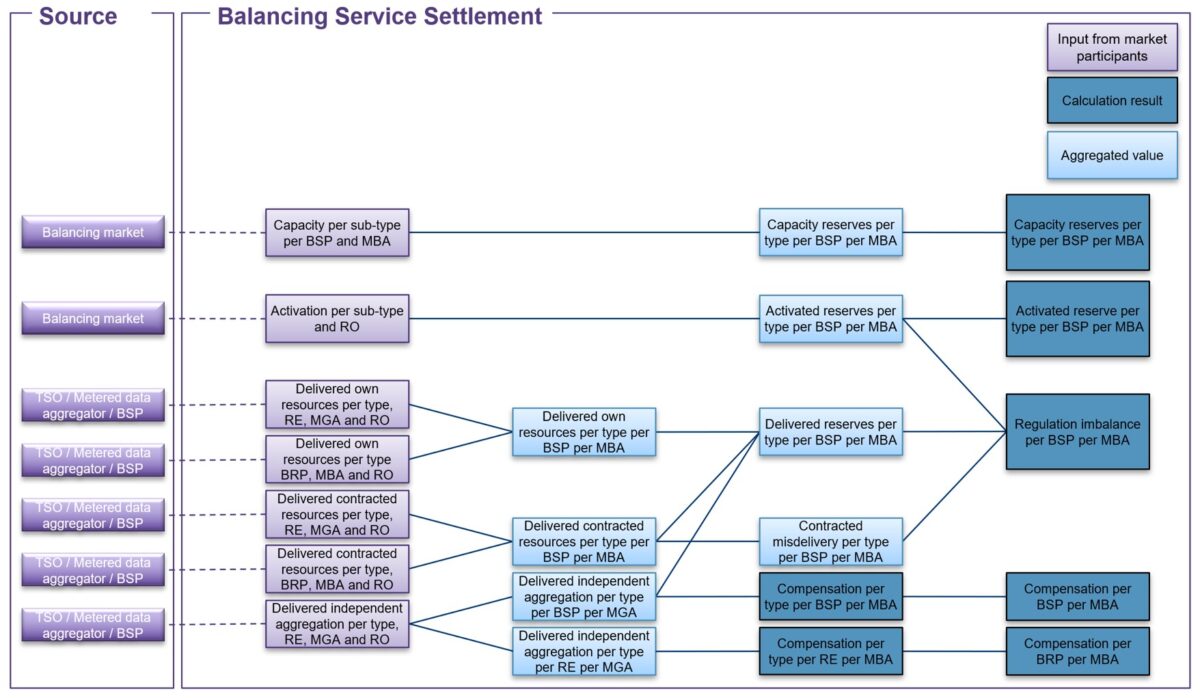
Figure 21. Calculation of balancing services settlement.
In this chapter examples of the BSP’s regulation imbalance and compensation calculations are presented. The example is made from the BSP’s perspective (see Table 18 and Table 19). Misdelivery is only used for Finland for contractual reserves, and the volume has signed values where the value is negative in case of an ‘under-delivery’ and positive in case of an ‘over-delivery’.
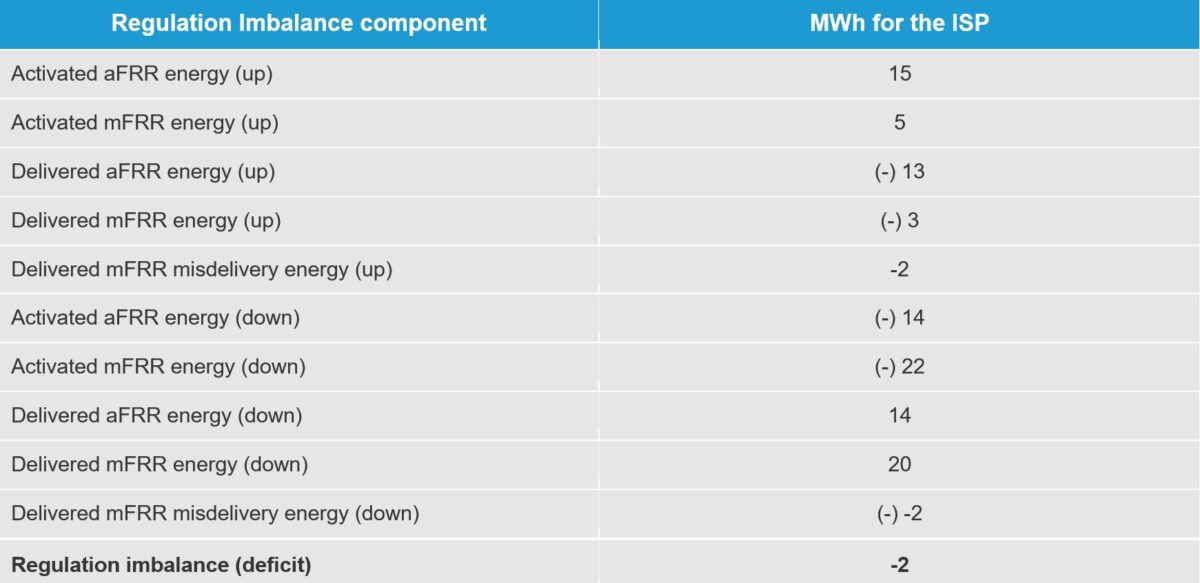
Table 18. Regulation Imbalance example calculation for a single ISP.
As a result of the BSP’s regulation imbalance calculation (15 + 5 + (-13) + (-3) – 2 + (-14) + (-22) + 14 + 20 – (-2)) there is a 2 MWh deficit in the BSP’s regulation imbalance. The BSP purchases 2 MWh from eSett.

Table 19. Compensation calculation example for a single ISP and balancing service product.
Only delivered reserves with method “independent aggregation” are considered for the compensation calculation. As a result of the BSP’s compensation calculation ((-6) + 10) there is a 4 MWh quantity which will be compensated for the BSP. The BSP sells 4 MWh to eSett.
For the BRP, the signs are reversed, the calculation would be (6 + (-10)), and there is a -4 MWh which the BRP will compensate. The BRP purchases 4 MWh from eSett.
The settlement is performed in eSett’s settlement system whether or not all the settlement data has been received. For MECs from which data hasn’t been received the value 0 is used in the preliminary calculations but empty settlement data is not changed from void to 0 in the database.
If the values have not been received by gate closure the final calculations are performed with the value 0. The market participant may view the status of reporting in Online Service to view if the calculation was done without having all settlement data available. The statistics include information on what settlement data was missing.
There will be no corrections of the settlement made by eSett after the invoice of a settlement period has been created and submitted. An exception is if eSett has committed errors or due to extraordinary circumstances (force majeure or similar). Handling of errors after invoicing is done bilaterally between the contracting parties.
Subsequent bilateral correction of settlement is outside of eSett’s scope. Handling of bilateral corrections of settlement will be performed according to national rules.
If the settlement can’t be performed due to eSett according to the schedules, the settlement will be performed and finalised as soon as the disturbance situation has been resolved.
Reconciliation is done according to current national practices. Therefore, the step-wise-approach is used for reconciliation in the Nordic Imbalance Settlement Model. This means that reconciliation is done differently in each of the countries and current national procedures are followed.
In the imbalance settlement, estimates for the profiled consumption are used when meter readings are not available in due time (13 days after delivery day). When the metering data becomes available a new and improved estimate is done and called the final profiled consumption (FPC). In the reconciliation settlement, the difference between FPC and PPC is settled using day-ahead market prices for the MBA. In this way, the error in the imbalance settlement due to incorrect estimates of the profiled consumption is corrected.
Reconciliation frequency and schedule depend on the national schedule explained in the following sub chapters that present the national step-wise approaches. Reconciliation is done if one of the following changes in the settlement structure is done: change of supplier, customer relocation, metering point switches between the profiled and non-profiled consumption or in case of change of meters.
In Sweden, eSett is responsible for calculating and reporting reconciled energy on the Swedish market. Reconciliation is settled on BRP level in Sweden. eSett will be responsible for the settlement of the reconciled energy and the invoicing. Content of the description can be found in chapter 8.1 Invoice Contents. Additionally, there is a variation regarding the reporting of profiled consumption compared to the Imbalance Settlement Model in Sweden. The reporting structure in Sweden will be as described below. Metered data for profiled consumption is collected monthly; consumption is aggregated final profiled consumption two months after delivery month for DSO per MGA. eSett calculates reconciled energy per BRP in monthly resolution three months after delivery month.
Profiling
Load Profile Shares are calculated by the DSO before the delivery month. eSett calculates BRPs PPC per MGA. Reporting structure as described below:
- DSO reports Load profile shares per MGA and BRP to eSett and BRP latest two days before the delivery month
- DSO reports Load profile per MGA to eSett according to the national consumption reporting schedules
- eSett calculates profiled consumption per BRP and MGA – calculation is automatic and continuous for the open imbalance settlement period
- eSett reports aggregated profiled consumption per BRP and MGA, and per BRP and to BRP
Reconciliation
The DSO reports Final Load Profile Shares to eSett. eSett calculates BRPs’ reconciled energy and reports it to BRPs. Reporting structure as described below:
- DSO reports final Load Profile Shares per MGA and BRP to eSett
- Strong recommendation for reporting initial metered data latest on the 15th of the second month after the delivery month
- Reporting updated metered data before the end of the second month after the delivery month
- eSett calculates the reconciled energy per BRP per MGA and aggregates it to per MBA – calculation is automatic and continuous for the open period
- eSett reports QA data per MGA on reconciled energy to BRP
- eSett publish reconciled energy per MGA and BRP
- eSett report reconciled energy and payment per MBA to BRP
- eSett sends out invoice to BRP
Based on the delivered data the monthly preliminary load profile share per BRP in MBA, profiled consumption per BRP in MBA, load profile per MBA, profiled imbalance per BRP in MBA and final load profile shares per BRP in MBA are calculated by eSett. Altogether the result is imbalance per BRP in MBA. Calculation of the imbalance is shown in Figure 22.

Figure 22. Calculation of reconciliation settlement.
Short description of the model is in Appendix 3. A more detailed explanations can be found from the Svensk Elmarknadshandbok (https://www.elmarknadshandboken.se/handbok.html) which is available only in Swedish.
In Finland reconciliation is managed yearly after final meter reading per metering point. Reconciliation is done between DSO and RE. Profiled consumption has annual meter reading and the DSO is responsible for the meter reading. REs are the financial counterparts for DSOs in the process. Final imbalance profiling is done in an equal way in all meters independent on the meter type. Reconciliation settlement is done on same basis as imbalance settlement and the price is the day-ahead market price of the metering grid area during the imbalance settlement period. Profiled consumption is done annually.
In Norway reconciliation is handled by the Norwegian datahub, Elhub. eSett is not involved in the reconciliation process.
In Denmark there is no reconciliation process since all metering points are metered and settled per imbalance settlement period. Corrections due to changed meter data and settlement structures after gate closure for imbalance settlement is handled by the Danish DataHub in a correction settlement between the affected suppliers.
The BRP’s imbalance volumes and BSP’s regulation imbalance volumes are priced for each imbalance settlement period according to the prices that are generated in the balancing markets together with the incentivizing component (IC). The price applied to an ISP of imbalance can be either the up-regulation price or the down-regulation price depending on the dominating direction from the regulation power markets. In case there is no activation of balancing energy in either the positive or the negative direction for an MBA for an ISP, a Value of Avoided Activation (VoAA) of balancing energy (mFRR) is used together with the incentivizing component (IC) to determine the imbalance price.
In addition to the pricing of the imbalance volumes, eSett also calculates the fees that are charged from the BRPs in the imbalance settlement and from BSPs in the balancing service settlement. The applicable fee categories are presented in subchapter 7.2.

Table 20. Pricing information.
The pricing models for imbalances are summarized in Table 21.
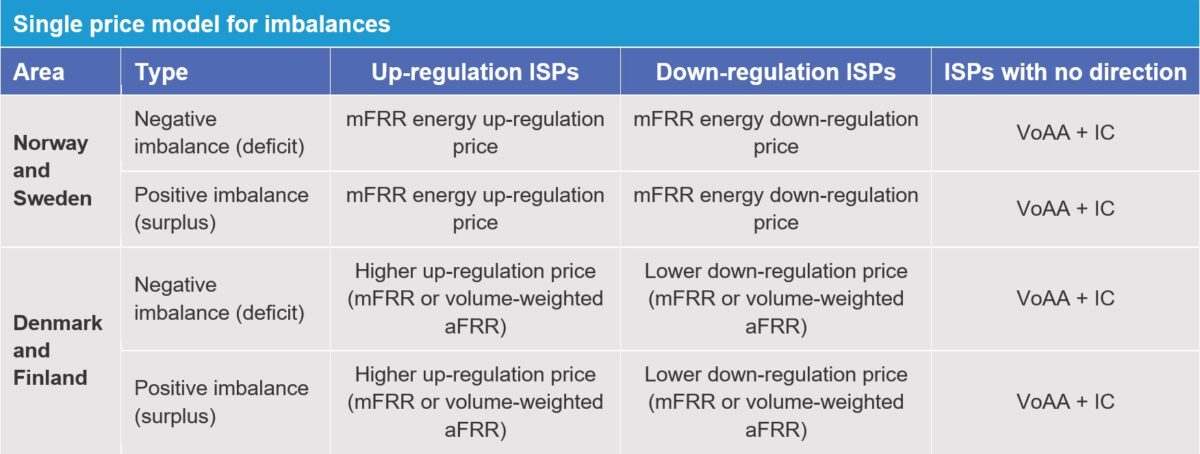
Table 21. Pricing models for imbalances.
Imbalance is priced according to a single price model, which means that positive and negative imbalances have the same price. The price is the regulation price in the dominating direction of regulation in the MBA:
- In up-regulation ISPs, the price of negative and positive imbalances is the mFRR energy up-regulation price.
- In down-regulation ISPs, the price of negative and positive imbalances is the mFRR energy down-regulation price.
Imbalance is priced according to a single price model, which means that positive and negative imbalances have the same price. The price is the mFRR or a volume-weighted aFRR energy activation price in the dominating direction of regulation in the MBA:
- In up-regulation ISPs, the price of negative and positive imbalances is the mFRR energy up-regulation price or the volume-weighted aFRR energy up-regulation price.
- Higher of the two prices is applied.
- In down-regulation ISPs, the price of negative and positive imbalances is the mFRR energy down-regulation price or the volume-weighted aFRR energy down-regulation price.
- Lower of the two prices is applied.
In Nordics there is a common model for pricing of imbalances in ISPs that have no activation:
- In case there is no activation of balancing energy in either the positive or the negative direction or exactly the same energy activated to both directions for an MBA for an ISP, a Value of Avoided Activation (VoAA) of balancing energy (mFRR) is used together with the incentivizing component (IC) to determine the imbalance price.
- The VoAA is computed as the average of the lowest bid for up regulation and the highest bid for down regulation.
- The boundary condition in the Nordic countries states that the imbalance price in these cases shall be equal to the day-ahead market price. To make sure that the imbalance price for that MBA for that ISP is always the same as the day-ahead market price, an incentivizing component (IC) is used to “adjust” the VoAA.
- The imbalance price is therefore computed as the sum of the VoAA and the IC, where the incentivizing component can be both positive and negative:
Imbalance price = VoAA + IC - For example, if the day-ahead market price is 38, and VoAA is 35, the IC will be 3, and thus the “adjusted” VoAA and Imbalance price are 38.
- The imbalance price is therefore computed as the sum of the VoAA and the IC, where the incentivizing component can be both positive and negative:
Compensation is priced according to a single price model, which means that positive and negative compensations have the same price. The reference price for compensation is the day-ahead market price in the MBA.
Reconciliation for Sweden is priced according to a single price model, which means that positive and negative reconciliation have the same price. The price is a volume-weighted day-ahead market price in the MBA. The volume-weighted day-ahead price is calculated by weighting the price of the ISP and MBA with the sum of load profile volumes of the ISP and MBA.
Income generated by the Nordic TSOs in the settlement will cover the national cost base, which encompasses for example costs for operating eSett as well as parts of the costs for reserves.
The fees in the settlement model are calculated and invoiced separately for each market balance area. The fee categories have been harmonized across the countries but the amounts of fees to be charged will be country specific as the cost bases are national. There are three types of harmonised fee: a volume fee on production and consumption, a fee on all imbalances and a weekly fee. In addition to the harmonised fee structure there is one additional fee related to the financing of the Swedish peak load reserves, which is charged only from the BRPs active in the Swedish MBAs, and another additional fee related to BSPs regulation imbalances in Finland.
The fee levels are set by each TSO in proportion to the national cost base. The fees can be changed with one month’s notice. The goal is to keep the fees fixed for at least one calendar year at the time, if possible. TSOs are responsible for calculating and setting the fees and notifying eSett to reduce or increase the fee levels. All fees are published in the Online Service.

Table 22.Fee structure in the settlement model.
The Volume Fee is levied on the BRP’s total Consumption and Production according to Table 23. The Volume Fee is defined as EUR per MWh of Consumption and Production and calculated for each ISP and MBA.
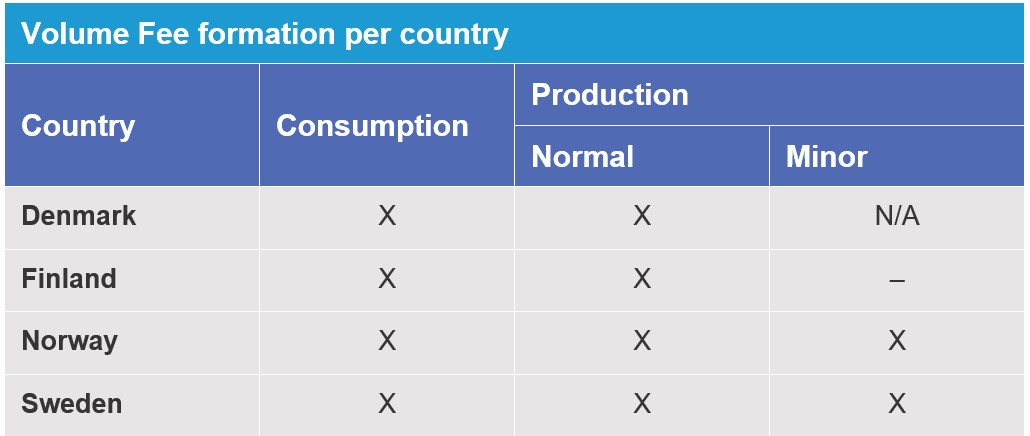
Table 23. Volume Fee formation per country
The Imbalance Fee is levied on sum of the absolute amounts of the BRP’s positive and negative Imbalances. The Imbalance Fee is defined as EUR per MWh of Imbalance and calculated for each ISP and MBA.
Alternatively, each TSO has an option to apply Imbalance Fee on the sum of BRP’s positive and negative Imbalances that have been netted within each hour, in which case the Imbalance Fee is defined as EUR per MWh of Imbalance and calculated for each hour and MBA. As a result, there shall be no uncontrollable costs for BRPs due to an intermediate solution, where metering is per 15 minutes, but there are no realistic options for BRPs to balance the quarterly imbalances within an hour.
The Weekly Fee is levied for each week and country where the BRPs have been active in the week that the invoice covers. The Weekly Fee is defined as EUR per week and country. The maximum fee for a BRP active in all market balance areas in the Nordics will be four times the weekly fee. (I.e., if the weekly fee is 50 EUR per week and country, the fee for a BRP operating in Denmark, Finland, Norway and Sweden is 200 EUR.)
The BSP’s Weekly Fee is levied for each week and country where the BSPs have been active in the week that the invoice covers. The BSP’s Weekly Fee is defined as EUR per week and country. The maximum fee for a BSP active in all market balance areas in the Nordics will be four times the BSP’s weekly fee. (I.e., if the BSP’s weekly fee is 50 EUR per week and country, the fee for a BSP operating in Denmark, Finland, Norway and Sweden is 200 EUR.)
If the company has both BRP and BSP role in the country, then only BRP’s Weekly Fee will be charged.
In addition to the harmonised fee structure there is an additional national fee related to the financing of the Swedish peak load reserves. This fee is levied on BRPs active in the Swedish balancing areas and will be invoiced by eSett on behalf of Svenska kraftnät. The peak load reserve fee is based on the BRP’s metered and profiled consumption, excluding network losses for networks requiring licenses. The fee is charged between 16th of November and 15th of March on working days between 06.00-22.00 CET. If a profit or loss arises at the end of a peak load reserve fee period, it will be included in the next year’s calculation of the fee.
The Regulation Imbalance Fee is levied on sum of the absolute amounts of the BSP’s positive and negative Regulation Imbalances. The Regulation Imbalance Fee is defined as EUR per MWh of Regulation Imbalance and calculated for each ISP and MBA.
This chapter contains an example of imbalance calculation with prices. The example is based on the ones used to describe the calculation of imbalance volumes in chapters 6.2 and 6.3. For clarity, all balancing services are combined, and they use the same regulation prices in the example. In the calculation the ISP in question is assumed to be an up-regulation ISP. Prices and fees used in the examples are defined in Table 24 below.

Table 24. Fees and prices used in the imbalance calculation.
The first example presents BRP’s imbalance calculation. The example is made from the BRP’s perspective. As a result of the BRP’s imbalance calculation there is a surplus of 10 MWh. The BRP sells 10 MWh imbalance energy to eSett.
Invoicing is done from the BRP’s point of view. The BRP’s balance has a 10 MWh surplus. The BRP’s balance evens up by the BRP selling imbalance energy to eSett. In the invoicing a negative expense means compensation to the BRP. Also, there are compensation products because of independent aggregation in the BRP’s balance.
The invoicing for the imbalance is the following:
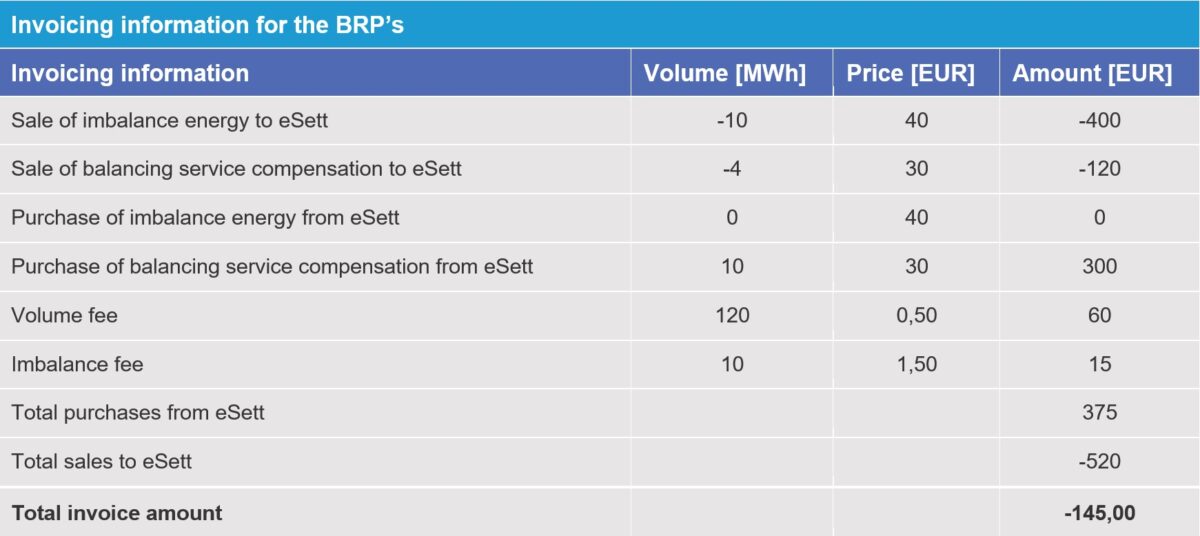
Table 25. Invoicing information for the BRP’s.
This chapter contains an example of balancing service calculations with prices. The example is made from the BSP’s perspective. As a result of the BSP’s regulation imbalance calculation there is a deficit of 2 MWh. The BSP purchases 2 MWh imbalance energy from eSett.
Invoicing is done from the BSP’s point of view. The BSP’s balance has a 2 MWh deficit. The BSP’s balance evens up by the BSP purchasing imbalance energy from eSett. In the invoicing a negative expense means compensation to the BSP. Also, there are balancing service products for all activations, and compensation products because of independent aggregation done by the BSP.
The invoicing for the imbalance is the following:
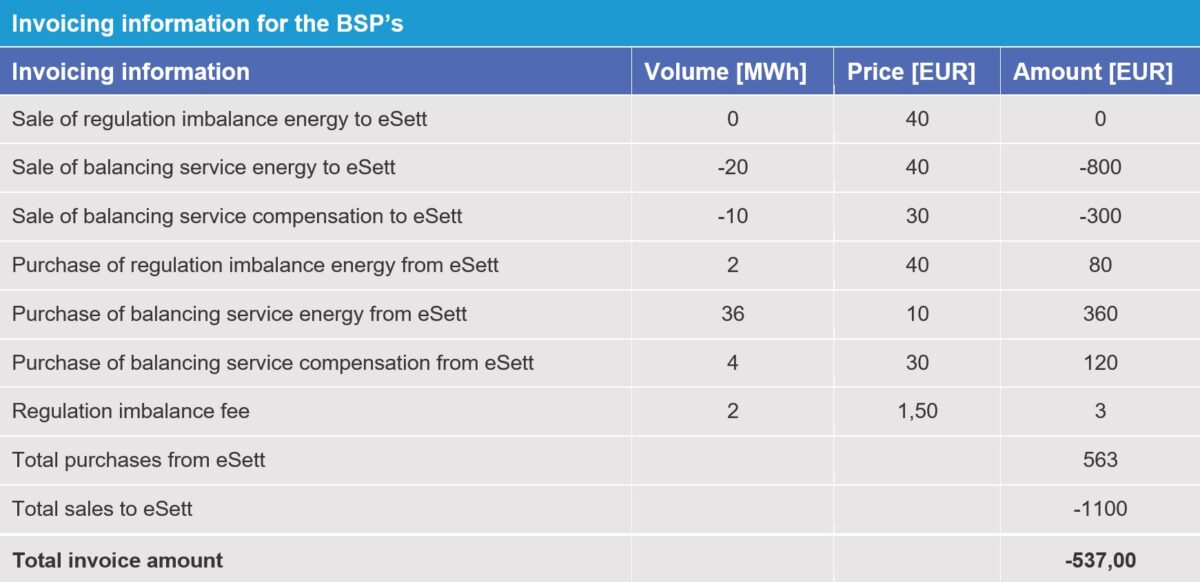
Table 26. Invoicing information for the BSP’s.
eSett manages the invoicing and money transfers in the settlement. The amounts to be settled include the BRPs’ imbalances, BSPs’ regulation imbalances, the fees charged from the BRPs and BSPs, payments for balancing services between the TSO and the BSP, and payments for compensation between the BSPs and BRPs. The TSOs are legally responsible for the settlement, but eSett carries out the settlement and invoicing on their behalf. The settlement is to a great extent a matter of passing money between BRPs, BSPs and TSOs. However, all transfers pass through eSett who guarantees the financial settlement. The net proceeds from the settlement in each country will be transferred to the respective TSO. EUR is the common currency in which all settlement is performed, but BRPs and BSPs in Denmark, Norway and Sweden can choose to be invoiced in their local currency.
The invoices from eSett to BRPs contain the volumes (MWh), prices and payable amounts (EUR or local currency) of the imbalances during the settlement period. The invoices also contain the fees accrued in the settlement period and possible compensations for any independent aggregation. The content of the invoice is illustrated in Figure 23.
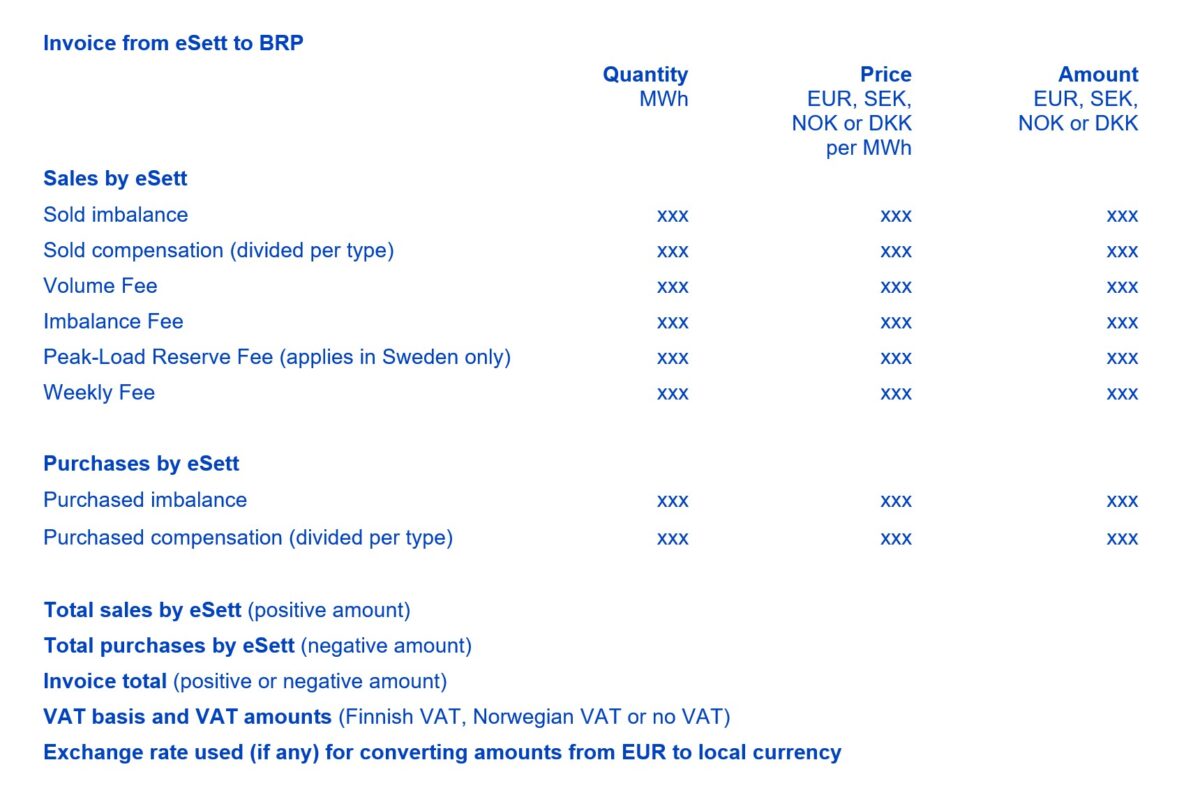
Figure 23. Illustrative contents of invoice from eSett to BRPs
The invoices from eSett to BSPs contain the volumes (MWh or MW for contracted reserves), prices and payable amounts (EUR or local currency) of the bought and sold regulation imbalances, balancing services and compensations during the settlement period. The invoices also contain the fees accrued in the settlement period if applicable. The content of the invoice is illustrated in Figure 24.
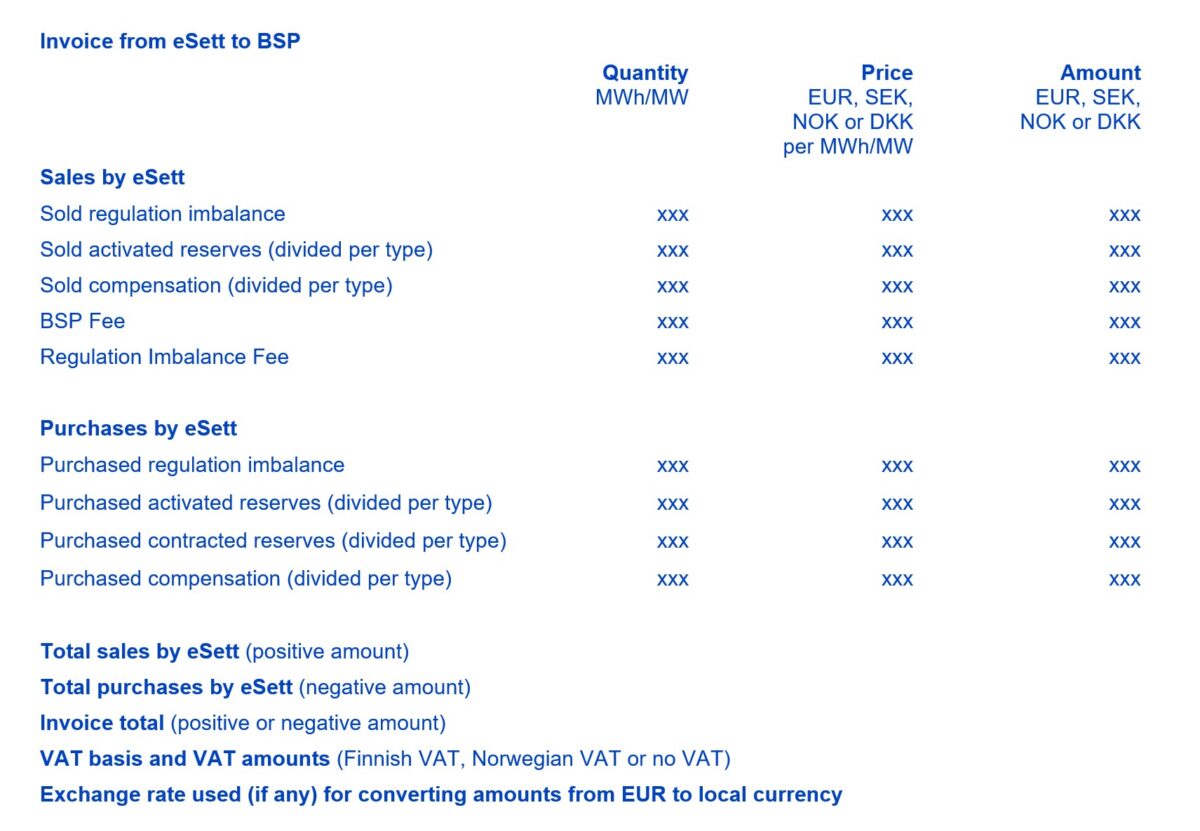
Figure 24. Illustrative contents of invoice from eSett to BSPs.
The invoices from eSett to BRPs which have also a BSP role contain the volumes (MWh or MW for contracted reserves), prices and payable amounts (EUR or local currency) of the bought and sold imbalances, regulation imbalances, balancing services and compensations during the settlement period. The invoices also contain the fees accrued in the settlement period if applicable. The content of the invoice is illustrated in Figure 25.
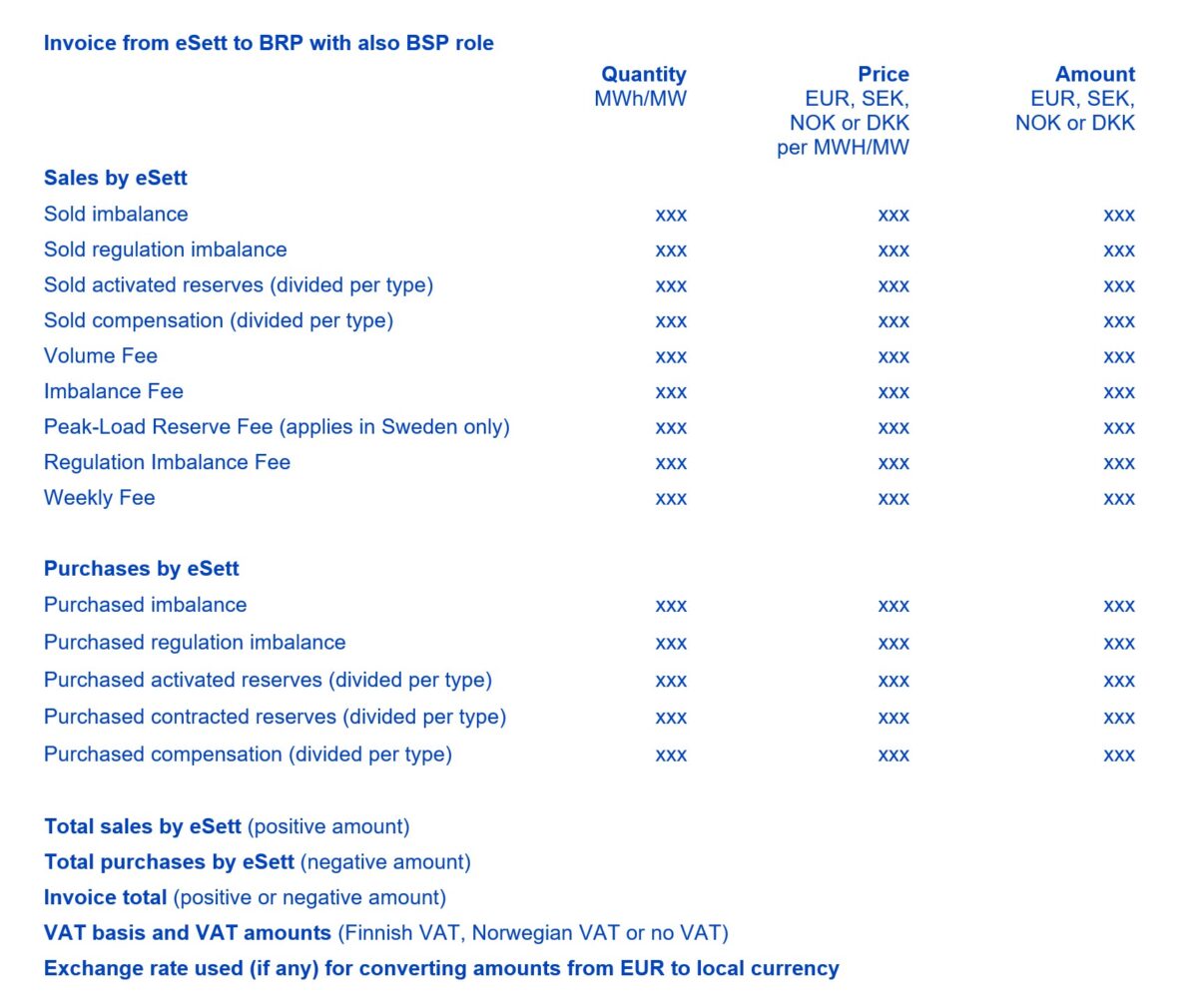
Figure 25. Illustrative contents of invoice from eSett to BRPs which have also a BSP role.
Invoice rows representing purchases by the BRP or BSP from the TSO are labelled as “sales by eSett”. The amounts of these rows are positive, i.e. the BRP shall pay these amounts to eSett. Invoice rows representing sales by the BRP or BSP to the TSO are labelled as “purchases by eSett”. The amounts of these rows are negative, i.e. they reduce the amount that the BRP or BSP needs to pay to eSett. The invoice total can be either positive or negative depending on the relative amounts of purchases, sales and fees on the invoice. Invoices with a positive total are labelled “Debit Notice” and settled with a money transfer from the BRP or BSP to eSett. Invoices with a negative total are labelled “Credit Notice” and settled with a money transfer from eSett to the BRP or BSP. When eSett issues Credit Notices to BRPs, this is referred to as “self-billing”.
In addition to the ordinary imbalance settlement invoices, eSett also invoices the BRPs operating in Sweden for the payable amounts arising from the reconciliation of their profiled deliveries. eSett is responsible for the settlement of the reconciled energy and the invoicing process. Invoicing of the reconciled energy is carried out on a monthly basis. The invoice contains the volumes (MWh) and payable amounts of the reconciled energy and profile compensation as well as accrued interest on the payable amounts. The content of this invoice is illustrated in Figure 26.
An interest applies for the invoices, and Svenska kraftnät provides the interest rate to eSett. Interest may change only twice per year on 1 January or 1 July. Interest is calculated for the days from the last imbalance settlement invoicing of the month until the reconciliation invoicing of the month. E.g. interest for November 2023 is calculated for bank days from 18 December until 6 February 2024.
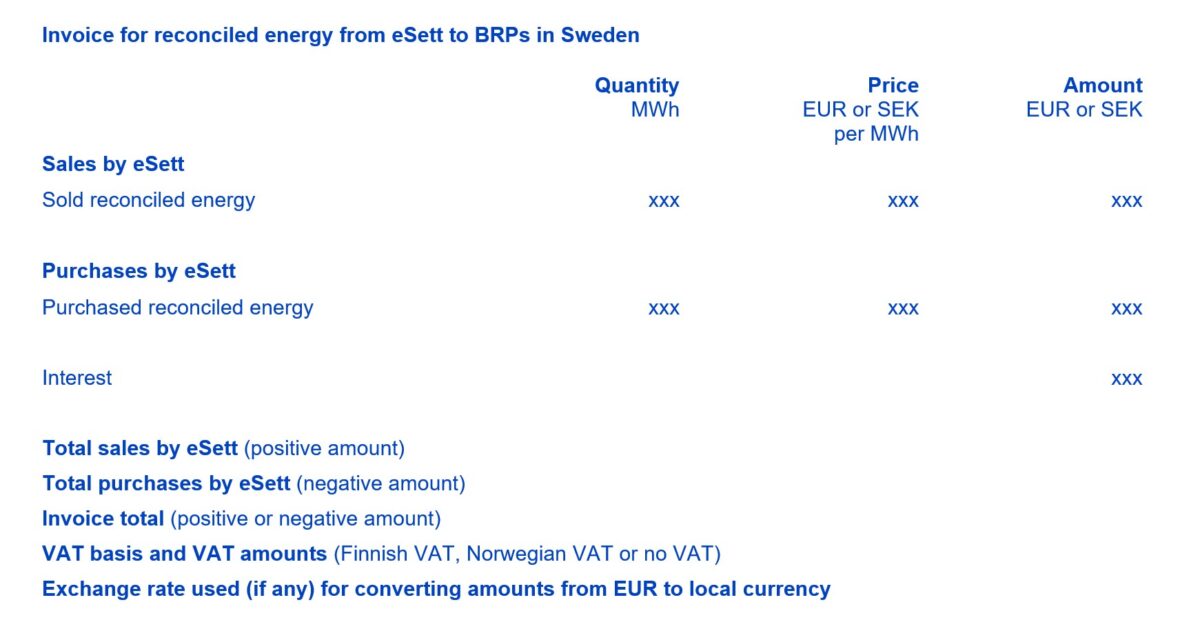
Figure 26. Illustrative contents of invoice for reconciled energy of BRPs in Sweden.
The BRP or BSP receives one invoice for each country where it is active. Companies that operate multiple BRP or BSP roles in a country also get separate invoices for each role.
Companies that operate in the same country with both BRP and BSP roles, shall receive only one BRP invoice. The invoice will contain details from both BRP and BSP invoices as illustrated in Figure 25. Companies that operate multiple BRP roles and a BSP role in the same country, shall have the BSP invoice contents in one of the BRP invoices for a designated BRP.
The invoice is distributed as an e-invoice through the network of e-invoice operators active in the Nordic region. eSett’s e-invoice operator is Basware. To receive e-invoices, the BRPs and BSPs need to establish an agreement with an e-invoicing operator and inform eSett of the e-invoicing operator and e-invoicing address that it will use. The e-invoice consists of two components:
- An invoice message in XML, which allows for automatic import of the invoice into the BRP’s or BSP’s accounting system
- A PDF file with a traditional image of the invoice, which facilitates manual review of the invoice
eSett encodes the invoice message in the Finnish Finvoice 3.0 format. However, the BRP or BSP can agree with its invoice operator to receive the invoice in any supported e-invoice format. Any required translation of the message is carried out while the message is transferred from eSett’s e-invoice operator to the recipient’s e-invoice operator.
BRPs and BSPs that do not wish to receive e-invoices will instead receive their invoices by email in PDF format.
eSett will use a direct debiting scheme for collecting the incoming payments from the BRPs and BSPs. This means that when a BRP or BSP receives a Debit Notice from eSett, they should not pay the invoice. Instead eSett will issue an instruction through its main bank to the BRP’s or BSP’s bank to debit the payable amount from the BRP’s or BSP’s account and transfer it to eSett. The use of direct debiting helps to ensure timely settlement according to a short settlement cycle. The payments between BRPs and eSett, and BSPs and eSett are all executed as same-day-value payments, which means that the payments will be available to the recipient’s bank on the same day as they are paid by the payer. Typically, the funds will also be credited to the recipient’s account on that same day, but that depends on the terms agreed upon between the recipient and its bank.
To participate in the settlement, the BRPs and BSPs need to hold a bank account(s) in an approved settlement bank, i.e. a bank which has been approved by eSett to be used in the imbalance settlement. This bank account shall enable the direct debiting in the settlement of its outstanding settlement amounts referred to in section 8.3 above. In case direct debiting would not be possible in accordance with the terms and conditions of the said bank account, for example related to anti-money laundering regulations or sanctions, between the Settlement Bank and BRP or BSP, the precondition for the BRP or BSP to be entitled to access the electricity market settlement would not be fulfilled and eSett has the right to terminate the Imbalance Settlement Agreement (BRP) or Balancing Service Settlement Agreement (BSP).
eSett defines the criteria for approval of banks as settlement banks. These criteria include requirements on credit rating as well as the ability to interchange required SWIFT messages with eSett’s bank for execution of payments and balance reporting (see chapter 9.9). The settlement bank also needs to sign a Settlement Bank Agreement with eSett.
The list of approved settlement banks is available in the Online Service and in Open Data portal (opendata.esett.com). If a party wishes to use a bank which is not on the list of approved settlement banks, they shall inform eSett and supply the contact details of a contact person at the bank, with whom the necessary process can be initiated to establish the settlement bank status, given that the bank meets the criteria.
Depending on selected settlement bank there are two alternative ways (see list of approved settlement banks in www.eSett.com) to setup accounts for the imbalance settlement:

Table 27. Pledged Settlement Account Model.
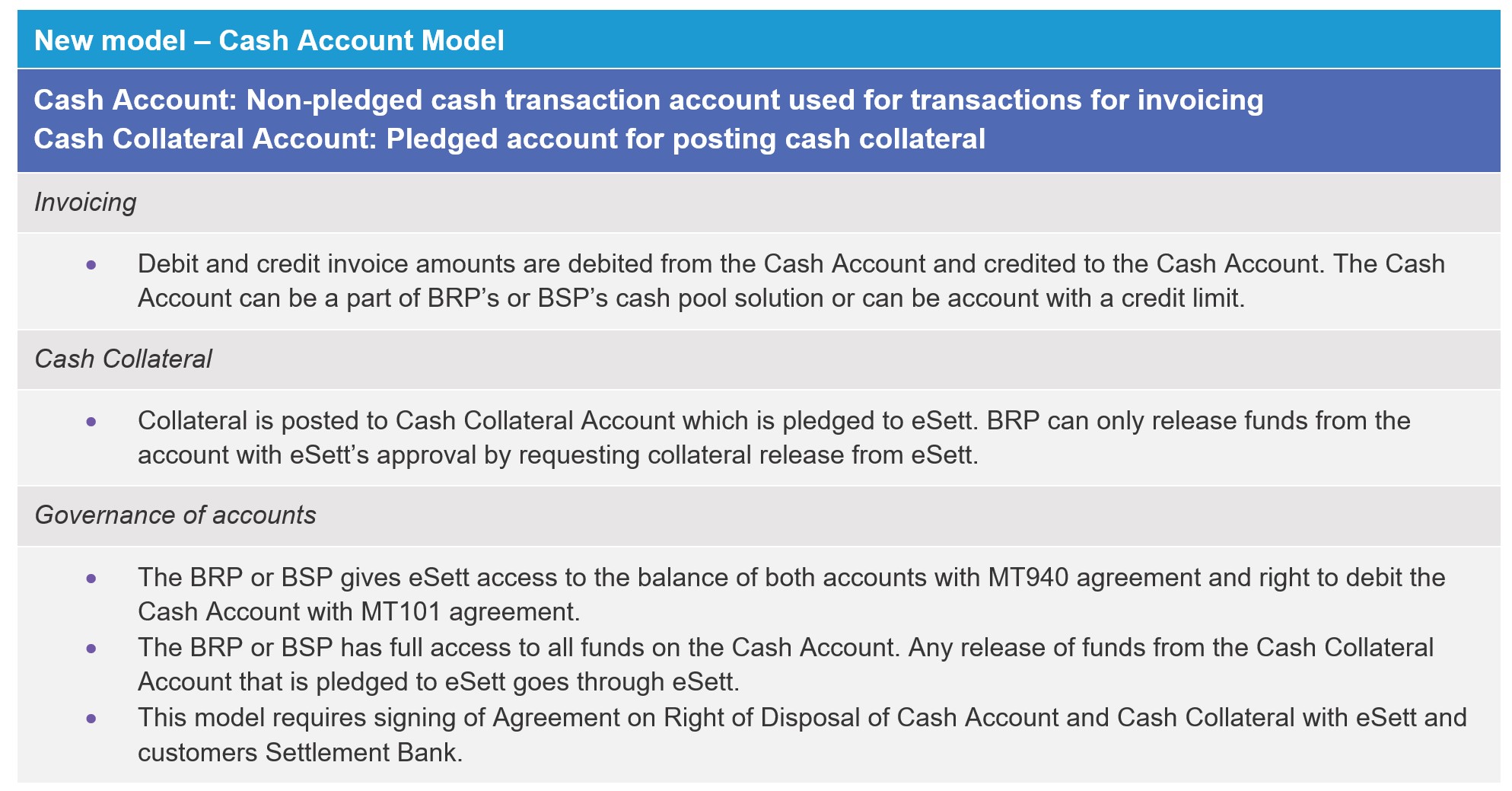
Table 28. Cash Account Model.
The Pledged Settlement Account/Cash Account is used for the debiting and crediting of all payable amounts between the BRP and eSett, and BSP and eSett. In the Pledged Settlement Account Model any collateral that the BRPs and BSPs provide in the form of cash shall also be held on the Pledged settlement account. In the Cash Account model all cash collateral must be held on the Cash Collateral Account. The requirements and procedures related to collaterals are further described in chapter 9.
The currency of the settlement account can be EUR, DKK, NOK or SEK depending on country that the BRP or BSP operates (see chapter 8.8 Currency Treatment). The BRPs and BSPs must select the same currency for their pledged settlement account/cash account as they have selected for their invoices. If a party operates in multiple countries, it can have one pledged settlement account/cash account per country over which the invoices for respective country are settled. Or party can have one common account over which invoices are settled if the invoicing currency is the same in all the countries. The account(s) will be updated by the BRP or BSP through Online Service. Any account setup is subject to review and approval by eSett.
In the Pledged Settlement Account Model to enable the debiting of the pledged settlement account and to make it possible to apply the funds on the pledged settlement account as collateral, the BRPs and BSPs need to sign a Pledged Cash Account Agreement, as defined by eSett, whereby they pledge the funds on the account to eSett and grant eSett the necessary right of disposal over the account. The BRPs and BSPs also need to sign MT101 and MT940 agreements with their settlement bank. These agreements are necessary for eSett to direct debit the settlement account and retrieve balance statements of it. An agreement on same-day-value payments to the account is needed if the party wishes to receive the payment as same-day-value payment. The settlement bank will advise on what agreements are required.
In the Cash Account Model to enable the debiting the cash account, the BRP or BSP needs to sign an Agreement on Right of Disposal of Cash Account and Cash Collateral, as defined by eSett, whereby they grants eSett the necessary right of disposal over the account. The BRPs and BSPs also needs to sign MT101 and MT940 agreements with their settlement bank. These agreements are necessary for eSett to direct debit the account and retrieve balance statements of the accounts. An agreement on same-day-value payments to the cash account is needed if the party wishes to receive the payment as same-day-value payment. The settlement bank will advise on what agreements are required.
Invoicing of the settlement is carried out on a weekly basis. Invoices are issued each Monday. Each invoice comprises the transactions and fees from the delivery days for which the result of the imbalance settlement has been finalized but not invoiced yet. This means that the invoice on Monday will include the settlement that was finalized during the previous week. This settlement covers the delivery days of the week that started three weeks before the invoicing date. The schedule for settlement and invoicing in relation to the delivery dates is illustrated in Figure 27.
Since eSett does not perform settlement on weekends, the settlement of Sundays’ and Mondays’ transactions is finalized on a Monday. The transactions from Sundays will be invoiced on the same Monday on which their settlement was finalized. The transactions from Mondays will be invoiced one week after the Monday on which their settlement was finalized.

Figure 27. Schedule for settlement, invoicing and payment
The payable amounts of the debit notices will be debited by eSett from the settlement account two days after the invoicing day, i.e. on Wednesday. The payable amounts of the credit notices will be paid by eSett to the settlement account three days after invoicing day i.e. on Thursday.
Invoices and updated collateral requirements are published in the Online Service on Mondays by 13 CE(S)T. BRPs and BSPs need to post any required additional collateral by 11 CE(S)T the next day. In addition to the collateral, the BRPs and BSPs also need to have sufficient funds on their accounts for the settlement of their next invoice in case it is a debit notice. These funds also need to be in place during the Monday. The requirements and procedures related to collaterals are further described in chapter 9.
For clarity, BRPs and BSPs should note that the Settlement Bank agreement or the Pledged Cash Account agreement does not prevent the Settlement Bank from utilising its possible right to set-off accrued negative interest payable by BRP or BSP (if any) to the Settlement Bank under the terms and conditions of the Pledged Cash Account, if such negative interest will not be otherwise charged. However, if such set-off right exists and is being used by the Settlement Bank, BRP or BSP is still obliged to have sufficient funds on its settlement accounts for the settlement of their next invoice and to meet the collateral requirement as required.
The weekly activities related to invoices, payments, collateral, and currencies are summarized in Table 29.
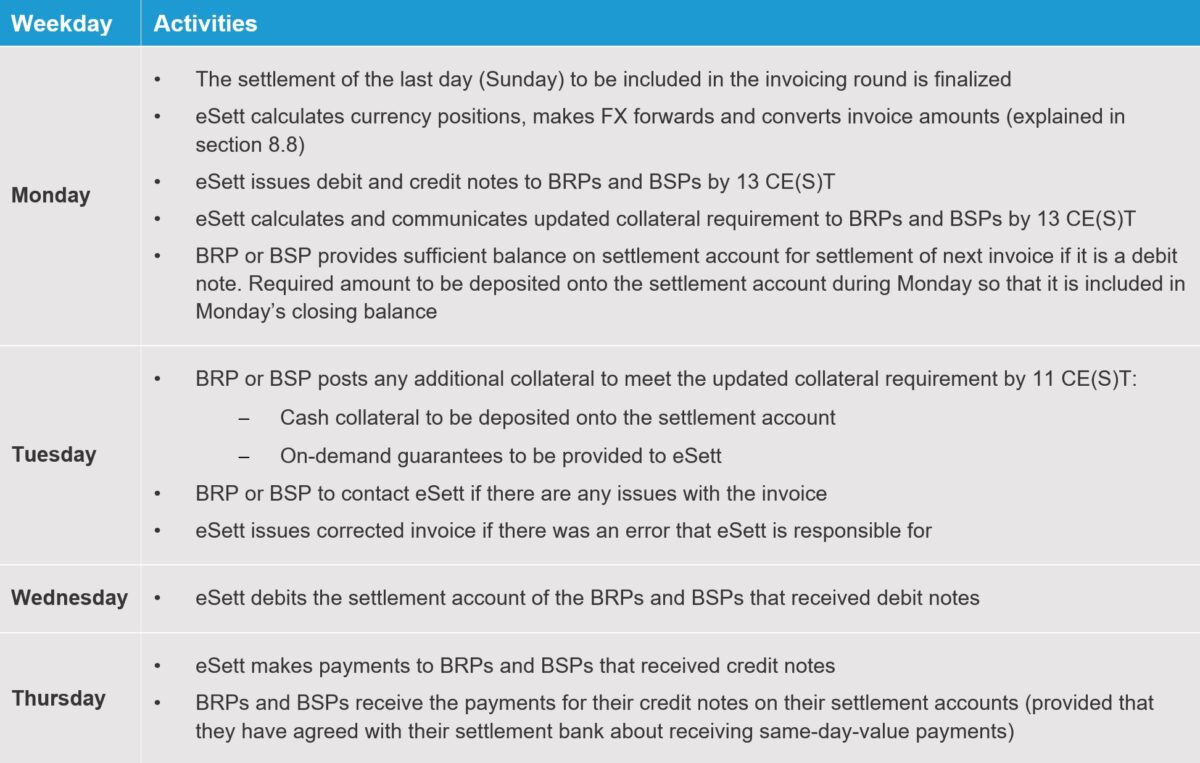
Table 29. Weekly activities related to invoices, payments, collateral, and currencies
The invoicing takes place on the first Tuesday on the third month after the delivery month. Invoices are published in the Online Service on Tuesdays by 13 CE(S)T. eSett uses direct debiting and crediting with the existing settlement accounts. More information about the invoice contents, distribution, banking setup, etc. can be found from chapter 8 Invoicing. An invoicing schedule example is presented in the figure below.
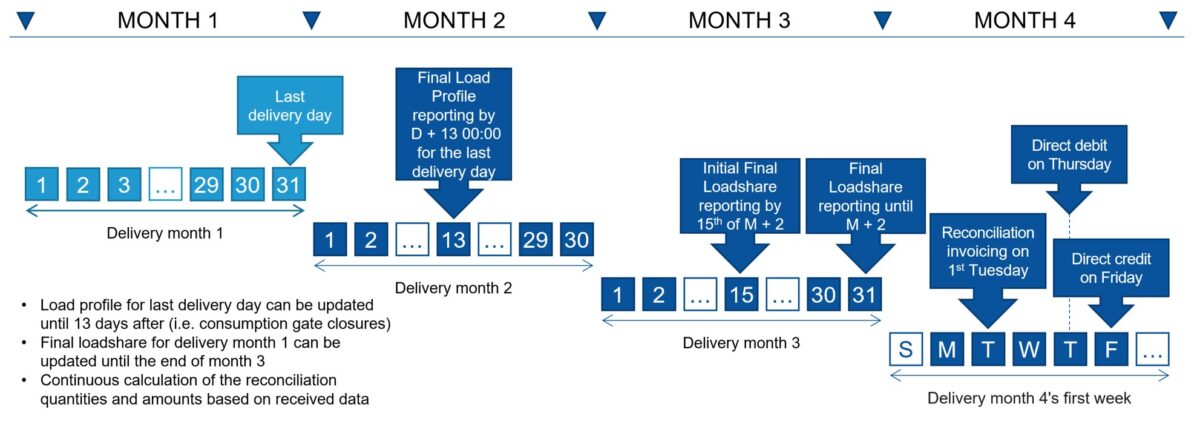
Figure 28. Schedule for reconciliation settlement, invoicing, and payment.
If there are one or more holidays on Monday before the invoicing or during the invoicing cycle (Tuesday to Friday), the invoicing activities on and after the holiday will be moved forward correspondingly. So, the reconciliation invoicing won’t occur at the same day as settlement invoicing, and there is always the same number of business days between the events: one business day between the invoicing day and the day when incoming amounts are debited and two business days between the invoicing day and the day when outgoing amounts are paid. A holiday in any of the NBS countries will be treated as a holiday for the whole system in this regard.
Invoices and updated collateral requirements are published in the Online Service on Mondays by 13 CE(S)T. BRPs and BSPs need to post any required funds for debit invoice during the same day and any additional collateral by 11 CE(S)T the day after the publishing. If updated collateral requirements are published later than 13 CE(S)T on Monday (invoicing day), any required additional collateral needs to be posted latest during the following day.
If there are one or more holidays during the invoicing cycle (Monday to Thursday), the invoicing activities on and after the holiday will be moved forward correspondingly so that there is always the same number of business days between the events: one business day between the invoicing day and the day when incoming amounts are debited and two business days between the invoicing day and the day when outgoing amounts are paid. A holiday in any of the NBS countries will be treated as a holiday for the whole system in this regard. A holiday on a Monday before the Swedish reconciliation invoicing also causes the activities related to the reconciliation invoicing to move forward correspondingly to ensure that settlement invoicing and reconciliation invoicing won’t occur on a same day.
If the finalization of the settlement is delayed due to some technical problem at eSett and all of previous week’s settlement has not been finalized on Monday by the time the invoicing should take place, eSett will not invoice the incomplete week but rather delay the invoicing until all settlement data has been finalized. If the issuing of invoices is postponed from Monday to another day in the week, all other days in the invoicing cycle will also be postponed with an equal number of days so that there will be one business day between the invoicing day and the day when incoming amounts are debited and two business days between the invoicing day and the day when outgoing amounts are paid.
If a BRP or BSP notices an error in an invoice, which is caused by a mistake made by eSett, they should notify eSett thereof as soon as possible, at the latest during the same week as the invoice was issued. If it is possible to correct the invoice during the day after the invoicing (Tuesday), the corrected amount will be debited on Wednesday or paid out on Thursday. Otherwise, the original amount will be debited on Wednesday or paid out on Thursday and a correction will be debited or paid out after the corrected invoice has been issued. Due to the short time span between invoicing and debiting/payment, it is essential that BRPs and BSPs carefully verify the preliminary and finalized settlement and balancing service amounts as soon as they are available so that any errors in the settlement amounts can be identified and corrected well ahead of the invoicing. Invoicing errors that are caused by errors of the market participants or reported after the week when the invoice was issued will not be corrected by eSett. Such errors will instead have to be settled bilaterally between the contracting parties.
At the beginning of a new year, the invoicing period that contains the settlement from the delivery days at the turn of the year is split into two and two invoices are issued for that period: one with the settlement from the delivery days that fall on the old year’s side and another one with the settlement from the delivery days that fall on the new year’s side. The weekly fee will be divided respectively into the two invoices. Both invoices are issued on the same day and debited or credited according to the same schedule.
The imbalance energy, fees and activated reserves invoiced to the BRPs and BSPs by eSett are subject to value added tax (VAT) in all the Nordic countries. The tax rules and rates differ depending on the location where the buyer is VAT registered, the location where the seller is VAT registered, and the location of delivery. The VAT procedures in the Nordic Imbalance Settlement are based on the premises that eSett is established in Finland and that it acts as a commissionaire for the TSOs. Most BRPs and BSPs are established and VAT registered in the country where they act as BRP or BSP, but it is also possible for companies in other EU member states and Norway to act as BRPs or BSPs in Denmark, Finland and Sweden without local establishment and VAT registration. Due to Norwegian legislation, a local VAT registration is needed in Norway in order to buy and sell electricity in Norway. The different applicable VAT rates depending on the location of the party’s VAT registration and the country of delivery are illustrated in Table 30 and explained in the following subchapters.

| * Electricity trade in Norway requires local VAT registration |
Table 30. Applicable VAT rates depending on registration location of BRP or BSP and country of delivery.
As eSett is VAT registered in Finland, all the power that eSett sells to and purchases from other companies’ VAT registered in Finland is subject to Finnish VAT, 25,5 % from 1 September 2024 (previously 24 %). The physical location of the delivery does not matter (unless the location is Norway, see section 8.7.2). If a company with VAT registration in Finland participates in the imbalance settlement in Sweden or Denmark, the invoice from eSett to this BRP or BSP for the imbalance settlement in that country will also be subject to Finnish VAT. Thus, the invoices for the imbalance settlement in Finland, Sweden and Denmark to companies with VAT registration in Finland will always have Finnish VAT.
When eSett sells power delivered in Finland or Sweden or Denmark to a company that is not VAT registered in Finland but in another EU Member State, such as Sweden, or outside EU, such as Norway, the transaction is not subject to Finnish VAT. Instead, the power is invoiced without VAT and the company is liable to account for VAT on behalf of eSett based on reverse charge (RC) rules. Likewise, when a company that is not VAT registered in Finland supplies power delivered in Finland or Sweden to eSett, the invoice is without VAT and eSett is liable to account for VAT on behalf of the company. This is based on Article 38 of the EU VAT Directive, which regulates the supply of electricity. Where the power was physically delivered is not relevant (unless the location is Norway, see section 8.7.2). Thus, the invoices to all companies that are VAT registered in Sweden, Denmark, Norway or other countries outside Finland will have 0 % VAT for the imbalance settlement in Sweden, Denmark and Finland.
The VAT rules on supplies and purchases of energy differ in Norway as Norway is not an EU Member State. The liability for VAT follows the physical location of the delivery rather than the location of the buyer and seller. Thus all imbalance settlement for energy delivered in Norway will be subject to Norwegian VAT, currently 25%.
Euro is the common currency in the settlement. The imbalances, reserves and fees are priced in euro and all settlement amounts are calculated in euro. Euro is also the default currency for the invoicing. However, BRPs and BSPs operating in Norway can alternatively choose to be invoiced in Norwegian krone (NOK), BRPs and BSPs operating in Sweden can alternatively choose to be invoiced in Swedish krona (SEK) and BRPs and BSPs operating in Denmark can alternatively choose to be invoiced in Danish krona (DKK). All BRPs and BSPs operating in Finland will be invoiced in euro.
If a company operates in more than one country, it can choose the invoicing currency separately for each country. If a company operates several BRP roles within a country, it can also choose the invoicing currency separately for each BRP role, if it so wishes. The choice of invoicing currency is done for at least one calendar year at a time. If a BRP or BSP wishes to change the invoicing currency for the following year, it shall inform eSett of this no later than December 1st the current year.
For those BRPs and BSPs that have chosen to be invoiced in SEK, DKK or NOK, the settlement amounts are converted from euro to the local currency on the day when they are invoiced. On the same day (Monday), eSett will make the necessary foreign exchange transactions to cope with the fact that the amount of incoming funds in a currency will not equal the amount of outgoing funds in that currency. Amounts will be shifted from the one or two currencies where there will be a surplus (more funds coming in than going out) to the one or two currencies where there will be a deficit (more funds going out than coming in). These transactions will be forward transactions that settle on Thursday when the outgoing payments are to be made.
The foreign exchange rates that eSett obtains for these transactions will also be used for converting the invoice amounts from euro to SEK, DKK and NOK. This way there will be no currency gains or losses to eSett in the imbalance settlement. The foreign exchange rates are forward rates from Monday to Thursday quoted by the bank. The rates include a certain profit margin charged by the bank. No other fees will be charged for the transaction. Since the same rate is used for converting the invoice amounts from euro to local currency, the cost of the currency conversion will be fully passed on to those BRPs and BSPs that have chosen to be invoiced in the local currency. eSett will not take any margin on the currency conversions. There is also no need to charge any separate currency fee as there is no actual cost to eSett of the currency conversions.
eSett is the financial counterpart in the imbalance settlement towards all BRPs. This gives rise to a significant counterparty risk for eSett. Each BRP must therefore provide collateral to eSett as security against the risk that the BRP is unable to fulfill its obligations towards eSett. The collateral helps to ensure that eSett can complete the imbalance settlement in an orderly manner at all times. Collateral can be provided in the form of a cash deposit on a pledged bank account or a bank guarantee. A BRP that is active only in the Danish market will not be asked to deposit collateral towards eSett. The Danish TSO Energinet carries all counterparty risk in the Danish market.
The Nordic Imbalance Settlement Model uses a dynamic collateral model. This means that the collateral requirements are recalculated every week based on the latest available settlement and price data. The requirements may further be adjusted at any time if eSett notices significant changes in the counterparty risk profiles. The advantage of the dynamic collateral model compared to a static one is that collateral levels of the dynamic model are closer to the actual counterparty risk. Since the collateral requirements are recalculated when conditions change, the collateral formula does not have to include as much safety margin over the prevailing risk level as would be needed with a static model.
Provision of sufficient collateral is a precondition for the BRP to be entitled to access the electricity market. If a BRP fails to provide the required amount of collateral within the required time frame, this is considered a material breach of the Imbalance Settlement Agreement. Such a breach gives eSett and the TSO the right to take any necessary action to prevent losses and safeguard the power system, including the immediate termination of the Imbalance Settlement Agreement with the BRP and the exclusion of the BRP from the electricity market.
In addition to managing the counterparty risk vis-à-vis BRPs, eSett also monitors the settlement banks where the BRPs hold their settlement accounts and collateral. The purpose of this monitoring is to ensure that all settlement banks perform their services for the imbalance settlement in accordance with their agreement with eSett and to safeguard against the risk that the failure of a settlement bank could get to disrupt the imbalance settlement.
The BRPs are advised to carefully familiarize themselves with appendix 2 “Collaterals” of the imbalance settlement agreement. The collateral terms are stipulated in the agreement appendix, and if there is a contradiction between the appendix and the collateral chapters below in this handbook, the appendix shall prevail.
Counterparty risk of eSett arises from the outstanding obligations of BRPs, i.e. from negative imbalances that have taken place but not been paid for yet. The counterparty risk vis-à-vis a BRP also includes the risk that the BRP is unable to pay for negative imbalances that accumulate from the current day onwards until the point when possible irregular behaviour can be identified and the accumulation of further imbalances prevented.
In the imbalance settlement eSett faces a significant time period of uncertain exposure. The counterparty risk for eSett will also vary substantially from time to time, depending on price levels and volumes of production and consumption. Continuous surveillance of trades compared to expected commitments and monitoring of other market developments, such as prices, is therefore essential.
The BRP needs to provide collateral to eSett as security against the counterparty risk.
Collateral can be provided in the form of cash or an on-demand guarantee, or a combination of these. Any cash collateral shall be held in a bank that has been approved by eSett as a settlement bank for the imbalance settlement, and in the account designated to hold collaterals.
Any bank guarantee shall be unconditional, irrevocable and payable on first demand, and issued by an approved settlement bank.
eSett is entitled, if needed, to use the collateral to cover any outstanding commitments that the BRP is unable to fulfil within the time frame stipulated by the invoicing process presented in chapter 8.5.
The objective of the collateral model is to provide the best possible estimate of the prevailing counterparty risk exposure at any point in time based on the data available at the time. Excessively high collateral requirements would constitute a threshold for entering the market. The aim is therefore to set the collateral requirement at a level that provides adequate protection against the actual counterparty risk without being higher than necessary.
The overall counterparty risk exposure of eSett consists of the following components:
- Delivery days for which the settlement amounts have been invoiced but not yet paid
- Delivery days for which the settlement amounts are known but not yet invoiced
- Delivery days during which the BRP has been active but the imbalances are unknown; only trade and imbalance adjustments are known
- Delivery days in the future during which the BRP will be active, but for which there is no information yet about the BRP’s activity; This component needs to be considered as well since there is the risk that a distressed BRP might cease to honor its commitments in the electricity market and accumulate significantly higher imbalances than normally until the point when this is noticed and the accumulation of further imbalances can be prevented
At the time of calculating the collateral, finalized settlement data is only available for components 1 and 2. The total exposure will therefore have to be estimated based on the best available data for this purpose.
Under normal circumstances, the collateral requirement of a BRP is calculated according to the following standard formula:
Collateral Requirement = 3 * (S1 + S2) + m * (V1 + V2) * P
Where:
S1 = Average of the sums of invoiced volume fees and imbalance fees per week for the last three invoiced weeks, including any VAT on these amounts that the BRP is liable to
S2 = Average of the absolute amounts of the sums of invoiced imbalances in a week for the last three invoiced weeks, including any VAT on these amounts that the BRP is liable to. (How this is calculated: First we sum up the bought and sold imbalance in a week. Then we take the absolute amount of this sum. This is done for the last three invoiced weeks. Then we calculate the average of these absolute amounts.)
V1 = Consumption volume of the last seven settled days (current day minus 20 days to current day minus 14 days)
V2 = Bilateral and PX market sales volumes during the last seven days for which such volumes are available (current day minus 8 days to current day minus 2 days)
m = Multiplier:
- Norway and Sweden:
- 3/7 for the share of (V1+V2) that does not exceed 80 000 MWh
- 1/7 for the share of (V1+V2) that exceeds 80 000 MWh but does not exceed 400 000 MWh
- 0 for the share of (V1+V2) that exceeds 400 000 MWh
- Finland
- 1/7 for the whole volume of (V1+V2), and no volume cap
P = The last seven days average imbalance price for which such prices are available in the MBAs where the BRP is active. When calculating the average price, the negative prices are replaced by zero, and the price of each MBA is weighted according to the share of the BRP’s total turnover (consumption, PX market sales and bilateral sales) during the last three invoiced weeks that took place in the respective MBA.
The first term of the formula [3 * (S1+S2] provides an estimate of all the outstanding settlement amounts that have accumulated until the current day but not been paid yet. The length of the period with amounts outstanding varies during the week but is approximately three weeks on average. For the last two of these weeks, the settlement data is not finalized yet and therefore not available for use in the calculation of the collateral requirement. The collateral requirement is instead calculated based on the invoice data from the three last invoiced weeks, which means that the collateral requirement is mostly based on data that is older than the outstanding settlement amounts. Therefore, the collateral requirement does not directly represent the actual outstanding amounts at the time of calculation but is rather an estimate of what these amounts might be based on the available data. In this estimation, we must follow the uncertainty principle and take the absolute amount of the invoiced imbalance amounts. Even if the invoice amount was negative in one of the invoiced weeks, i.e. representing a receivable of the BRP from eSett, which in principle would not require any collateral, the currently accumulating imbalances that the collateral should cover might as well occur in the opposite direction.
The second term of the formula [m * (V1+V2) * P] provides an estimate of the forward-looking component of the exposure, i.e. the imbalances that a misbehaving BRP may accumulate from this point onwards until the point when the irregular behaviour can be identified and the accumulation of further imbalances prevented. The calculation is based on the worst-case assumption that the whole turnover of the BRP may turn into imbalance. The length of the forward exposure is approximately one day during the week but increases to three days on Friday since the same amount of monitoring does not take place during weekends. The formula therefore counts with three days of exposure (multiplier 3/7) for volumes up to 80 000 MWh. For the share of the volume that exceeds 80 000 MWh, a smaller multiplier of 1/7 is used. This is mainly because any possible misbehaviour of larger BRPs is easier to recognise and thus quicker to prevent. The volume used in the calculation is capped at 400 000 MWh in order to prevent excessively large collateral requirements for the largest BRPs. An exception is applied to BRP’s active in Finland. Multiplier of 1/7 will always be used for BRP’s activities and collateral calculation in Finland regardless of the volumes. The calculation will not be capped at 400 000 MWh.
Minimum collateral requirement is 40 000 € per country and it can not be compensated by collateral in another country. If calculated collateral requirement is lower than the minimum requirement, then the minimum requirement will be used.
In certain situations when the standard formula does not appropriately reflect the counterparty risk, eSett may adjust the collateral requirements to better reflect the prevailing risk. The following are examples of situations when this is necessary to do:
- Public holidays – When the invoicing or payment of outstanding settlement amounts will be delayed due to public holidays, this will lead to the accumulation of exposures from a larger amount of days than normally before payment can take place. The forward-looking risk will also increase if there is a larger number of days than usually when normal monitoring cannot take place. In these cases, the standard formula is adjusted to account for the exposures from the additional days in the settlement process.
- Delays in payments – Sometimes there may be an apparent risk that the invoicing or payment of outstanding settlement amounts may be delayed, for example due to labor disputes affecting banks or other institutions that are part of the settlement process. In such cases the standard formula is adjusted to account for the exposures from the estimated number of additional days in the settlement process.
- Market changes – Sometimes when substantial changes have taken place or can be expected in the PX Market or Regulation Power Markets, the quoted prices in these markets may no longer be representative of current or future price levels. In such cases the standard formula is adjusted by replacing the average regulation market price from the last seven days with an estimated price that better reflects the current or expected price levels.
- Delays in PX market calculation – If NEMOs are unable to calculate the following day’s results in a normal order, then higher imbalance amounts and regulation prices can be expected. In such cases the PX market program is copied from the last usable day and used for the following day and the collateral formula and regulation price are adjusted to cover the increased settlement risk.
There are also situations when the standard formula is not applicable for a particular BRP or does not appropriately reflect the counterparty risk of the BRP. In such situations, eSett may calculate the collateral requirement for the BRP according to a different formula, which better reflects the counterparty risk prevailing in that particular situation. The following are examples of situations when this is necessary to do:
- New BRP – When a new BRP enters the market, eSett will calculate a preliminary collateral requirement based on documentation of planned balance, expected volumes of trade and consumption, and credit rating, if any. The minimum amount of collateral for a new BRP is 40 000 EUR.
- BRP with changed portfolio – When a BRP’s portfolio undergoes substantial changes, for example as a result of a merger, acquisition or divestment, the BRP must provide eSett with necessary information of expected changes in traded volumes, based on which eSett will calculate an adjusted collateral demand. The volume parameters in the calculation are adjusted to cover any uncertainty pertaining to the change in the balance responsibility. The standard collateral formula will be used again when an adequate amount of trade has been completed with the new portfolio.
- Participant in shadow auction – Some BRPs participate in shadow auctions that are used to allocate cross-border capacities on the NorNed link in case of technical problems at the European Market Coupling Company (EMCC). These BRPs are provided with an additional fixed-term collateral requirement that correspond to the additional settlement risk.
- BRP with erroneous volume data – Sometimes there may be known errors in the volumes reported by a BRP, which cause substantial errors in the collateral requirement for the BRP. In such cases the imbalance volumes can be adjusted to the imbalance volumes of the last two settled weeks.
- BRP in financial distress – When there are signs that a BRP is in financial distress, i.e. there is evidence of an increased risk that the BRP may not be able to meet its financial obligations towards eSett, eSett will take necessary actions to minimize the risk of credit loss. In such cases eSett will calculate a new specific collateral requirement based on the following:
- Documentation of planned balance
- Documentation of conditions for continued operation
- Trading behaviour
- Credit rating
If a BRP operates in multiple countries, eSett will publish a single collateral requirement for the BRP, which covers the counterparty risk arising from the BRP’s operations in all these countries. This collateral requirement is the sum of the individual collateral requirements for each country, which are calculated as described in chapter 9.3 based on the BRP’s invoices and data for respective country.
If the BRP has different settlement accounts per country, the account balance of each settlement account is taken into account as collateral. The sum of all individual collateral deposits must meet the collateral requirement.
All collateral requirements are calculated and published in euro. Cash collateral and on-demand guarantees can be denominated in euro, Norwegian krone (NOK), Swedish krona (SEK) or Danish krone (DKK). For the purpose of collateral monitoring, the value of any collateral denominated in NOK, SEK or DKK is converted to euro using the latest available reference rates from the European Central Bank.
Collateral requirements are calculated by eSett each Monday and published in the Online Service by 13 CE(S)T on Monday. eSett will further monitor the risk exposures during the week and recalculate the collateral requirements if necessary. If collateral requirements are updated during the week, eSett will publish the updated collateral requirements by 13 CE(S)T on that day. New collateral demands are not published on holidays in the Nordic calendar. The BRPs shall check their collateral requirement in the Online Service on a daily basis and arrange for additional collateral with their settlement bank whenever necessary.
The BRP must provide sufficient collateral to meet the collateral requirement by 11 CE(S)T on the next day of when the updated collateral requirement was published. Any additional Cash Collateral shall be transferred to the account by 11 CE(S)T the day after the publishing. Any additional on-demand guarantee shall be provided to eSett by 11 CE(S)T the day after the publishing.
To be able to monitor the collaterals, eSett will retrieve the account balances of the BRPs’ accounts from the settlement banks on a daily basis. When needed, the settlement banks will also confirm to eSett any changes in the posted collaterals during the day.
If a BRP should fail to provide the required amount of collateral within the required time frame, this is considered a material breach of the Imbalance Settlement Agreement. If such a breach occurs, eSett in cooperation with the concerned TSO(s) have the right to take any necessary action to prevent losses and safeguard the power system. The BRP will be contacted and asked to urgently clarify its situation. If the BRP is unable to remedy the deficiency in its collateral, this will lead to the immediate termination of the Imbalance Settlement Agreement with the BRP and the exclusion of the BRP from the electricity market.
If the amount of collateral provided by the BRP exceeds the collateral requirement, the BRP may request from eSett that the exceeding part of its collateral is released. Such requests can be made through the Online Service on any day of the week. If the request is valid, eSett will instruct the BRP’s settlement bank to transfer the funds to BRP’s other account. The settlement bank will not allow the BRP to withdraw any funds from its pledged settlement account or cash collateral account.
The BRP has to inform eSett about the account to be used for releasing the excess collateral when Pledged Settlement Account Model is used. If the Pledged Settlement Account Model is used, the collateral release account will be updated by the BRP through Online service at the same time as the settlement account (see chapter 8.4 about updating the settlement account). The BRP will also send eSett the Standard payment instructions signed by the signatory authorized to act on behalf of the BRP. eSett compares the Standard payment instructions with the collateral release account number updated through Online service. After verifying the release account number this way, eSett approves of it in the system. If BRP uses Cash Settlement Account Model, collateral is released to the Cash Account. Requests to release collateral are processed from Tuesday to Friday. Requests to release excess funds are not processed on holidays in the Nordic calendar.
If the Imbalance Settlement Agreement is terminated, eSett is entitled to withhold the collateral until the BRP has fulfilled all its obligations under the agreement and if necessary, to use the collateral to cover any unsettled commitments that the BRP is unable to fulfil. Any remaining collateral will be released to the BRP after the final settlement has been performed.
While it is acknowledged that any (positive) interest accrued to the funds on the Pledged Bank Account (if any) is in the scope of the pledge under the Pledged Cash Account Agreement it is stated for clarity, that the Settlement Bank Agreement or the Pledged Cash Account Agreement does not prevent the Settlement Bank from utilising its possible right to set-off accrued negative interest payable by the Account Holder (if any) to the Settlement Bank under the terms and conditions of the Pledged Cash Account if such negative interest will not be otherwise charged.
In addition to managing the counterparty risk vis-à-vis BRPs, eSett also needs to ensure that the settlement banks are able to fulfill their roles in the settlement process. eSett also needs to safeguard against the risk that the failure of a settlement bank could get to disrupt the imbalance settlement. For this purpose, there are certain requirements that a bank must fulfill in order to be approved as a settlement bank for the imbalance settlement:
- The bank needs to be rated by at least one of the three major rating agencies (Fitch, Moody’s or Standard & Poor’s) and the rating (or the majority of the ratings, if several) must be on A level 3
- If the Settlement Bank is rated by several agencies, at least one of the ratings must be on the aforementioned level and the lowest rating must be at least BBB+ (Fitch, Standard & Poor’s) or Baa1 (Moody’s).
- The bank needs to commit to executing the requests for transfers that eSett issues through its main bank
- The bank needs to commit to reporting the BRP’s account balances to eSett
- The bank needs to have the technical capabilities to exchange the necessary messages with eSett’s main bank for the request for transfer and balance reporting services
- The bank needs to sign necessary agreements with eSett and eSett’s main bank
eSett monitors the credit ratings of the settlement banks as well as the services performed in order to ensure that the banks comply with the requirements of the Imbalance Settlement. If a settlement bank is unable to maintain the required credit rating or to provide the agreed services in an adequate manner, eSett will take steps to exclude the bank from the list of approved settlement banks and the BRPs that have used this bank will have to move their settlement accounts and collaterals to another approved settlement bank. If there are signs of non-compliance with the requirements, the bank will first be placed on a watch list. The watch list is published in the Online Service to give concerned BRPs pre-warning that they should prepare for the possibility that the bank may get excluded from the list of approved settlement banks. If a settlement bank gets excluded, the BRPs need to complete the move to another approved settlement bank within three months.
¹Standard & Poor’s: long term rating at least “A-“
Moody’s: long term rating at least “A3”
Fitch: long term rating at least “A-“
BSPs cause a counterparty risk for eSett from the outstanding obligations, i.e. purchase of activated reserves from eSett (down regulation) that have taken place but not been paid for yet. The counterparty risk vis-à-vis a BSP also includes the risk that the BSP is unable to pay for purchased activated reserves that accumulate from the current day onwards until the point when possible irregular behaviour can be identified, and the accumulation of further costs prevented. The counterparty risk for eSett will also vary substantially from time to time, depending on price levels and volumes of activated bids.
Nordic TSOs reserve the right to require collateral from the BSPs. Each TSO will define the locally used collateral regime until a common Nordic collateral model has been defined. Collateral is only required in Finland and only for BSPs that operate as independent aggregators in the balancing markets. More detailed information about the collateral requirement for BSPs is in the Balancing Service settlement Agreement’s Appendix 2 – Collaterals if when any of the Nordic TSOs decide to apply the requirement nationally.
Collateral for BSP which also act as a BRP shall be covered by the existing dynamic collateral requirement for the BRPs. An exception to this is BSPs that operate as independent aggregators in Finland which have to collateral requirement on top of the possible BRP role. BSPs that don’t also have a BRP role will have a risk-based defined and manually set collateral requirement if such is required by the local TSO.
Under normal circumstances, the Collateral Requirement shall be calculated according to the following formula (“Standard Formula”):
Where:
R1 = Average of the sums of invoiced regulation imbalance fees for the last three invoiced weeks, including any VAT on these amounts that the BSP is liable to
R2 = Average of the absolute amounts of the sums of invoiced regulation imbalances in a week for the last three invoiced weeks, including any VAT on these amounts that the BSP is liable to
X = 40 000 EUR
The Collateral Requirement shall be at least 40 000 EUR per country in Finland.
In certain situations when the standard formula does not appropriately reflect the counterparty risk, eSett may adjust the collateral requirements to better reflect the prevailing risk. The following are examples of situations when this is necessary to do:
In particular situations when eSett judges that the Standard Formula does not appropriately reflect the Counterparty Risk, eSett may calculate the Collateral Requirement according to a different formula, which better reflects the Counterparty Risk prevailing in that particular situation (“Situation-Specific Formula”). Circumstances in which Situation-Specific Formulas may be applied include but are not limited to the following:
- Public holidays – Situations when the invoicing or payment of outstanding settlement amounts are delayed due to public holidays
- Delays in payments – Situations when there is an apparent risk that the invoicing or payment of outstanding settlement amounts may be delayed, for example due to labor disputes affecting banks or other institutions that are part of the settlement process
- Market changes – Situations when substantial changes have taken place or can be expected in the PX Market or Regulation Power Markets and the quoted prices in these markets are no longer considered representative of current or future price levels, in which case the Standard Formula is adjusted by replacing the average regulation market price from the last seven days with an estimated price that better reflects the current or expected price levels.
- Delays in PX market calculation – Situations when higher imbalance amounts and regulation prices can be expected because power exchanges operating the PX market in the NBS Countries have been unable to calculate the day-ahead results in a normal order
There are also situations when the standard formula is not applicable for a particular BSP or does not appropriately reflect the counterparty risk of the BSP. In such situations, eSett may calculate the collateral requirement for the BSP according to a different formula, which better reflects the counterparty risk prevailing in that particular situation. The following are examples of situations when this is necessary to do:
- New BSP – When a new BSP enters the market, eSett will calculate a preliminary collateral requirement based on documentation of planned balance, expected volumes, and credit rating, if any. The minimum amount of collateral for a new BSP is 40 000 EUR.
- BSP with changed portfolio – When a BSP’s portfolio undergoes substantial changes, for example as a result of a merger, acquisition or divestment, the BSP must provide eSett with necessary information of expected changes volumes, based on which eSett will calculate an adjusted collateral demand. The volume parameters in the calculation are adjusted to cover any uncertainty pertaining to the change. The standard collateral formula will be used again when an adequate amount of time has passed with the new portfolio.
The communication between market participants and eSett is enabled largely by eSett’s settlement IT system which is the core of eSett’s activities. The main communication channels to and from eSett are the Messaging service, Online Service and the Information Service. Content-wise the communication is mainly of sharing settlement data between required stakeholders, but also of various reports with information on the imbalance settlement and the performance of the market.
A common data communication standard for the market messaging has been developed for the NBS (see chapter 10.4 for further information). The purpose of the common messaging standard is to ensure that imbalance settlement information exchange of plans, trades, deliveries and meter readings is based on the same communication technology and formats in order to distribute the settlement information fluently between all market participants in the Nordic countries.
The Online Service is the primary interface towards BRPs and other market participants. Settlement information from eSett is published to the service, in order for market participants to view and download the information they are entitled to. The Online Service consists of both a public part, where public settlement information is published, and a restricted part that requires login and contains settlement information that only the respective market participants can view. Market participants can also send information to eSett via the Online Service and for example manage their collaterals and invoice information. In addition, it is possible to extract published data and order data packages from the service.
All basic needs for settlement data from eSett are covered with automatic data flows from messaging service and data packages, described in chapter 10.2. In addition, eSett offers Market Participants the possibility to download new or updated settlement data from the settlement IT system directly to their own IT systems through Information Service. The Information Service is established as a machine-to-machine connection between market participant’s and eSett’s system. To be able to utilise the Information Service, the market participants must first be authorised according to eSett requirements. The market participants can download time series data through the Information Service and only such data that the market participant is entitled to view. More information regarding Information Service can be found in the document Communication Guidelines, placed at eSett’s web page (https://www.esett.com/customers/data-communications/).
There will be at least two full years of settlement data available in the settlement system. The amount of available settlement data will be limited by archiving the data and deleting old archives. Archiving and archive deletion is a preventive measure to mitigate the growth of data. This helps to guarantee seamless and cost-effective operation and system performance. Archiving will be done once a year for data older than two calendar years. Data will be stored on archives for seven years and after that archives older than seven years will be deleted once per year.
Messaging Service enables eSett and Market Parties to exchange messages necessary for the Settlement process. It is used both for inbound messages, such as meter values sent from the DSOs, and outbound messages, such as the settlement result to the BRPs. In order to ensure that imbalance settlement information exchange is based on the same communication technology and formats, a common data communication standard has been developed, which is presented in chapter 10.4.
eSett will communicate via SMTP, SFTP, web service or ECP when messages are sent to and from eSett by messaging service. Swedish and Norwegian market participants will use SMTP, Finnish market participants may use any channel and Danish market participants are recommended to use ECP.
Data packages are a functionality that enables market participants (BRPs, BSPs and DSOs) to receive settlement data by subscription. eSett defines the content of a data package and also defines when the data packages will be compiled and sent out automatically. After this, eSett adds the newly defined data package to the list of available data package on the Online Service. The market participants can then go to the Online Service and “order/subscribe” the data package. According to the distribution schedule that eSett has defined, the eSett settlement system compiles and sends the packages via messaging service. The data packages are created per market participant role so that each package is populated only with the data that the market party is entitled to see. Generally, data packages will be sent to the market participants on daily basis, with same granularity as the settlement is calculated and include settlement data from open imbalance settlement period as well as the final data for closed settlement period.
Data packages are divided into “specific” and “generic”. The specific data packages will utilize the same data flows as Information Service and those are presented in the Communication Guidelines. The generic data packages will utilize generic format (e.g. most of the settlement aggregation time series will use the generic data format). The generic format is defined in the Communication Guidelines.
Additionally, eSett provides data packages in UTILTS format regarding the profiling and reconciliation in Sweden. These are defined in the UTILTS & APERAK guide which can be found from Swedish Edielportalen: https://www.ediel.se/Info/edielanvisningar.
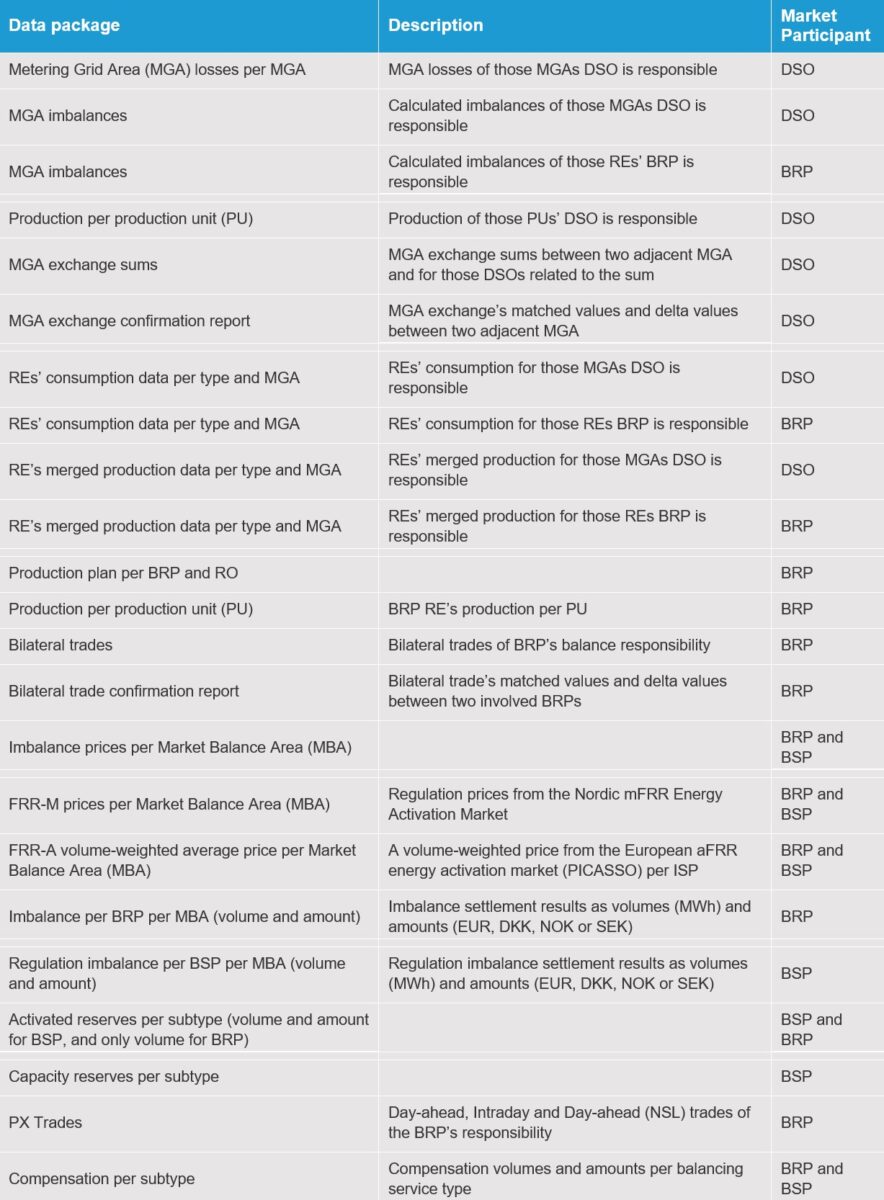
Table 31. Specific Data Packages
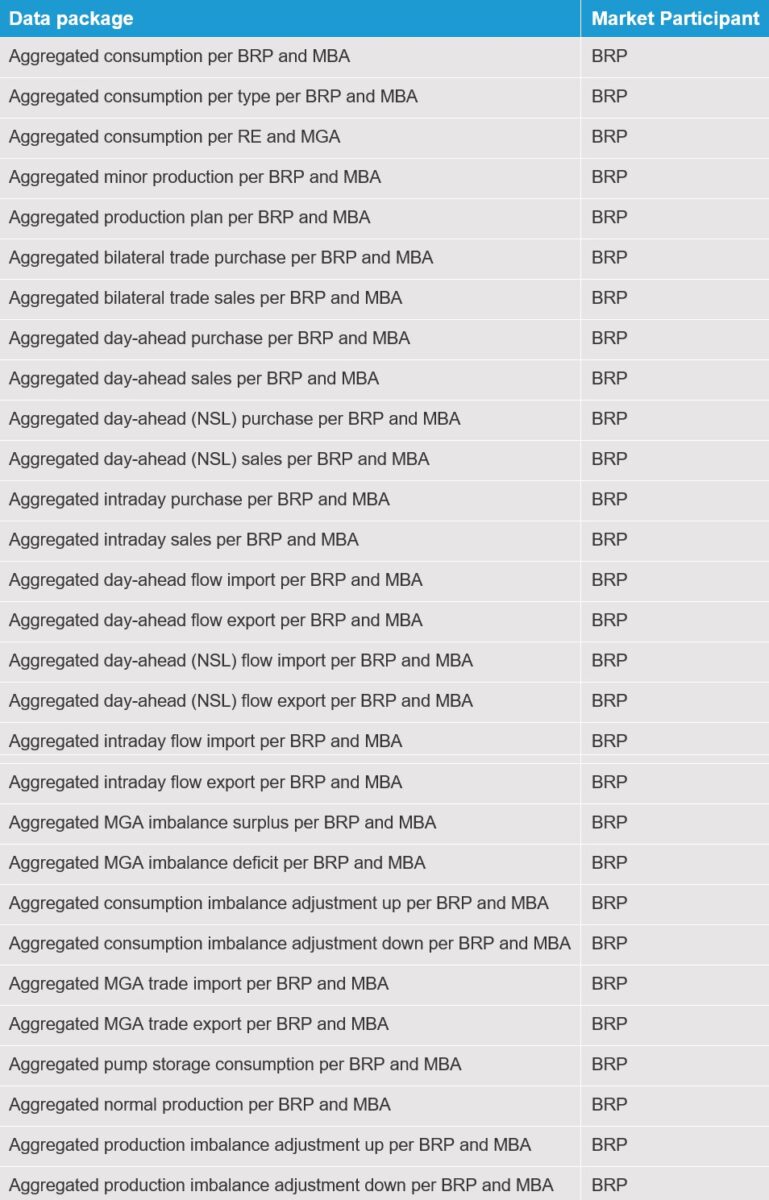
Table 32. Generic Data Packages
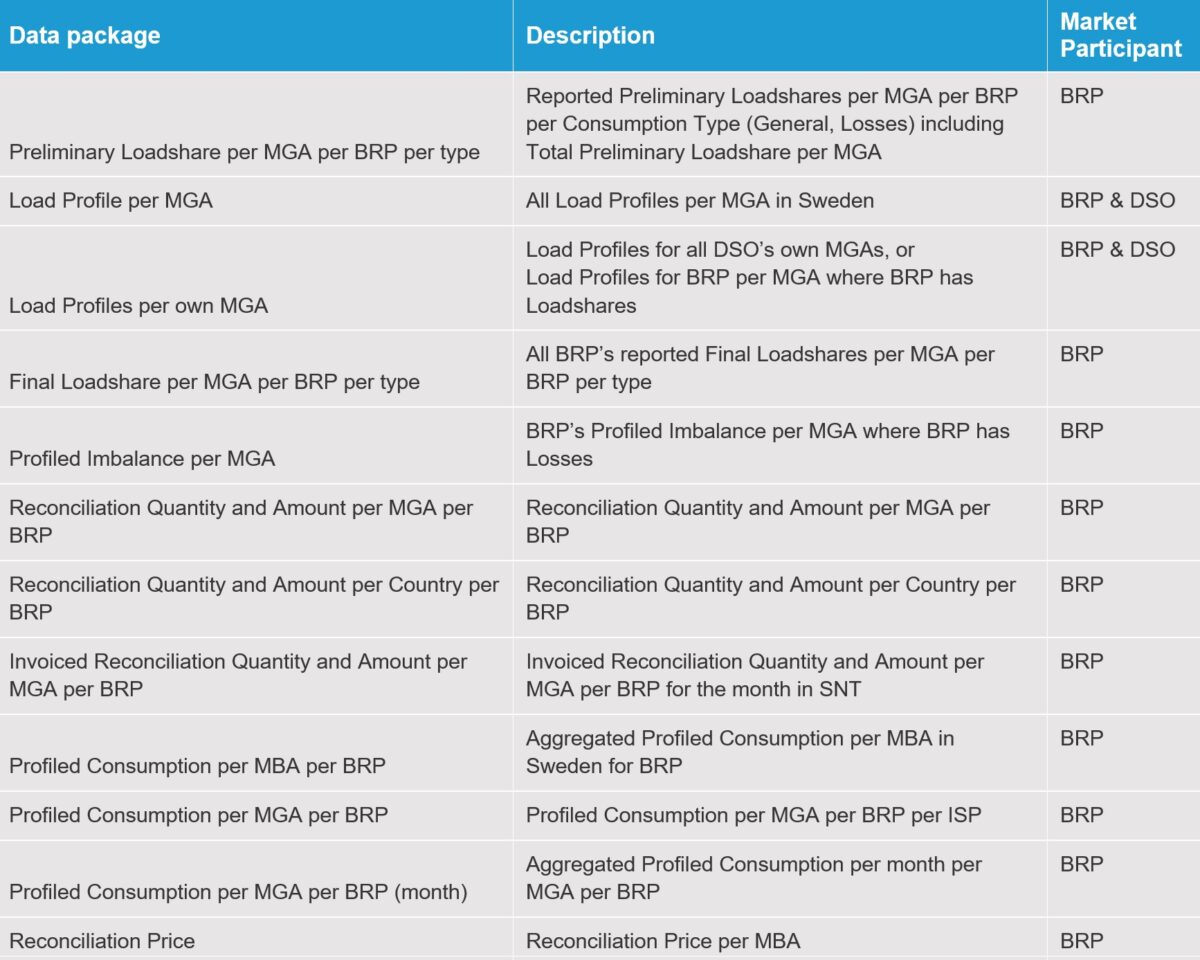
Table 33. UTILTS Data Packages for Swedish profiling and reconciliation.
eSett gives market participants the possibility to retrieve settlement data (time series data) from an Information Service. The Information Service is established as a system-to-system connection between market participant and eSett.
The service is established as a web service, which provides the possibility for data requesting and transfer but also capabilities for information security; secure connection between two system and tools for market participant’s authentication and authorisation. If the market participant wants to use the Information Service, it needs to set up the connection with eSett.
The market participants must first be authorised to use the Information Service. After authorisation a market participant can fetch time series data through the Information Service. Market participant can only fetch data that the party is entitled to view, as instructed in the regulations.
The market participant’s IT system can send a request for MEC data to the Information Service in order to receive it. A market participant can for example order following MEC data: detailed production plans, detailed reserves data, settlement data, settlement results or imbalance prices. The Information Service provides the requested data to market participant’s system if the requested data is available.
The information that can be received via the Information Service is shown in Table 34.

Table 34. Available information service tasks per market participant.
Detailed information regarding the Information Service interface and the supported data flows can be found in the Communication Guidelines, published on eSett’s web page (https://www.esett.com/customers/data-communications/)
The common file format syntax will be based on ENTSO-E and ebIX ®. Definition of the utilized file format is specified in the document “A market model for data exchange, Business Requirement Specification for Data Exchange in NBS (BRS). The focus of the BRSs for the Nordic Balancing System is the business aspects of the document exchanges. The latest version of the document can be found at: https://ediel.org/.
Market participants responsible for reporting data to eSett are obliged to use the common standard, as stated in section 5.1 Reporting requirements.
The TSOs have prepared a user guide for NBS. The User Guide for XML documents for NBS is a detailed User Guide for the ENTSO-E and ebIX® XML documents used in the Nordic Balancing System. The focus of the document is the technical aspects of the documents to be exchanged. In addition, NMEG has also prepared a document with XML schemas and examples. The latest version of the documents can be found at https://ediel.org/.
Communication towards eSett can be encrypted or non-encrypted and towards market parties it is configured based on capabilities of receiving party. The supported protocols (WS, SFTP, SMTP) allow authentication and encryption of the data exchange using either TLS or SSH. The process of authentication and encryption is completely controlled by the transport technology (and underlying libraries), the security information (username/password) are passed to these technologies by means of specific configuration. In Sweden, TLS encryption is required when settlement data is sent to eSett.
On the sender’s Endpoint each new message is encrypted using a uniquely key generated by symmetric cryptography (session key), the used key bit-length is obtained from the configuration. The session key is encrypted using X.509 public key of recipient Endpoint. The Message Encryptor obtains the X.509 public key from the Component Directory. The encrypted session key is transported together with the message from the sender Endpoint to the recipient Endpoint.
On the recipient Endpoint the session key is decrypted using X.509 private key of the recipient Endpoint. The Message Encryptor obtains the X.509 private key from its local keystore. The message payload is decrypted with the decrypted session key.
As the symmetric cipher, the AES algorithm is used. The supported key sizes are 128, 192, and 256 bits. The used symmetric cryptography key size can be set differently on each Endpoint in its configuration. ECP uses 2048-bit length keys for asymmetric cryptography.
The market participant is required to use one single coding scheme per country towards eSett in all communication. This can be for example EIC, GS1 codes or a code based on a national scheme. If a market participant is active only in a one country it can use the national coding scheme, but if market participant is active in more than one country it has to use EIC or GS1. If market participant is active in Norway, a Norwegian GS1 (GLN) code must be used. Detailed communication coding schemes are described in the BRS, which can be found at https://ediel.org/.
As stated in the chapter 3.2.1 for unbundling reasons the retailer and distribution system operator businesses are separated to own companies and it is necessary to model them as two separate companies also in NBS model and eSett´s imbalance settlement system. Consequently, these companies cannot utilize same market participant codes.
For messaging and data exchange purposes a coding scheme and market participant code will be determined for each market participant role.
In Norway and Sweden, the same market participant code can be used for RE, BRP and BSP roles that are connected to the same company. If there’s a DSO role connected to the same company, it needs to use different market participant code for that role.
In case of service providers, it is defined for which market participants the service provider provides the imbalance settlement services. When service provider sends messages to eSett (as a service to its customer) it will use the market participant codes based on its customers’ role and not service provider’s own code.
In Finland, the same national market participant code can be used for roles that are connected to the same Company. E.g., a balance responsible company in Finland can use the same national market participant code for its BRP, BSP and RE roles as well as for its DSO role for its non-concessional grids (e.g. production metering grid areas). However, with GS1 (GLN) codes, the DSO role needs to have its own unique code, while BRP, BSP and RE may still use same code if they are connected to the same company.
Fingrid is a responsible issuing body for giving national and EIC coding schemes for the market participants and GS1 Finland Oy is an issuing body for giving GS1 coding scheme in Finland. In a situation where a Finnish market participant is active in more than one country in NBS the Finnish market participant has to use either EIC or GS1. Additionally, the Finnish Datahub requires that market participants in Finland have to use GS1 (GLN) codes unless they are outside the scope of the Datahub.
All Danish Market participants have a GLN code, and this is the only possible for DSOs and Retailers. BRP’s and BSPs are allowed to use EIC codes as well. In Denmark, the same market participant code can be used for RE and BRP roles that are connected to the same company.
Table 35 compiles the requirements for allowed coding schemes per type for each NBS country.
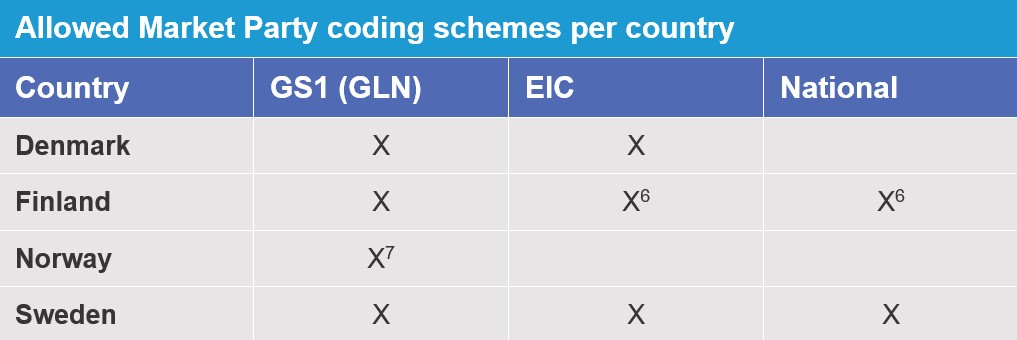
Table 35. Allowed market participant coding schemes per country.
4 Only for market participants outside of the scope of the Finnish Datahub. For example, a BRP or RE that has only trades, or a DSO with only a production grid and no connection to distribution or transmission grids.
5 A Norwegian GS1 (GLN) code must be used in Norway.
Open Data is eSett’s primary interface to other stakeholders than market participants. The Open Data can be accessed without a user account or authentication. The information provided there gives a basic knowledge about imbalance settlement and the companies involved in it.
The Open Data contains information presented in Table 36.
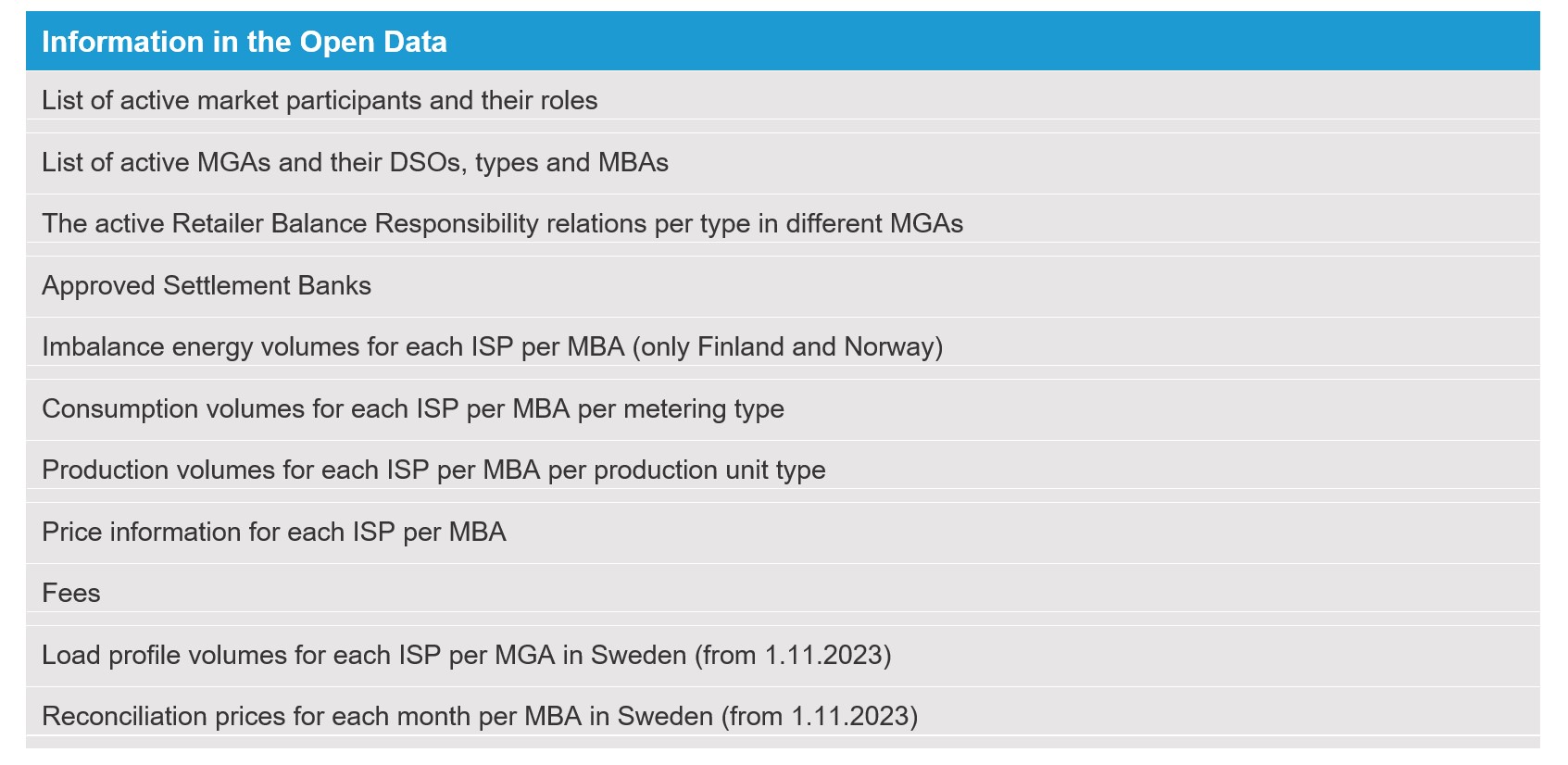
Table 36. Information in Open Data.
The Online Service is eSett’s main communication tool and primary interface to market participants. The Online Service requires login and contains settlement information that only the respective market participants can view.
Settlement information from the imbalance settlement IT system is published at the Online Service, so that market participants and authorized service providers can view and download the information they are entitled to see. The Online Service provides a functionality for update of structure information and upload of settlement data. The user is also able to monitor messaging related to the market participant.
The Online Service focuses on the needs of the companies (and market participants) that are involved in the imbalance settlement or balancing services and provide them with all the data that are included in their settlement. The market participants are able to have the complete overview of the imbalance settlement input and result, thus enabling them to perform a full verification over their entire settlement.
The market participants and their service providers are able to send and update information to eSett’s imbalance settlement IT system. This includes both time series and structure data. Functionality for management of their collaterals and invoice information is also provided and it is possible to download data in different forms. The tasks that market participants can perform in the Online Service are presented in Table 37.
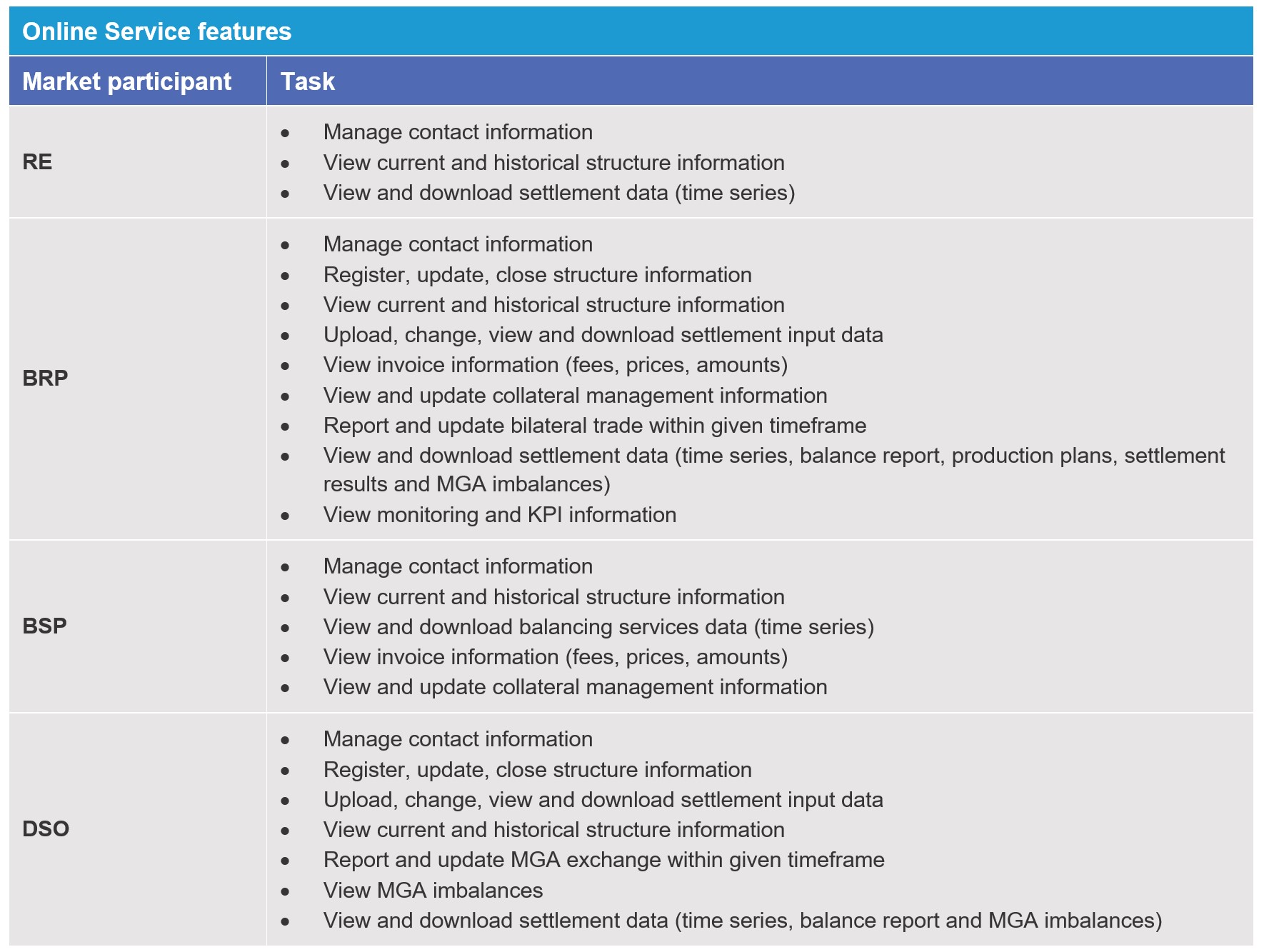
Table 37. Online Service features for market participants.
eSett grants an initial right to use, i.e. access to, the Service. There are two types of Users in the Online Service:
- Online Service Administrator – user has access to User Management, Service Outsourcing and Company management user cases
- Online Service User – user is a regular User of a company, having read and/or edit access to imbalance settlement related data including collaterals management
Each Online Service user must have a personal user account with login and password information to access the restricted part of the service. Upon first login, each user needs to read, accept and commit to comply with the Terms of Use.
The User(s) use the Service at his own risk and shall be liable for all use in the Service under his username and password and for the use conforming to the Terms of Use. The User shall keep the username and password confidential.
In accordance with the applicable legislation, shall the User use the Service in good faith and always comply with good business practices.
The User agrees not to use the Service for sending or forwarding any material, which is contrary to law or good practice, to incite this or to promote it. The User may not disclose information published in the Service to any third party. The User is responsible for acquiring and maintaining all hardware, software and data communications connections required by his/her use of the Service as well as for other expenses caused by the use of the Service. Furthermore, it is the User´s sole responsibility to ensure a proper and secure configuration of its connection to the Service.
The User shall be fully liable for damage or loss inflicted on eSett, other Users and third parties as a result of non-compliance of the Terms of Use, any applicable law or good business practices.
Each company (or market participant) has to have an Online Service administrator. The administrator user has access to User Management, Service Outsourcing and Company management user cases as well as read and edit access to all market parties and functionalities related to the user’s company.
eSett will give user rights to the company’s Online Service Administrator. The Online Service Administrator is responsible for granting access and maintaining Online Service User accounts of other Users in the company that the Online Service Administrator represents. The Online Service Administrator ensures that access is only given to persons who have a legitimate, work-related need for using the Service. The Online Service Administrator and Online Service User are also responsible for ensuring the confidentiality of their accounts and password.
Online Service Administrator has an obligation to deactivate Online Service User accounts that are no longer needed due to termination of employment of a User, or other similar reasons.
eSett may also maintain the userbase by ensuring that users who no longer use the system will eventually be removed based on a predefined cycle. Users with an expired password shall be changed from active to inactive status after four (4) months’ time. Users who have had the inactive status for three (3) months may be deleted automatically. Online Service Administrators can reactivate users with inactive status in the Online Service.
The administrator from the company creates the following users in the Online Service. The following information is required for a user account:
- Name
- Contact information (e-mail, phone number for SMS authentication)
- Company
- Online Service user access rights
Online Service Administrator assigns the correct roles and access rights.
After the user account is created and activated, an automatic invitation is sent to the new Online Service user.
The User(s) has access only to data of market participants registered under their company or only to data of market participants served by their company as a service provider. The use of the Service is protected by a user account with username and password requiring a two factor authentication.
The access rights to the settlement information are strictly regulated by the Nordic regulators and the IT system’s access management supports the regulation on this point. Following access rights are defined:
- Primary Access Right – access right to market parties of the user’s company.
- Secondary Access Right – access right to market parties that the user’s company provides services to. These are relevant only for users of service provider companies.
The access rights are connected to the following marked party groups:
- Market Activity Group – BRP, BSP and RE MPs.
- Grid Activity Group – DSO MPs.
Due to the unbundling rule, a user is only allowed to switch between marked parties within one marked party group after logging in.
- On user level it is decided whether the user has only read or read and write rights.
User role allows user to give access to predefined sets of functionalities of the Online Service. A market party can have service providers linked to these different roles.
- Market Role: Allows the user to use functionalities related settlement structures and MECs of one market party.
- Collateral Role: Allows the user to use functionalities related to bank accounts and collateral deposits.
- Invoice Role: Allows user to use functionalities related to invoices.
- External interface role: Allows the users to insert messages directly into the service
The example in Table 38 shows what settlement information regarding MGAs the BRPs, DSOs and REs can view and update in the NBS model.
The example in based on the assumption that:
- BRP1 is a BRP for
- RE1 consumption in MGA1
- RE2 production in MGA1
- RE3 losses in MGA1
- BRP1 imbalance in MGA1
- RE2 consumption in MGA2
- BRP1 (as a RE) consumption in MGA2
- BRP2 is a BRP for
- RE4 production in MGA2
- RE5 losses in MGA2
- BRP2 imbalance in MGA2
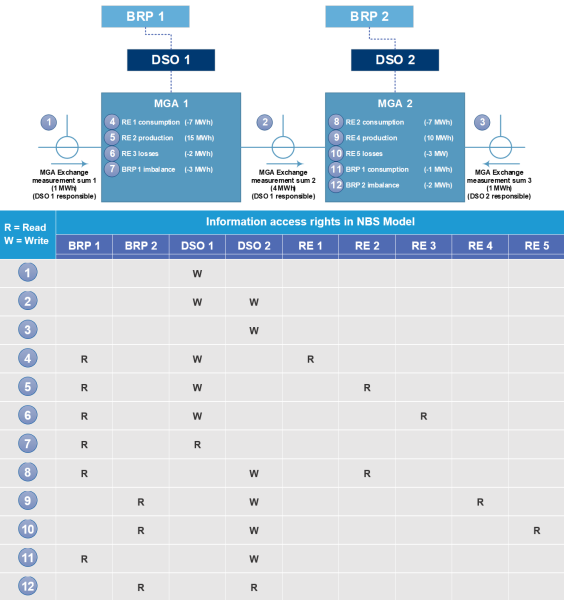
Table 38. Example of information access rights in the NBS model.
eSett provides both public and restricted reports in accordance with the reporting responsibility. The market participants can also order so called data packages from eSett. The subscriptions are managed through the online service.
Most data packages contain data from D-14 to D-1, where D refers to current day. For some data packages, e.g. imbalance settlement results, there are four different versions of each data package:
- Preliminary (containing data from an open period)
- Final (containing data from a closed period)
- Invoiced (containing data from an invoice period)
- Corrected (with corrections done after invoicing)
Reports available for market participants are statistics report to externals, KPI reports, transparency reports, reports to regulators, financial reports and settlement data packages (presented above).
The reports are either one-time reports or regularly compiled and distributed reports. If the report is compiled and distributed regularly, eSett defines the frequency for that. Some of the reports are not stored in the system after they have been compiled. Report’s distribution channel can be; manual retrieval and/or distributed automatically (sent and/or published).
The monitoring of market (and market participant) behaviour is one of the tasks of eSett, for which there are three main objectives; firstly, to monitor that BRPs’ imbalances are kept as low as possible, secondly to monitor possible market abuse and thirdly to mitigate the counterpart risk which eSett has towards each of the BRP and BSP.
To perform above tasks eSett collects required settlement information and calculates key performance indicators (KPIs) which evaluate the market performance of different market participants (mainly BRPs and DSOs). After data is collected it is compiled and presented to the public in a transparent and equal way; by publishing a list of public KPIs and company specific KPIs, where market participants can see their KPI ranking in comparison to other market participants and the best performers.
Differences in national practices will be taken into account when analysing the KPIs. For example, the difference between automatic meter reading (AMR) and non-automated metering is taken into account in calculation of the KPIs, depending on the settlement structure.
Regulators, national TSOs and eSett work in collaboration to impose sanctions on BRPs who have systematic imbalances and DSOs who fail to deliver quality data within applied reporting time frames. If the performance is insufficient, eSett takes actions by dialogue with the respective market participant to investigate the reason and seek out possibilities for enhancement. If the dialogue ends in a state where the performance is still found unacceptable, other actions and possible sanctions can be placed for the market participants, for example termination of the imbalance settlement agreement in case of a BRP.
eSett is responsible for monitoring BRPs’ performance. In the monitoring process data is gathered for calculating KPIs and evaluating the BRPs’ and DSOs’ performance. eSett evaluates the outcome and identifies which market participants are underperforming, misusing their market power or conducting other unprofessional misbehaviour e.g. in the regulating power market.
If KPIs show that, for example, a certain BRP’s imbalance is constantly on an insufficient level, eSett can take action to terminate the imbalance settlement agreement of this BRP.
All KPIs are published at the Online Service for BRPs to review and compare their position with other participants on Country level.
KPIs are utilised to measure the performance of different market participants. KPIs are a transparent way to display how BRPs carry out their respective responsibilities. eSett will develop KPIs that are critical for TSO to follow up the market behaviour. In addition to these KPIs, eSett will develop in co-operation with Market Participants the KPIs that help the Market Participants to improve their performance and quality.
The following KPIs are presented:
- BRP Imbalance KPI Report – Country
- Visible only for BRPs who are operating in Norway or Sweden in that specific country
- Report includes results of all BRPs which are active in that specific country
- BRP Imbalance KPI Report – Own Data
- Visible for all BRPs
- Report includes results of BRP’s own data
- Advanced Settlement Report – Month
- Advanced Settlement Report – Week
- Production Plan KPI
- Visible only for BRPs who are operating in Finland, Norway or Sweden
- Report includes results of BRP’s own data
Each BRP has physical obligations and rights and has to achieve a planned balance between these (to trade into balance). BRPs without physical assets, are perceived to have a better control of their imbalances. Therefore, in Norway, Finland and Sweden such BRPs should be able to trade in a way that they don’t have any imbalances.
Monthly net imbalance should be near zero and thus not show a skewed distribution of positive and negative imbalances. As a result of the analysis the BRPs are classified into three categories – red, yellow and green. Based on the category (see Table 39) eSett will notify the BRP for not being in balance and TSO can impose actions towards a specific BRP in analysing the causes for imbalances and in finding the ways to enhance the index (i.e. to minimise imbalance volumes).

Table 39. Imbalance index categories.
Here below are presented all different formulas and threshold values which are used in different KPI reports:
- Imbalance Result formula:

- Relative Imbalance formula:

where Sales includes Intraday Trades, Day-ahead Trades and Bilateral Trades per BRP and MBA. - Imbalance Skewness formula:

- Imbalance Skewness for BRP:

- Formulas and threshold values for BRP Imbalance KPI colours:
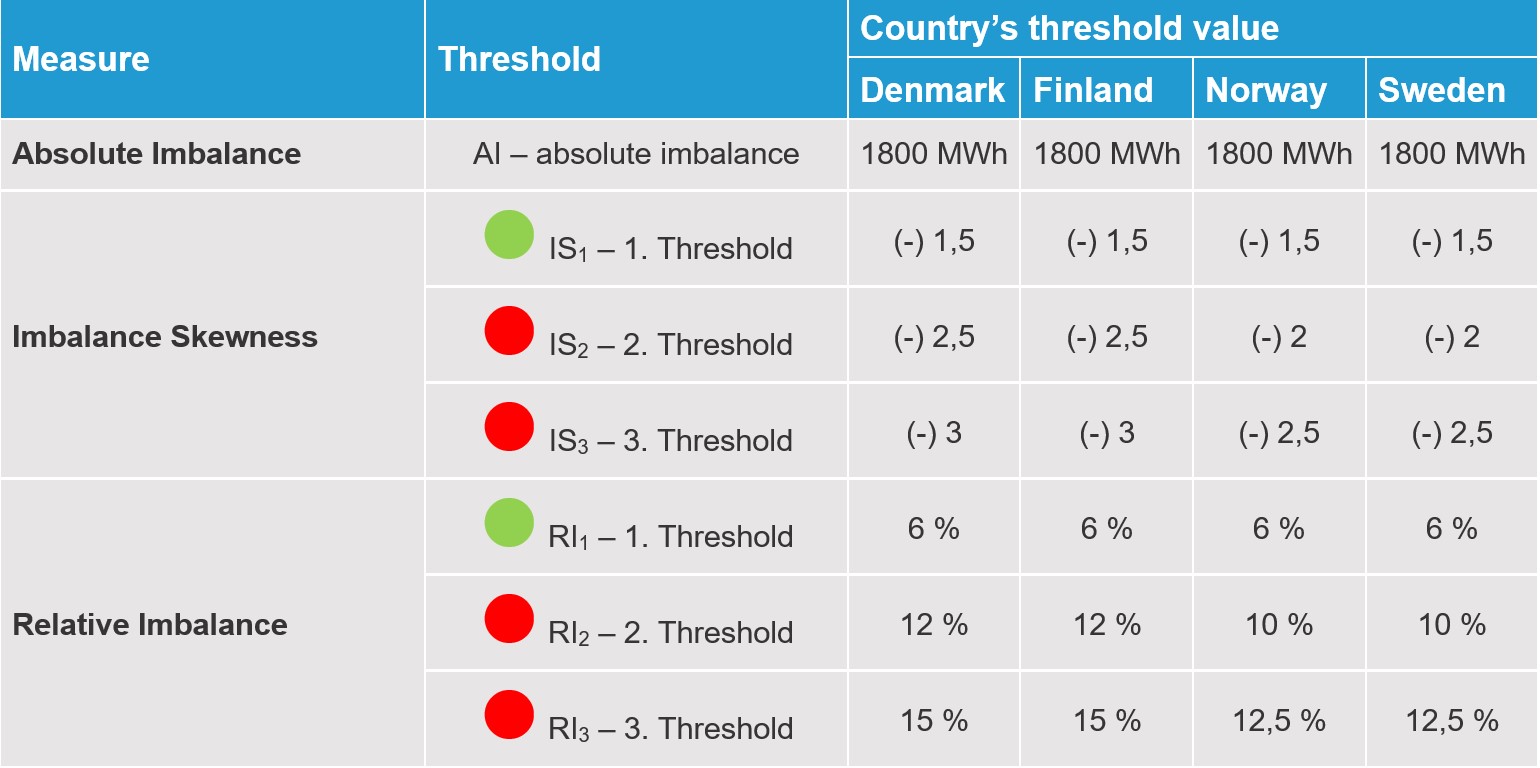
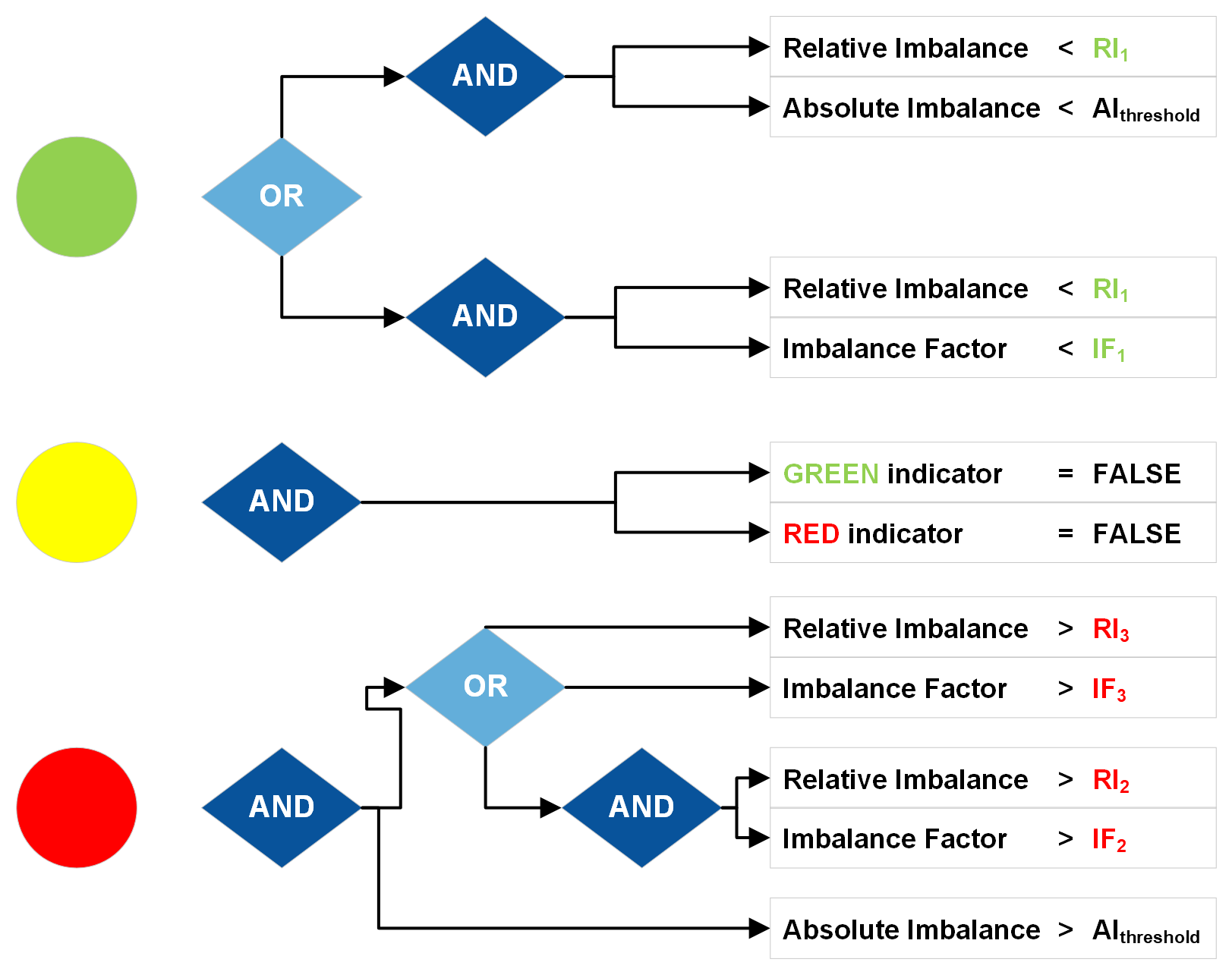
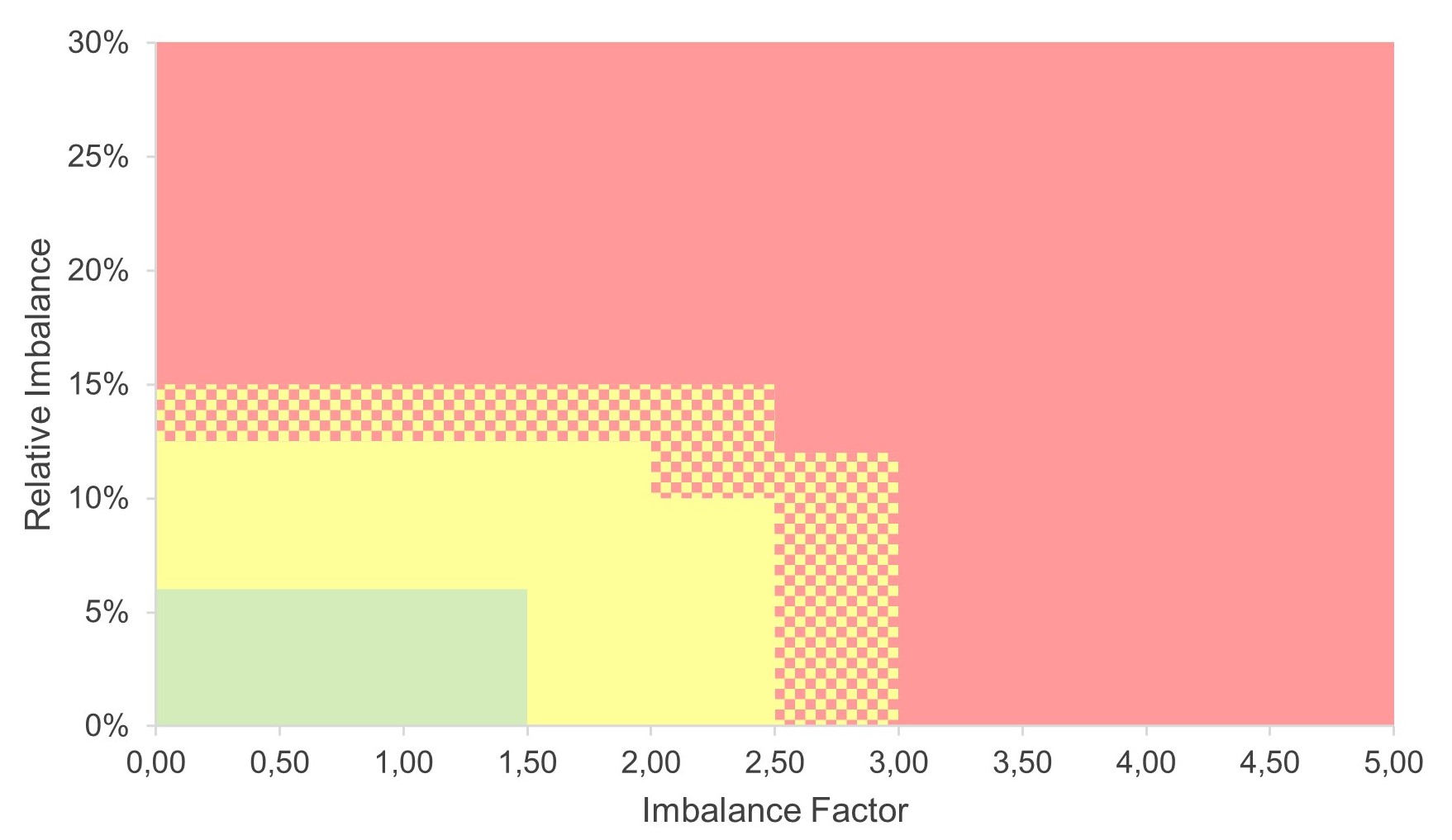
Figure 29. Graphical presentation of BRP Imbalance KPI colours if Absolute Imbalance exceeds the threshold.
- Production Plan KPI formula and threshold values for Production Plan KPI colours:

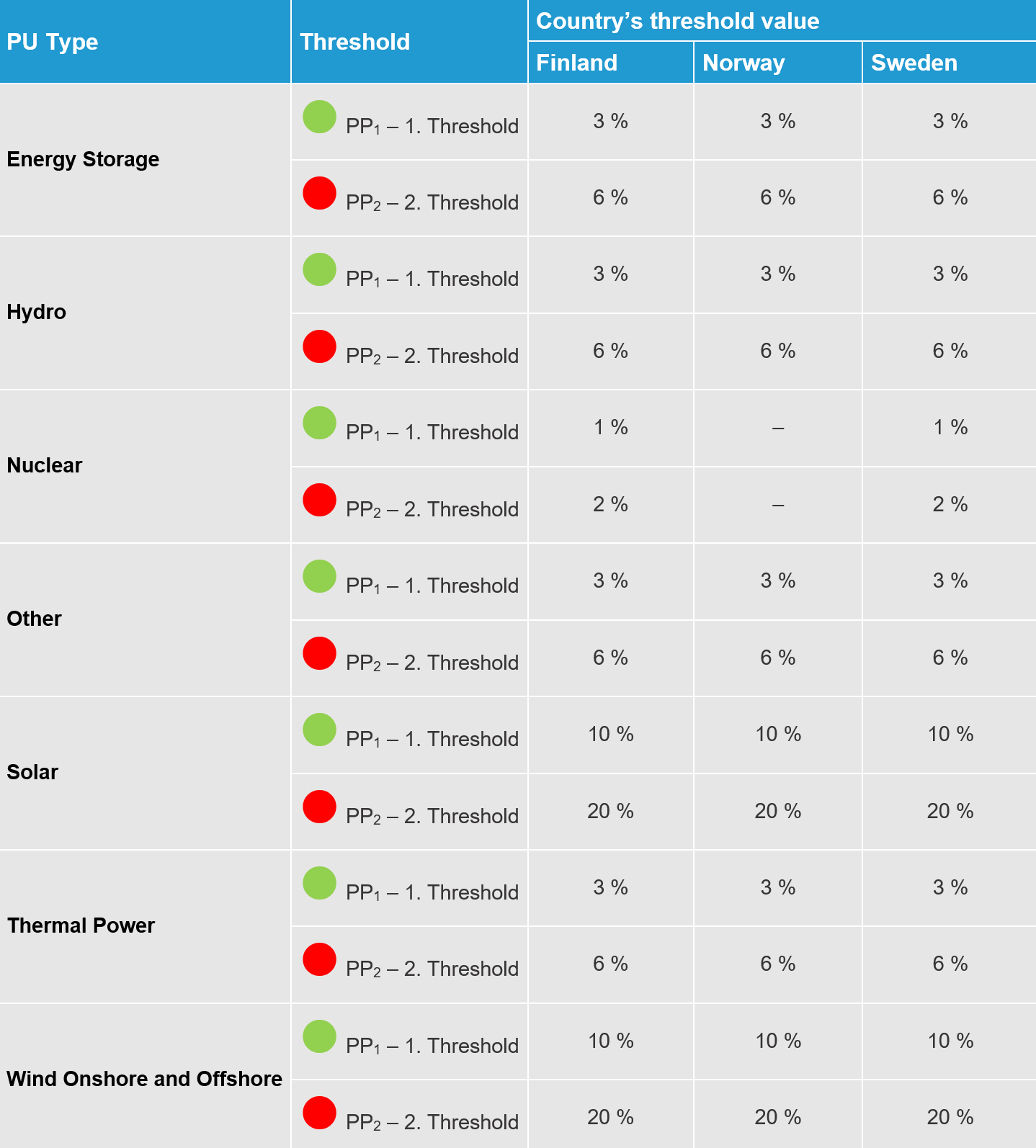
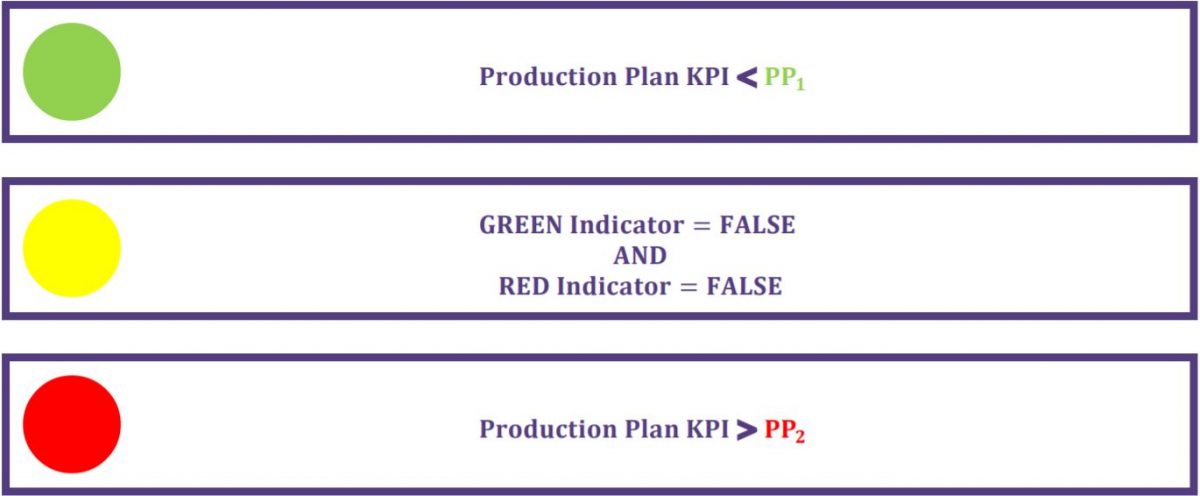
After the settlement period (week or month) has been finalized (final settlement is calculated), there will be created an advanced settlement report for each BRP. The report will summarize the BRP’s settlement data and results for the finalized settlement period on a national level and on all the BRP’s MBA-levels.
The BRPs are obliged to trade into balance, i.e. to minimize their imbalances and to have an even distribution of their imbalances.
Each month after the settlement period has been finalized (final settlement is calculated), the BRP’s Imbalance results and the predefined threshold limits are calculated per MBA for the previous month. Then the values are categorized as red, yellow or green, depending on how large and skewed the imbalances are. Report displays last 12 months data for finalized settlement period.
BRPs shall report plans per RO to the TSOs and they are also obliged to keep their plans updated, i.e. report updated values. TSOs also report binding production plans to eSett. The production plans are utilized in a key performance indicator.
As production plan is removed from imbalance calculations, a KPI report is established for monitoring of long-term quality of Production Plans. The report is available for BRPs to have an overview of Production Plan values reported for related Regulation Objects. The KPI report is defined per BRP, MBA and PU Type.
The Production Plan KPI report is not used for Denmark, as production plan values are not reported to eSett.
The main objective for BRPs is to stay in balance and keep their imbalances on a minimum level. For a BRP who has systematic imbalances it is possible to impose sanctions and finally terminate the contract. Bad data quality makes it difficult for BRPs to make dependable forecasts, which is why DSOs are being monitored by eSett. However it is not legally possible for any of the involved TSOs or eSett to impose sanctions on the DSOs. KPIs’ calculated by eSett are used by the national regulators to issue economic sanctions for those DSOs which do not live up to predefined minimum levels.
eSett therefore only has the possibility to initiate the termination of the contract between the BRP and eSett. The control process have three steps:
1. eSett evaluates the BRP performance with the help of the market surveillance data and KPIs
2. If the BRP performance is not at an acceptable level, eSett initiates a dialogue in order to investigate the reason and possibilities to enhance performance
3. TSOs and/or regulators can place sanctions on the BRP or the DSO
4. If the dialogue ends in a state where the BRP performance is still found too low, the process to terminate the imbalance settlement agreement is started
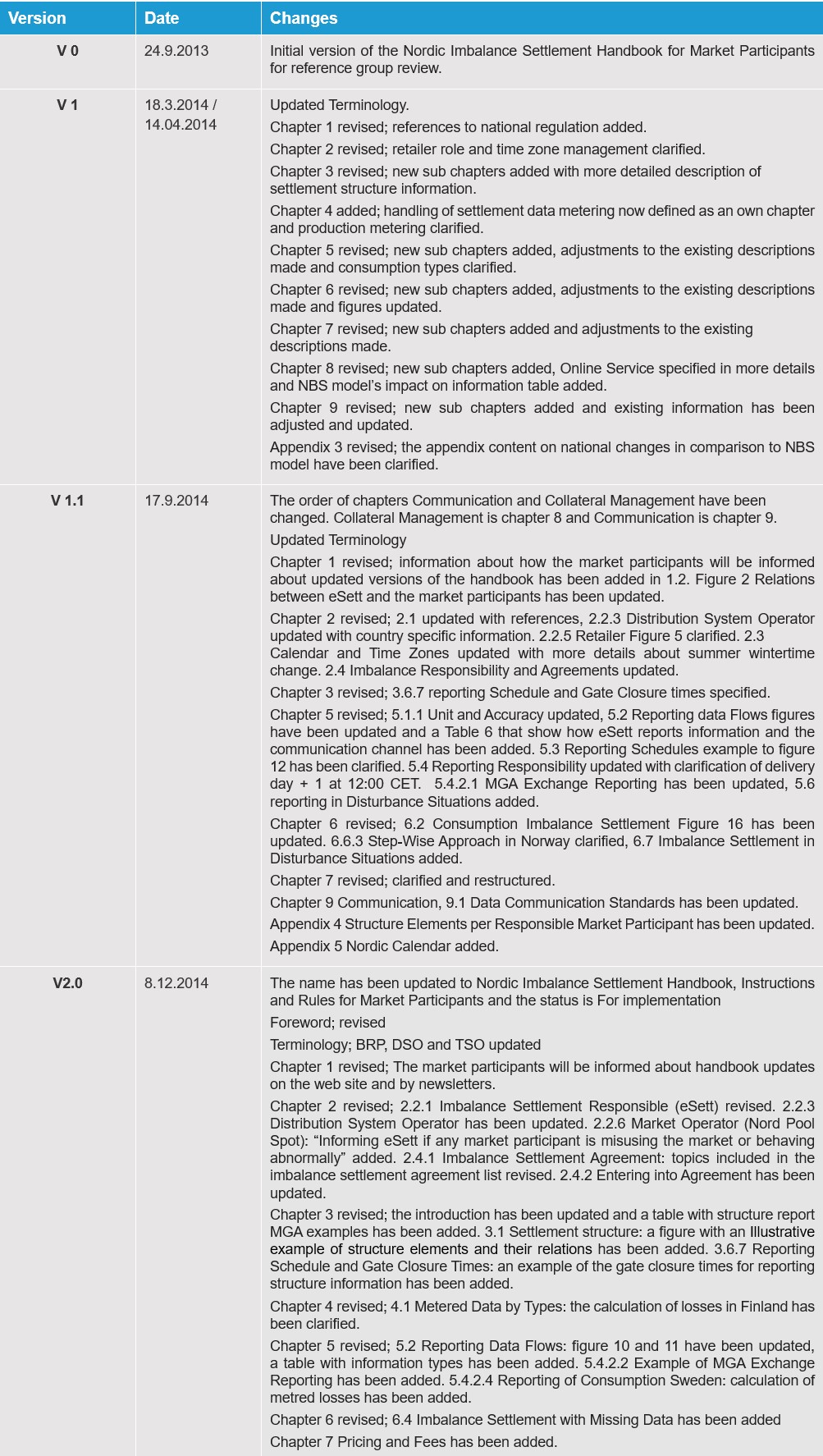
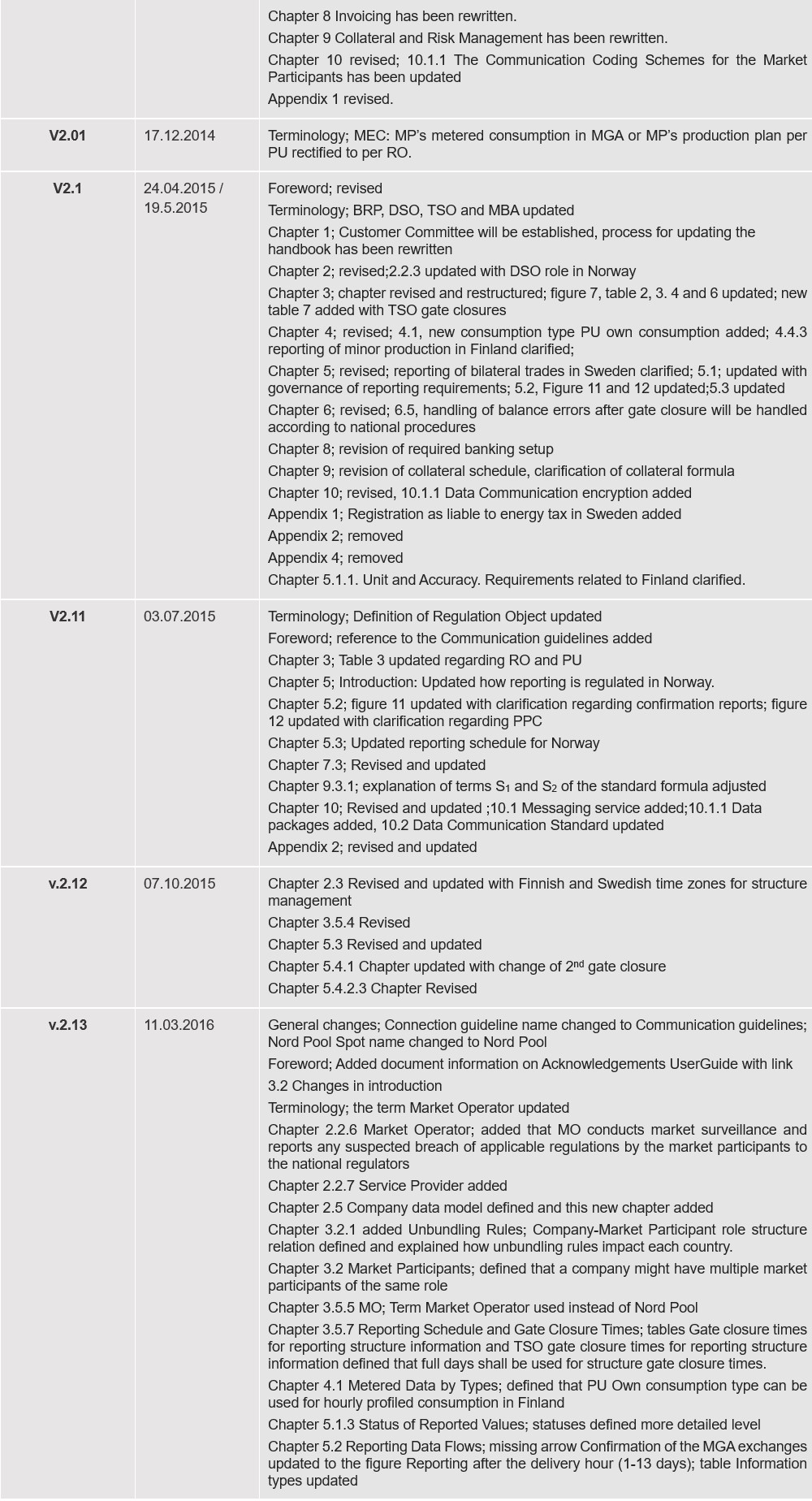
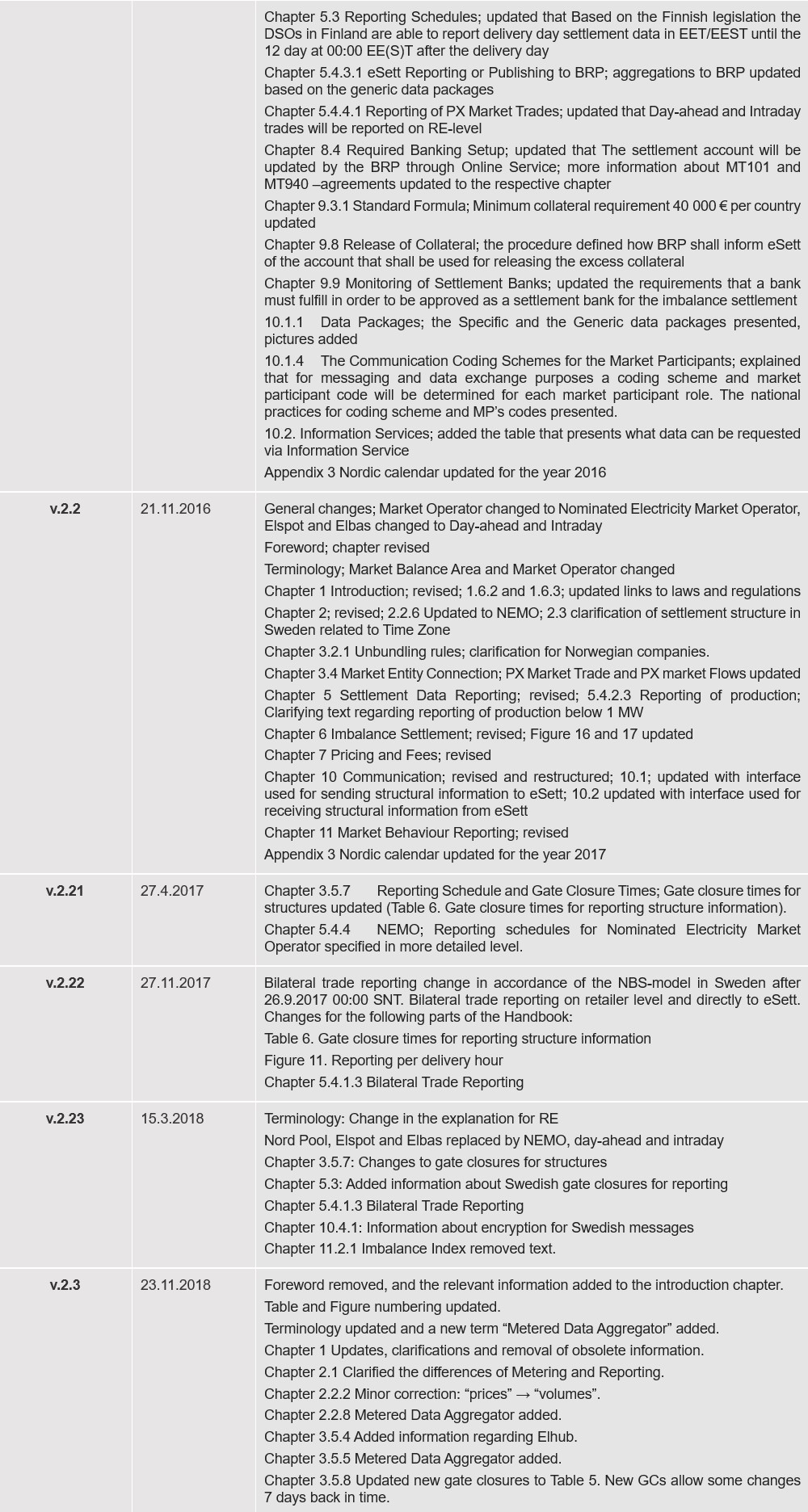
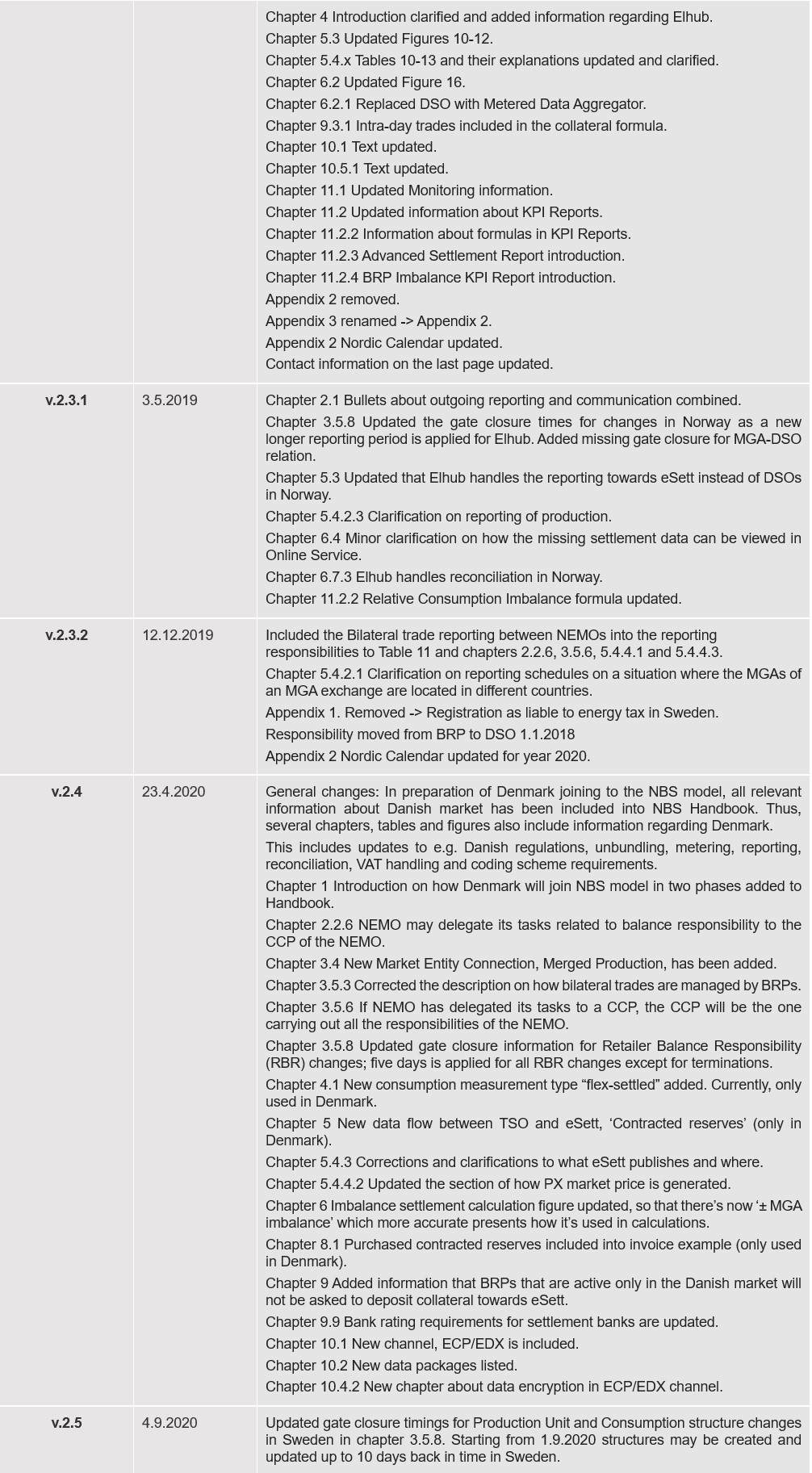
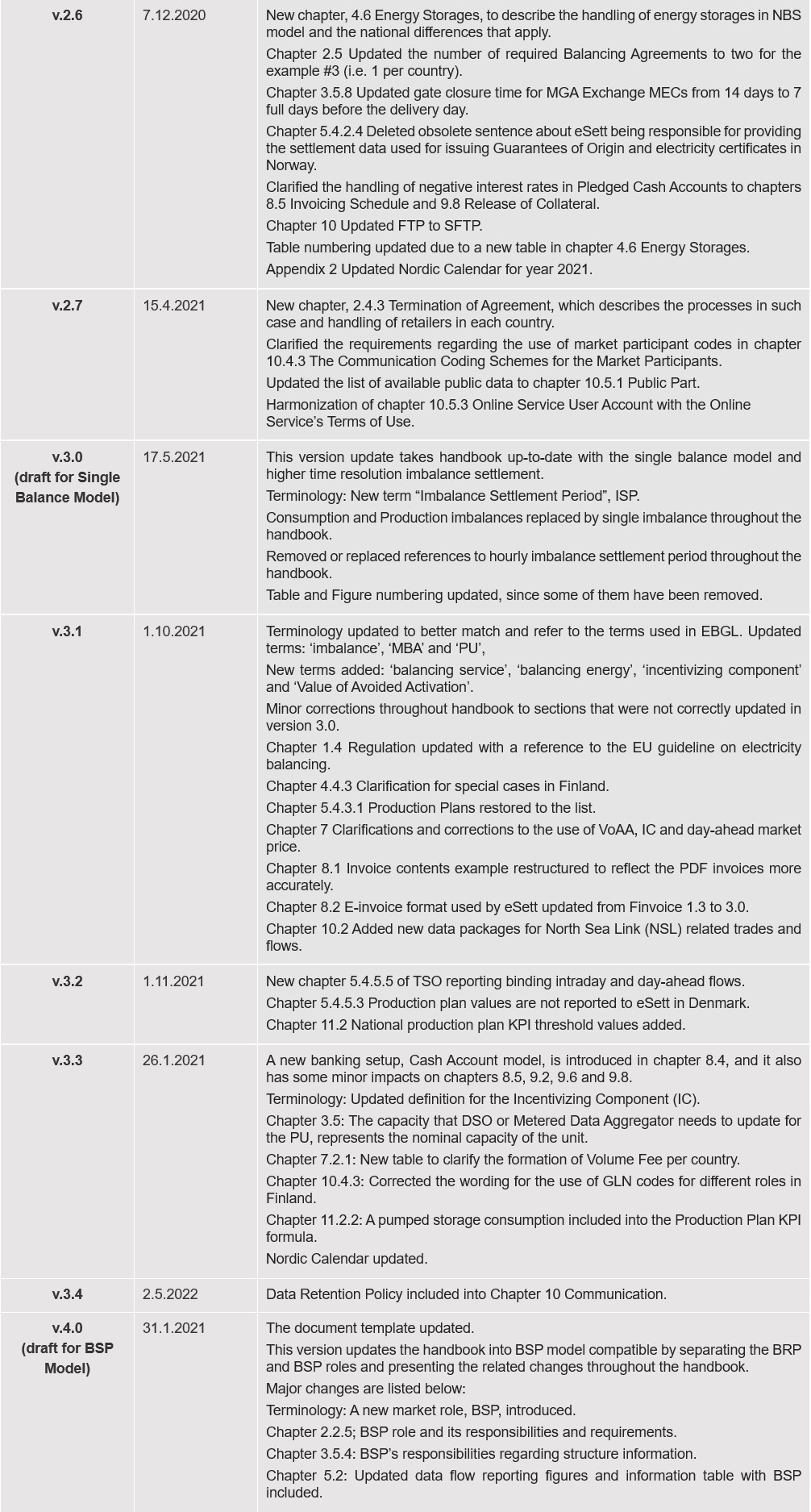
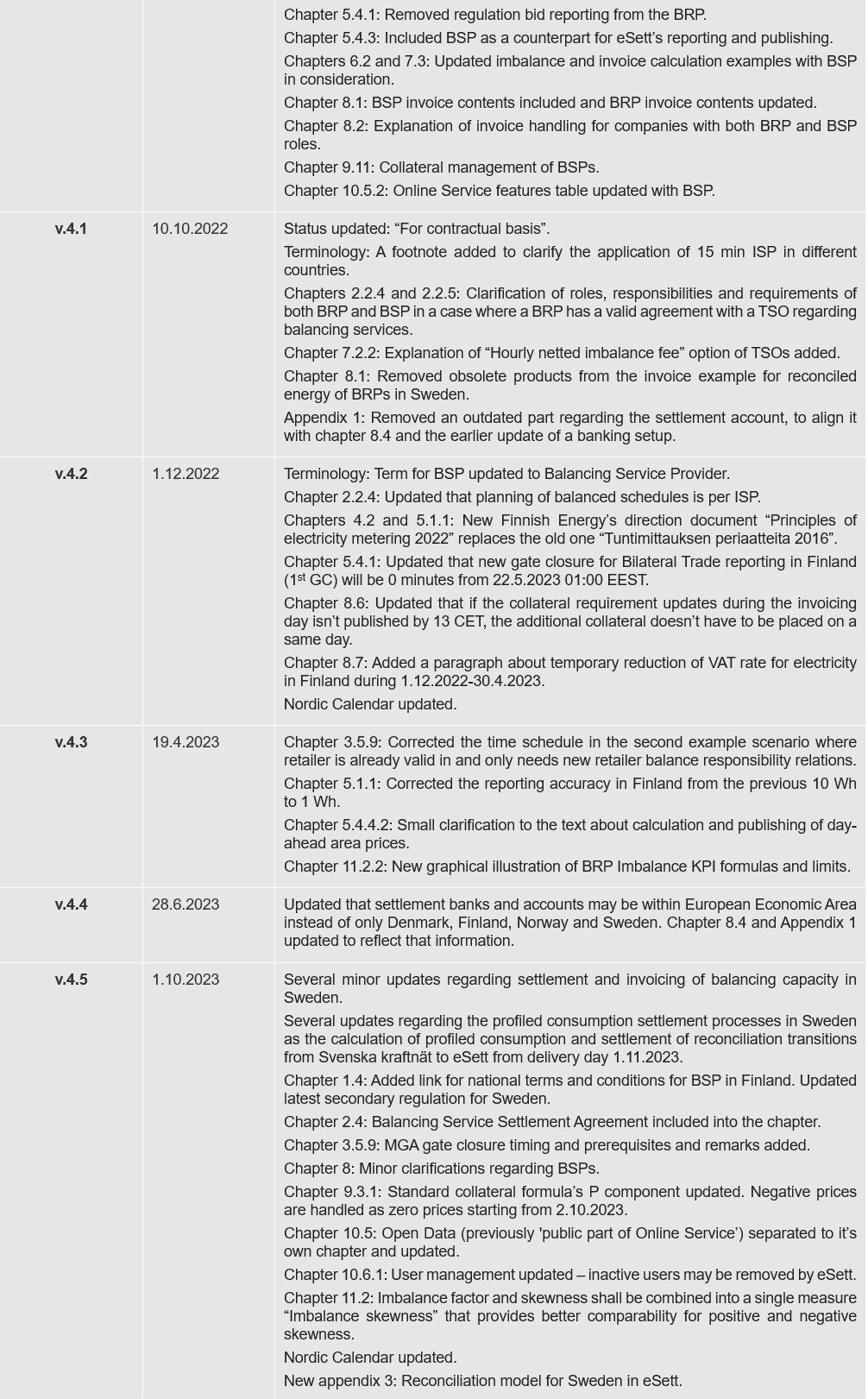
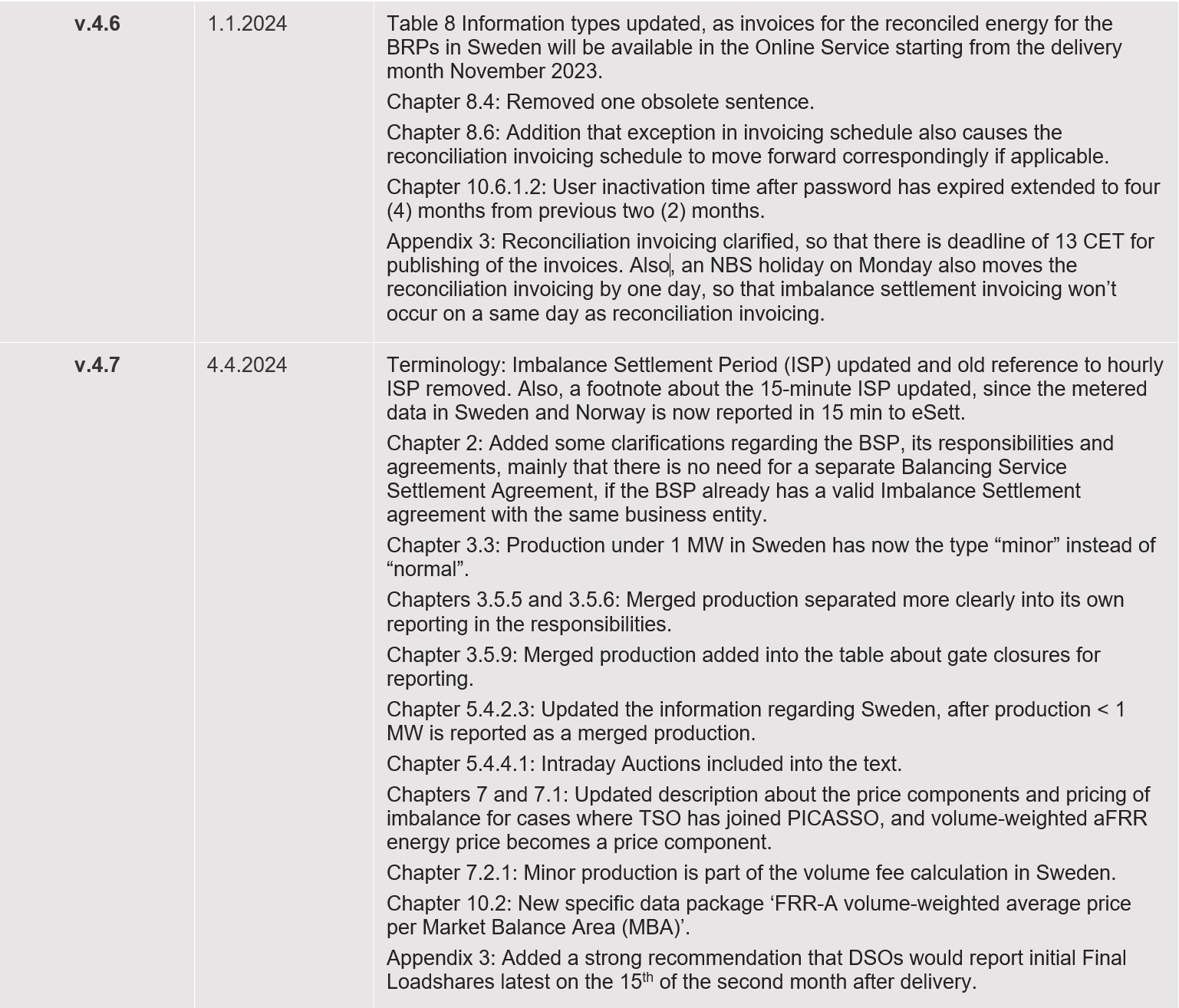

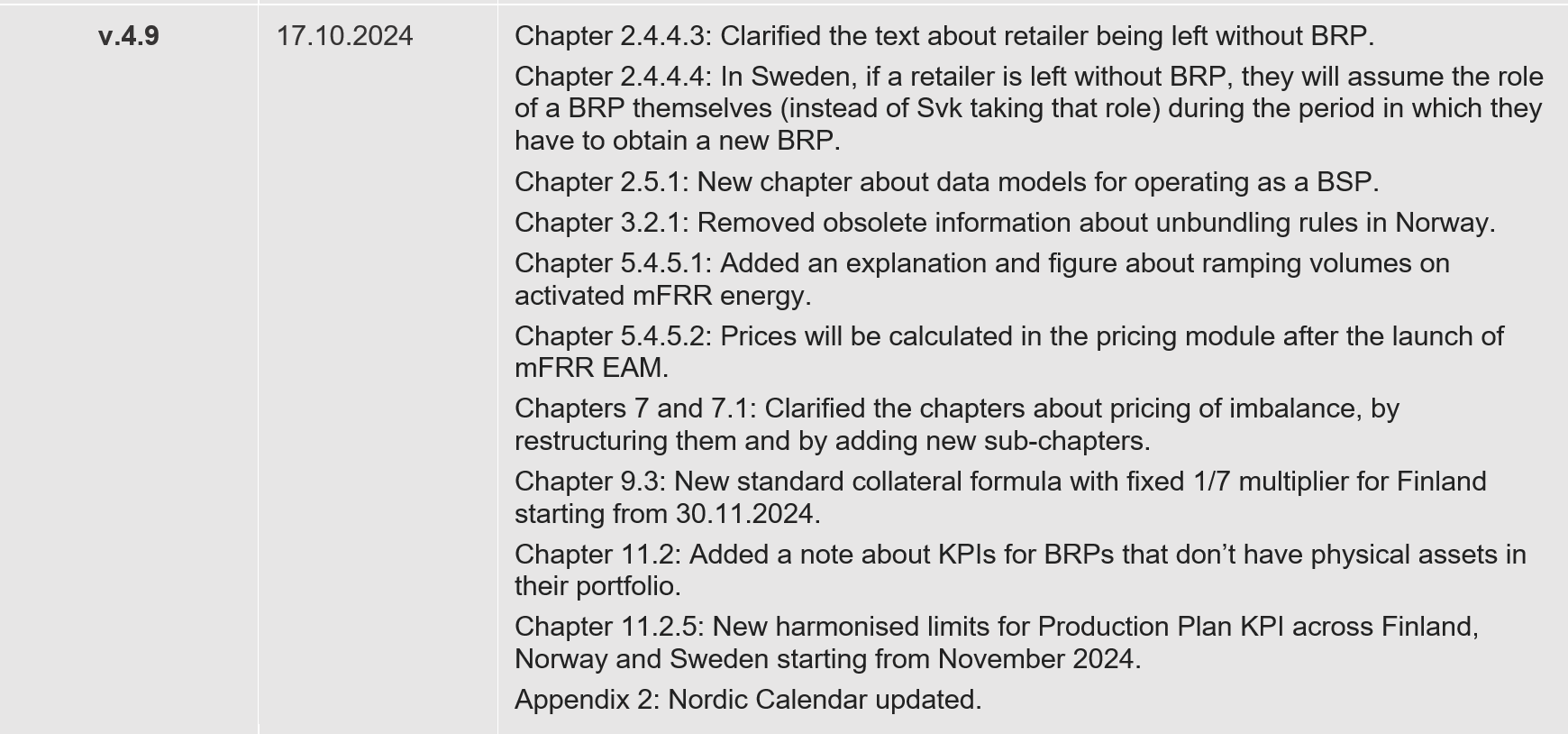
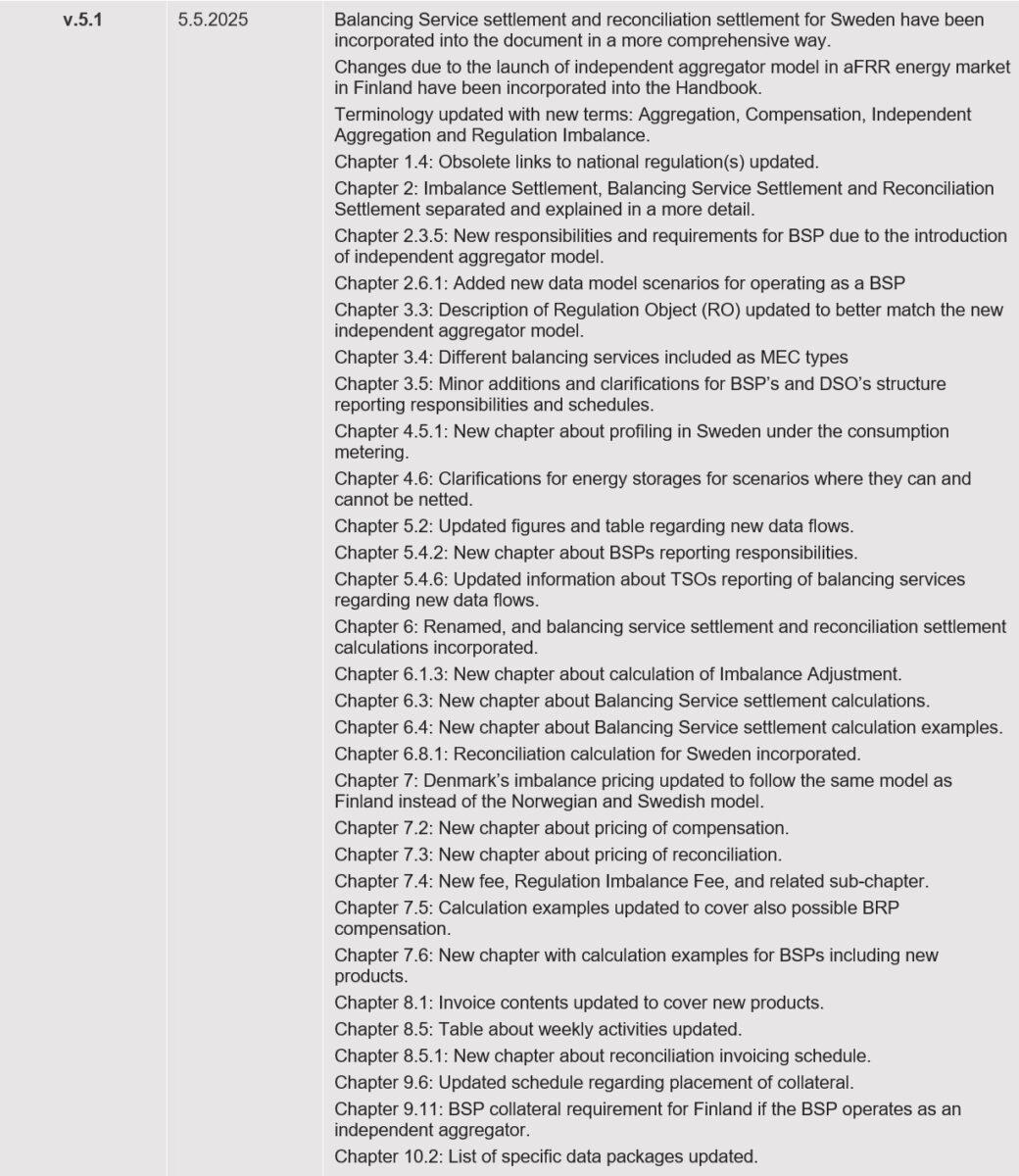
All Handbook appendices can be found at the end of the PDF versions of the Handbook.
